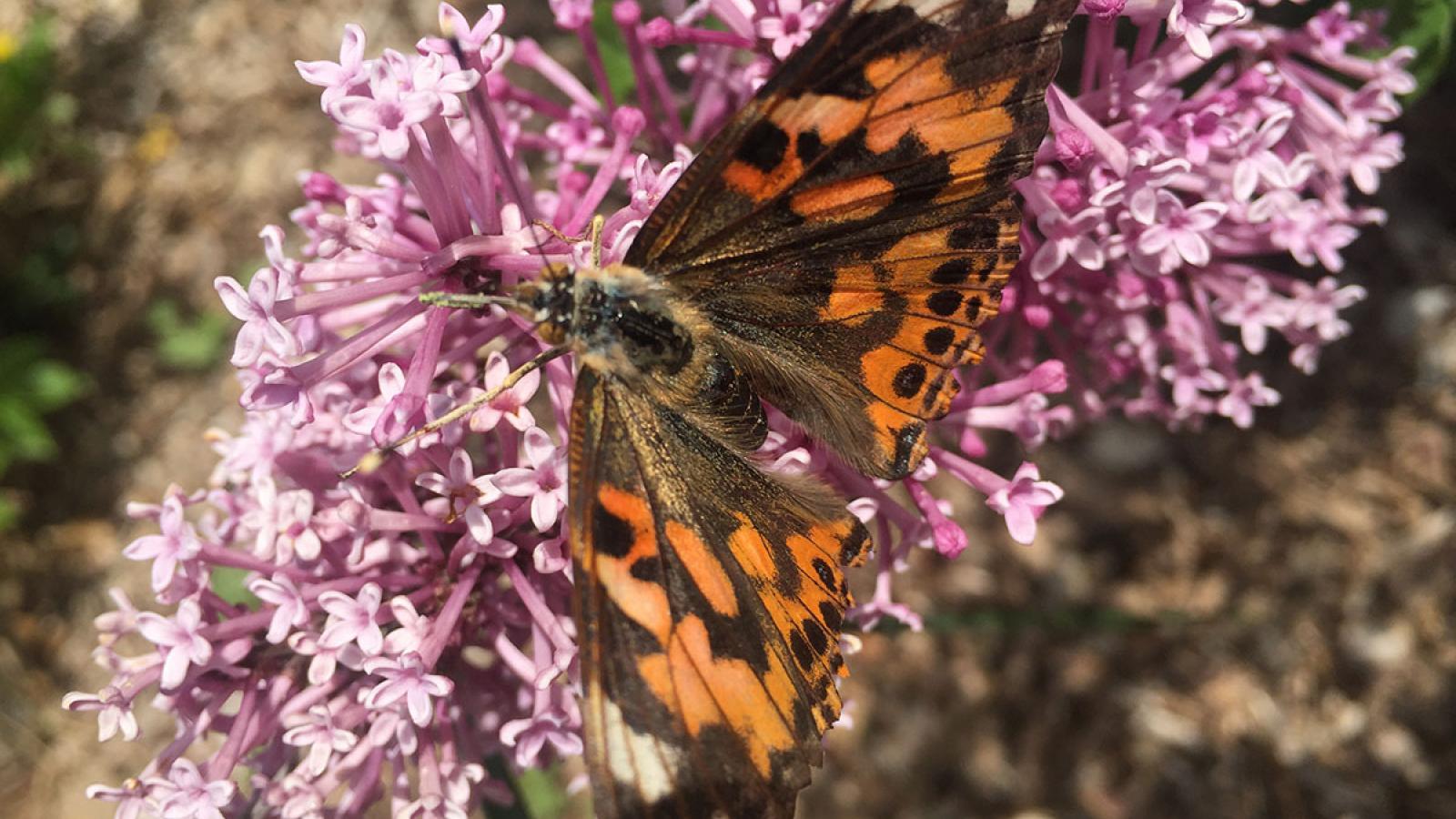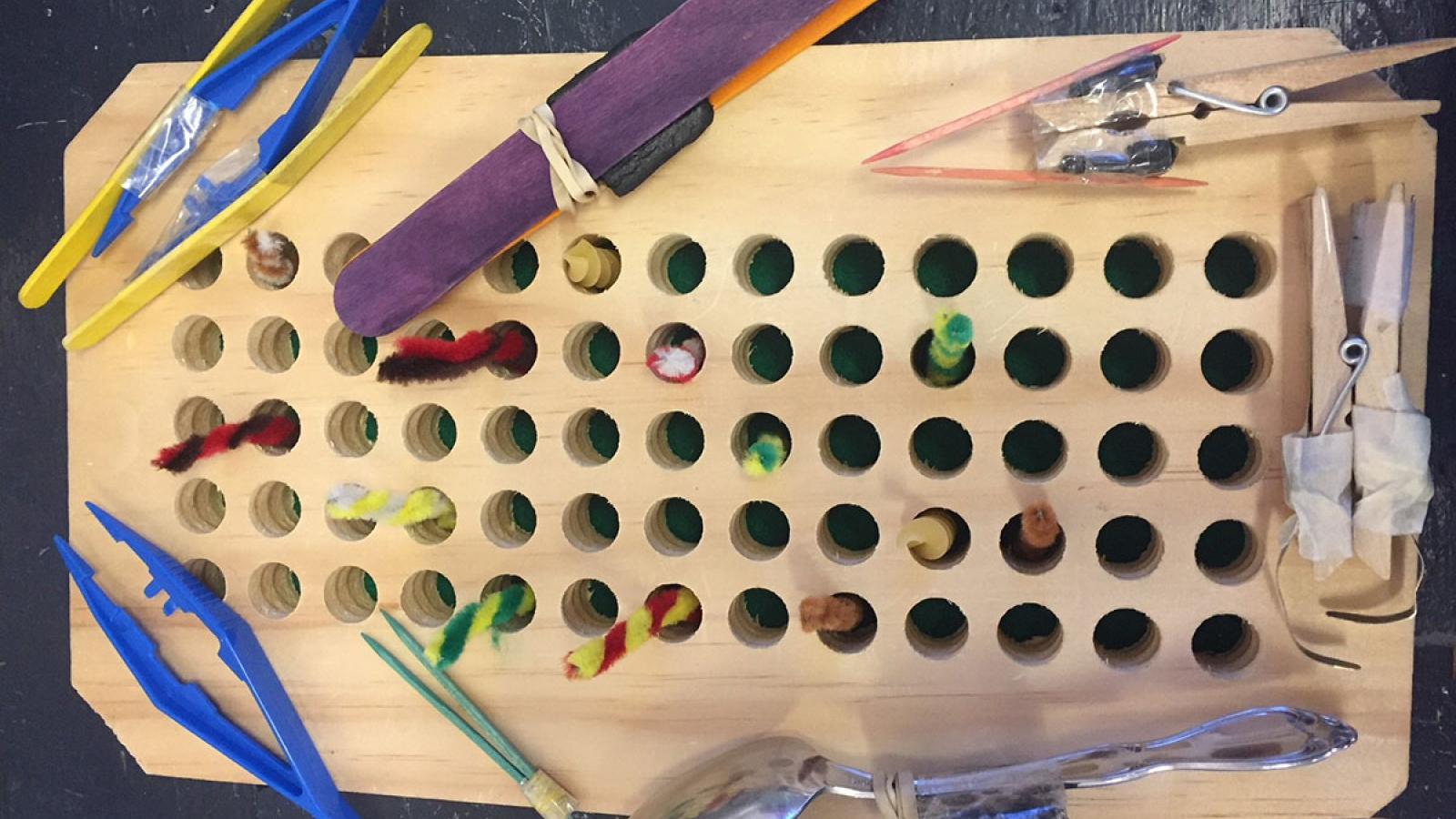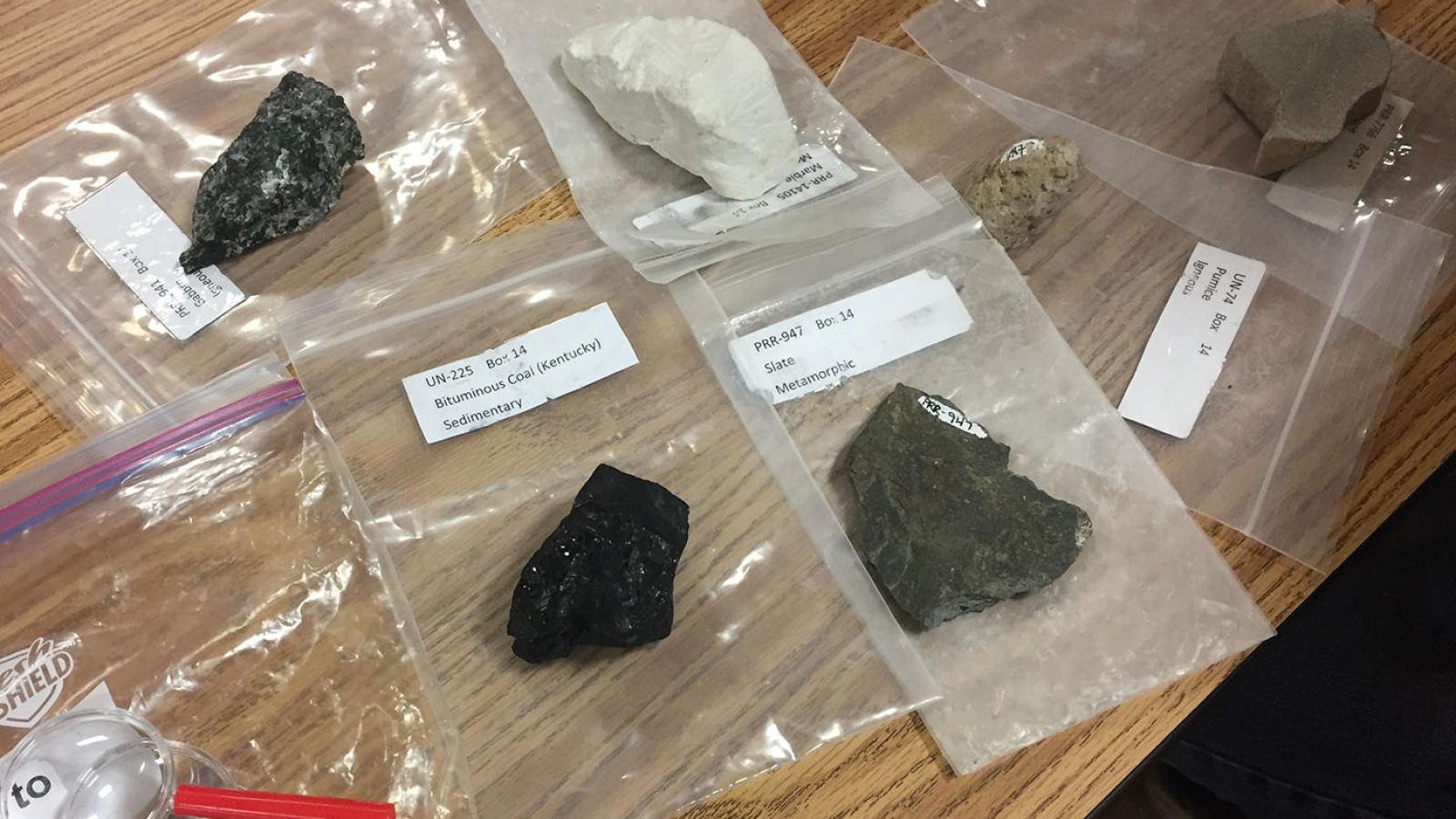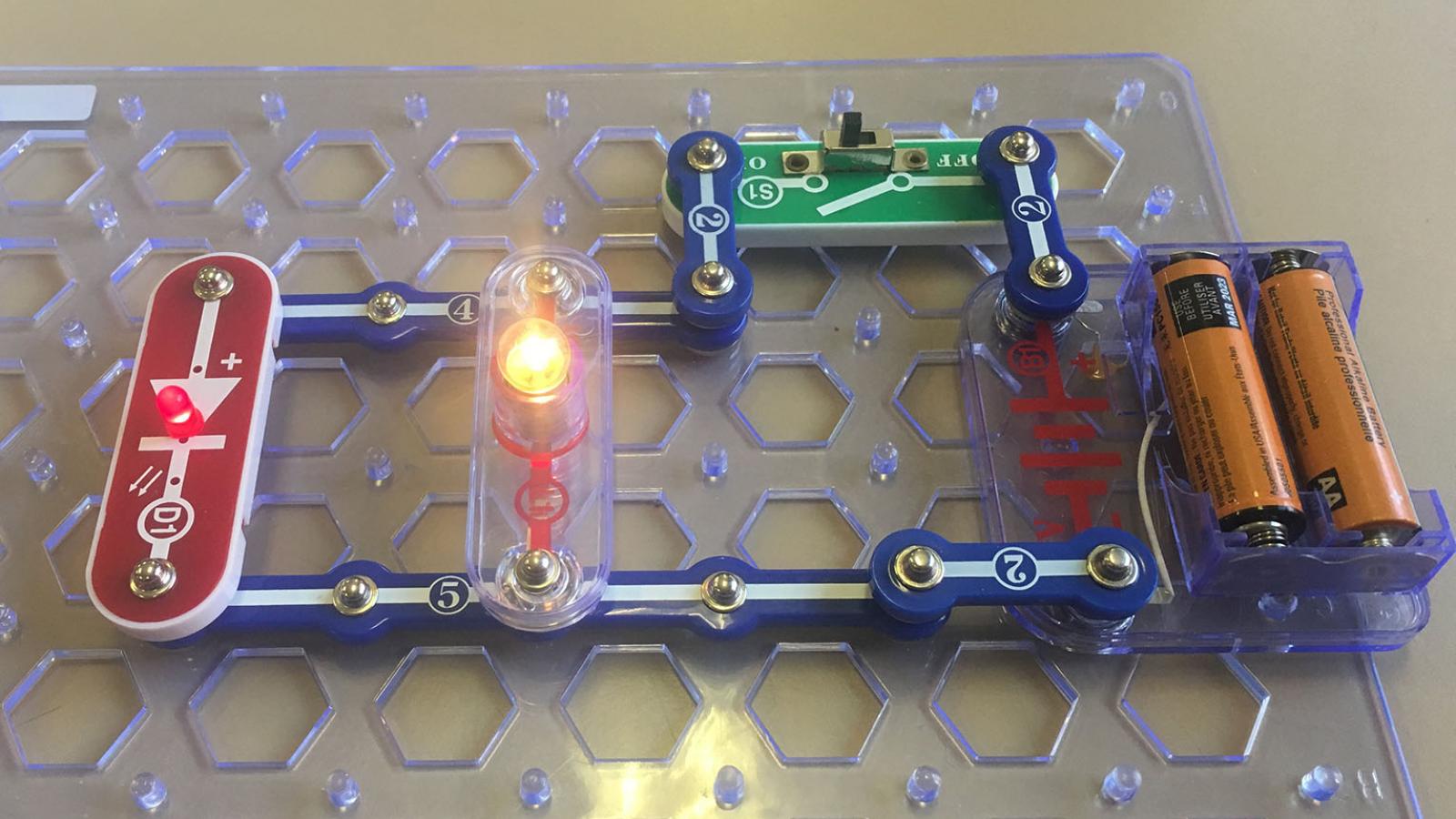Below are all the WOW Unit Topics and a brief look at the WOW Experiments. If you would like to see an experiment pdf/doc or an entire unit packet, please visit and fill out the contact us form.
WOW Units
The WOW Programs always start with the Scientific Method Unit because the scientific method is the basis of all science. The information and experiences learned in this unit will help students with future units and experiments.
Only one experiment is selected for this WOW visit as the experiment takes 30 minutes to an hour to complete. Some experiments can be abbreviated to do two during the visit like the Mystery Boxes and Spaghetti-Marshmallow Towers experiments.
Airplanes
When trying to solve a problem, we often use a form of experimentation, “guess and check”—unwittingly, we are using the scientific method! Here, students can improve the flight distance of an airplane using the scientific method.
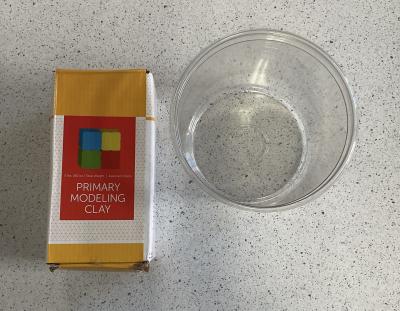
Clay Boats
Groups of students will be challenged to make a boat out of clay that holds the most weight. Clay is denser than water, so a randomly-shaped lump of clay will sink. It is up to students to figure out how a boat works, and use their intuitive understanding of surface area and volume to make a boat that can float—and carry a load!
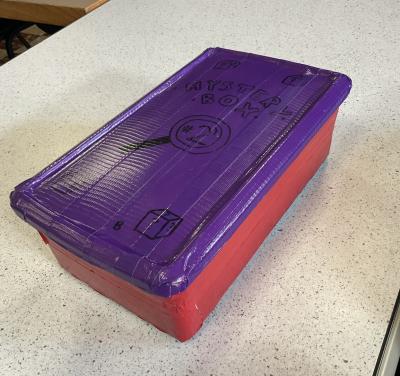
Mystery Boxes
The scientific method is a structured way of solving scientific problems. Students will use the scientific method to describe the mystery item in each box. The objective is not to guess the contents of the box; instead, the goal is to make as detailed and accurate a list as possible of the box properties.
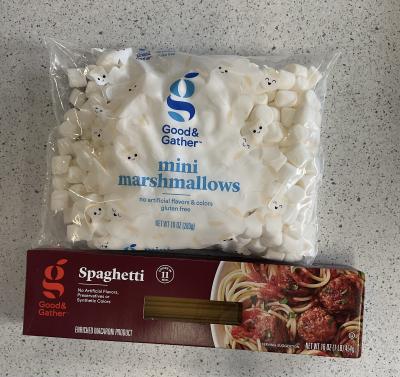
Spaghetti-Marshmallow Towers
Groups of students will be challenged to make the tallest tower out of raw, uncooked spaghetti and marshmallows. In this activity, students will explore structures and investigate building methods to make not only the tallest structure, but the strongest structure as well. Students will be able to rebuild and alter their designs to improve them while working with a team to create the best design. They will get an insight into the scientific method and real-life process of designing, testing, and redesigning their product just like architects and engineers.
The Chemistry Unit will be implemented into the WOW Program visits once throughout the school's three year duration with the program. Teachers will pick at least 4-5 experiments from the experiment options below. All experiments are 5-10 minutes in length and for grades K-5.
Acid-Base Chemistry
Chemical compounds are grouped together based on similar properties. Acids are chemical compounds that are sour or bitter. Bases are a group of compounds that have opposite properties to acids. Bases are characteristically slippery. A number scale called a pH scale, which spans from 0 to 14, is used to provide information on how strong an acid or base is. Values on the pH scale between 0 and 7 are acidic; values above 7 are basic. A pH value of 7 corresponds to the neutral condition, neither acidic nor basic.
Color Changing Milk
This experiment is designed to show students the concepts of polarity, miscibility, and immiscibility. Chemical polarity describes how equally bonding of electrons are shared between atoms.
Chemical vs. Physical Changes
These experiments provide hands-on experience with chemical and physical changes. Set up multiple stations, and ask students to explain which experiments are chemical changes and which are physical changes. Safety goggles should be worn at all times.
Chemical Change: Baking Soda/Vinegar
Chemical Change: Potato with Hydrogen Peroxide
Chemical Change: Making a Polymer/Slime
Physical Change: Change of State/Vanilla Evaporate
Physical Change: Is it a Solid or Liquid - Cornstarch/Water
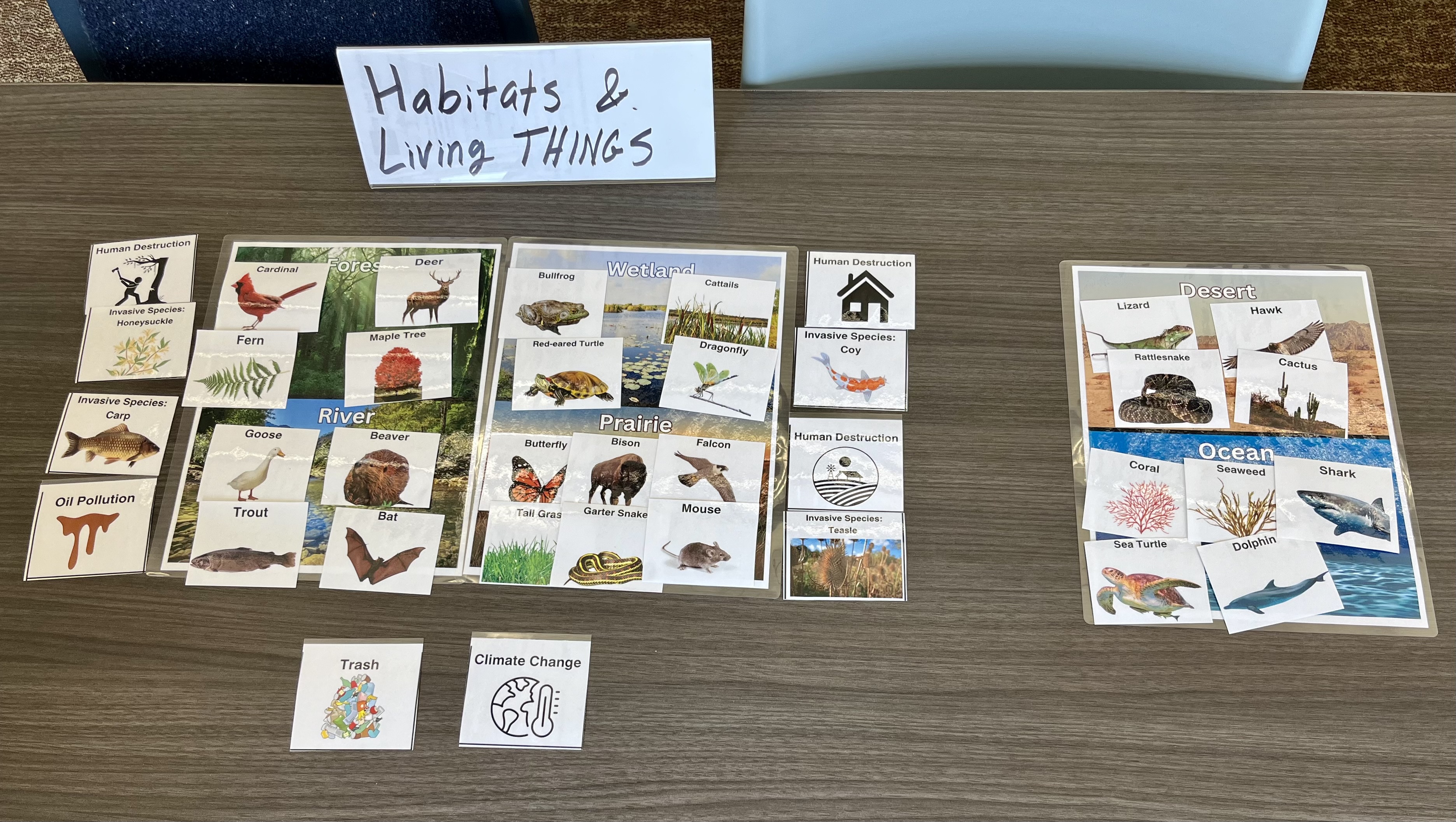
Habitats and Living Things (Grades K-5; 5-6 minutes)
Humans and other living things have some of the same basic needs. Every animal needs a home or habitat. This activity will discuss some of the most common habitats in Ohio and some of the adaptations that living things have to make them best suited for each habitat.
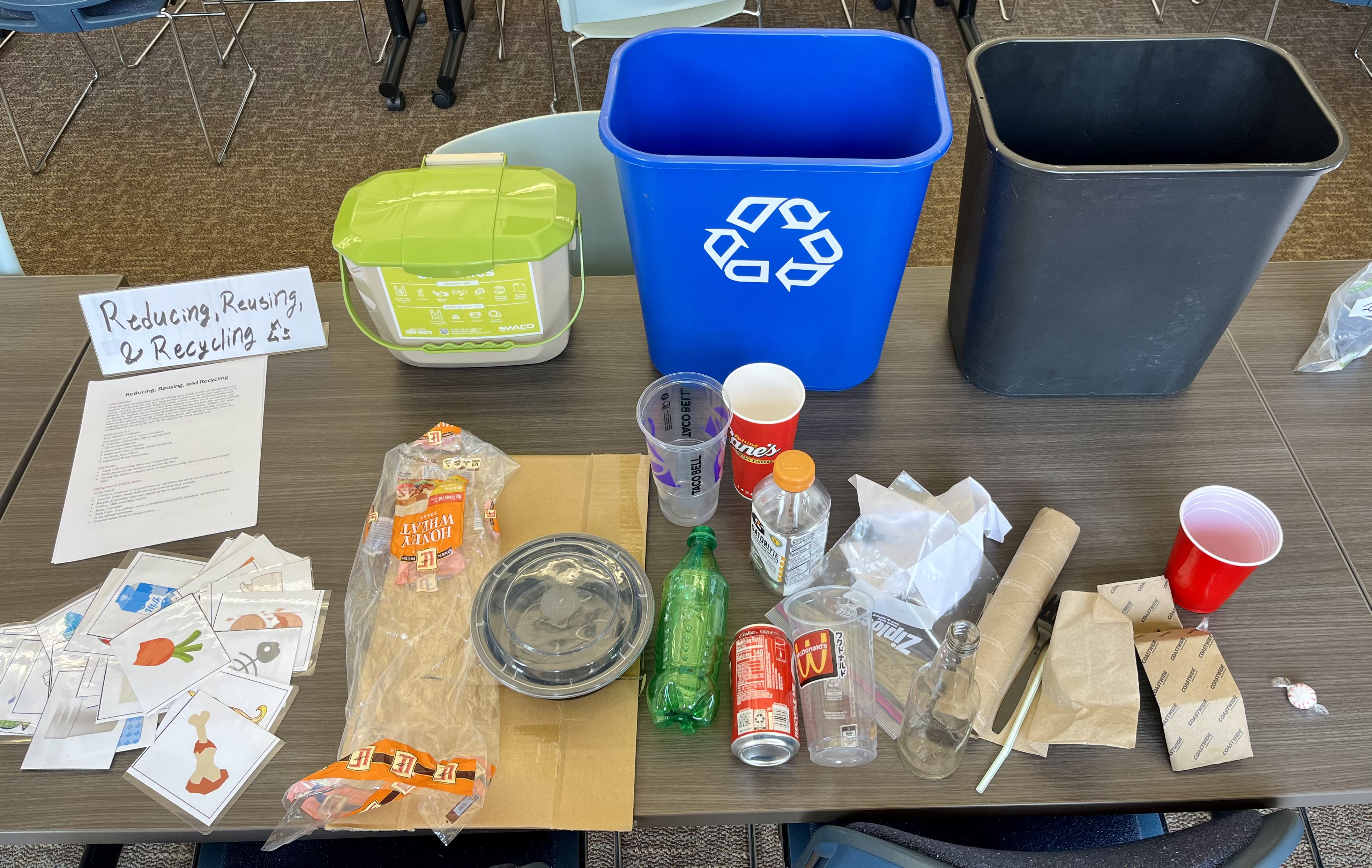
Reducing, Reusing, and Recycling (Grades K-5; 5-6 minutes)
Every day each of us generates trash. By looking more closely at what we are throwing away, students will discover not only how much garbage is produced, but also how much of it can be reused, recycled, or composted. When they reuse, recycle, compost, or dispose of their trash properly, individuals take control of their trash and help keep litter out of our waterways and ocean basins.
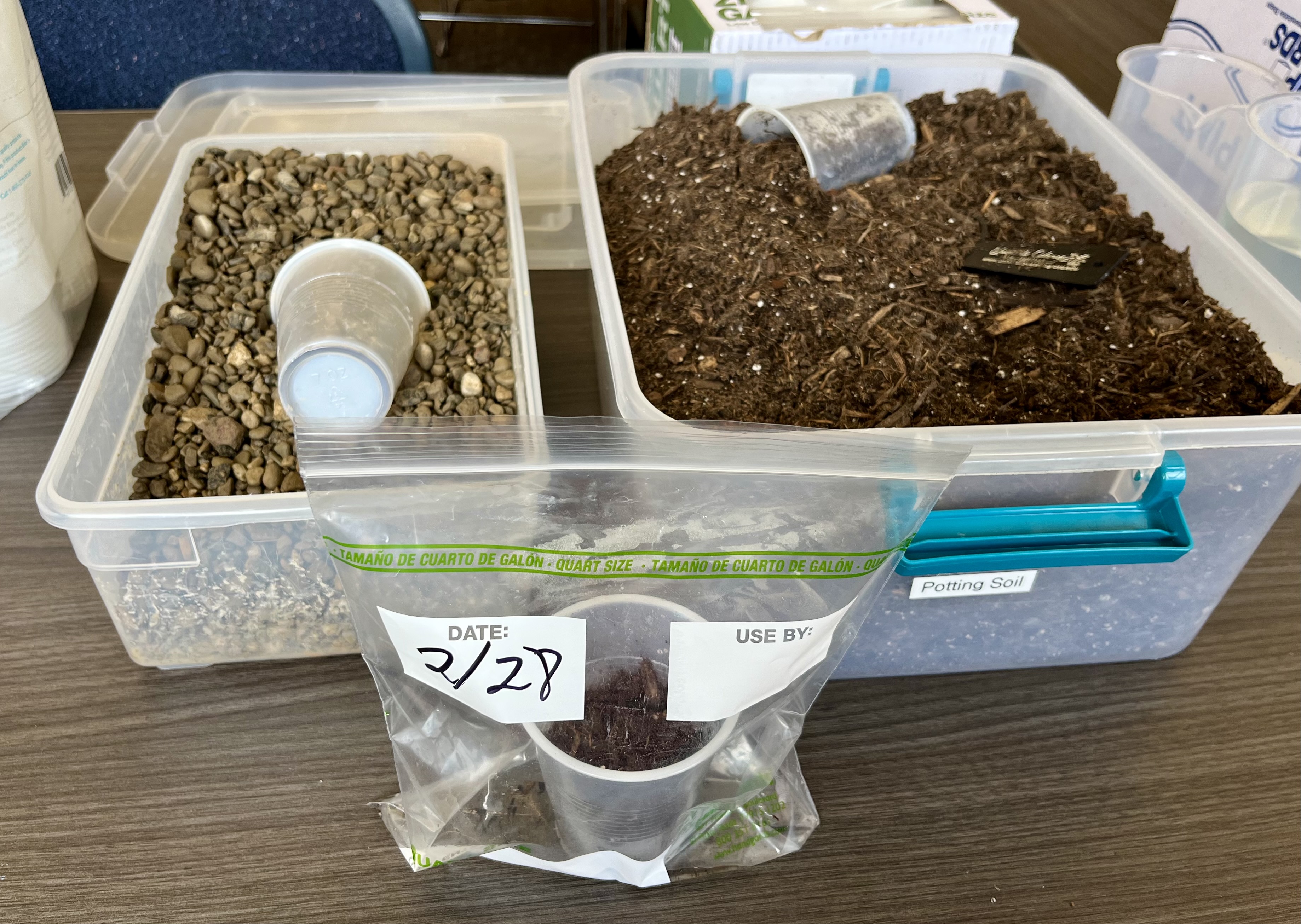
Growing Grass in a Homemade Greenhouse (Grades k-5; 8-12 minutes)
All living things need to have specific things such as food, water, shelter, and so much more to survive. Just like we need food and water, so do plants! Even the grass we walk on depends on the same things we depend on to survive. In this experiment we are going to be looking at how we can grow grass in a simple environment and seeing what they need to survive.
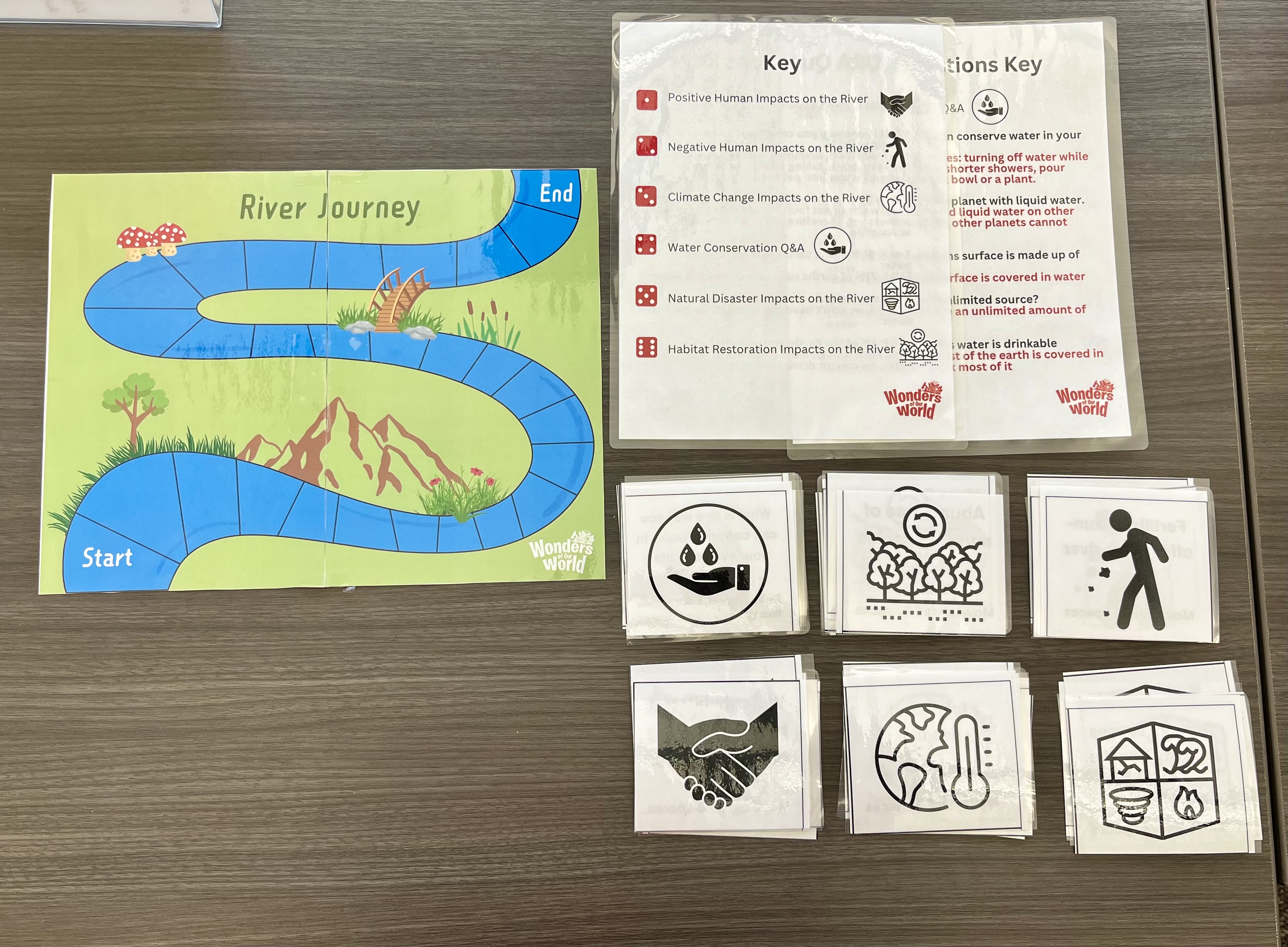
River Journey (Grades K-5; 8-15 minutes)
Earth has an abundance of water! We are surrounded by rivers, seas, oceans, lakes, and so many more bodies of water. So why do we experience water shortages? This is because not all water can be used as drinking water and there are so many more factors that can negatively affect the water around us. Some of these things include pollution, droughts, overuse of water, and so much more. We will be observing the different ways water is affected by humans and natural phenomenons and how we can help the environment around us knowing these things.
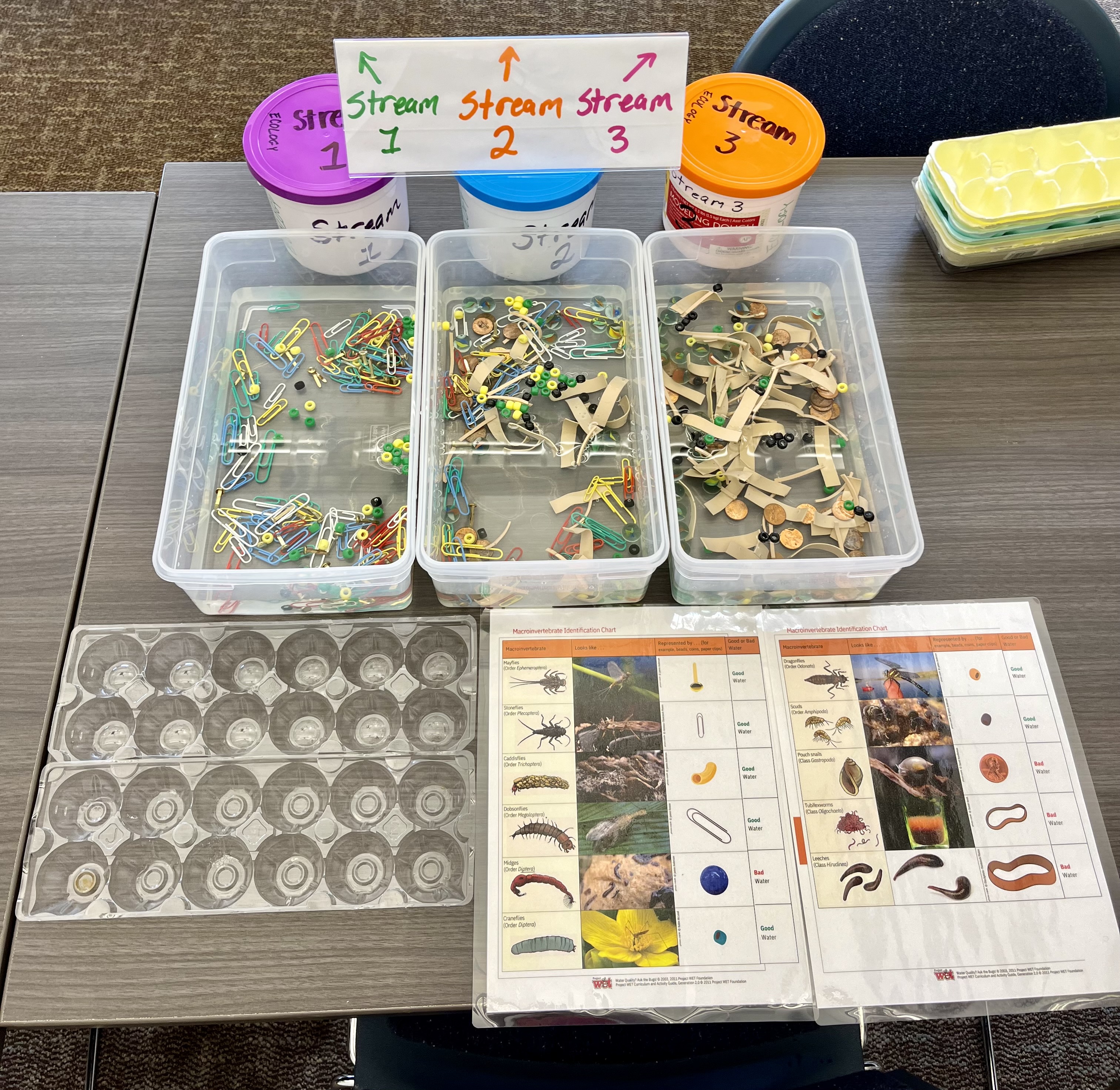
Water Quality? Ask the Bugs (Grades K-5; 5-10 minutes)
This experiment will be exploring how healthy a water habitat is based its water bugs.
Food Web Jenga (Grades K-5; 5-6 minutes)
In a food web, everything is connected. If the balance of one level is disturbed too much, the other levels will be affected. This could cause a food web to collapse. The game of Jenga helps act as a representation of a food web. The pieces of the game help to demonstrate the relationship between the trophic levels of a food web along with the potential impact humans might have on that food web.
The Electricity Unit will be implemented into the WOW Program visits once throughout the school's three year duration with the program. All experiments below are 5-10 minutes in length and for grades K-5.
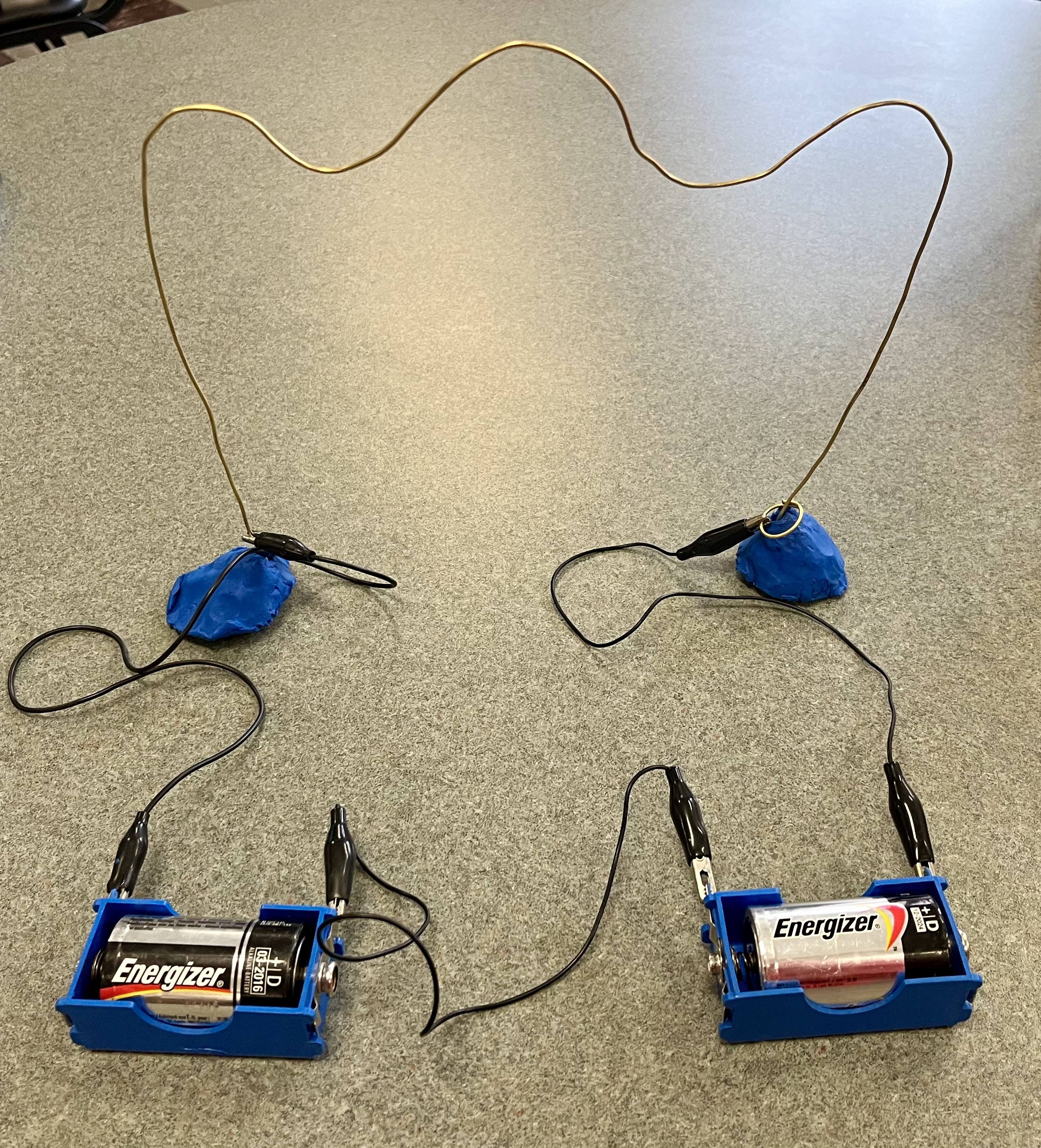
Connect the Circuit Game
Electricity can flow though a complete, closed circuit, but cannot flow though an open circuit. This concept is reinforced with a fun game that tests the steadiness and patience of the players while illustrating this basic fact.
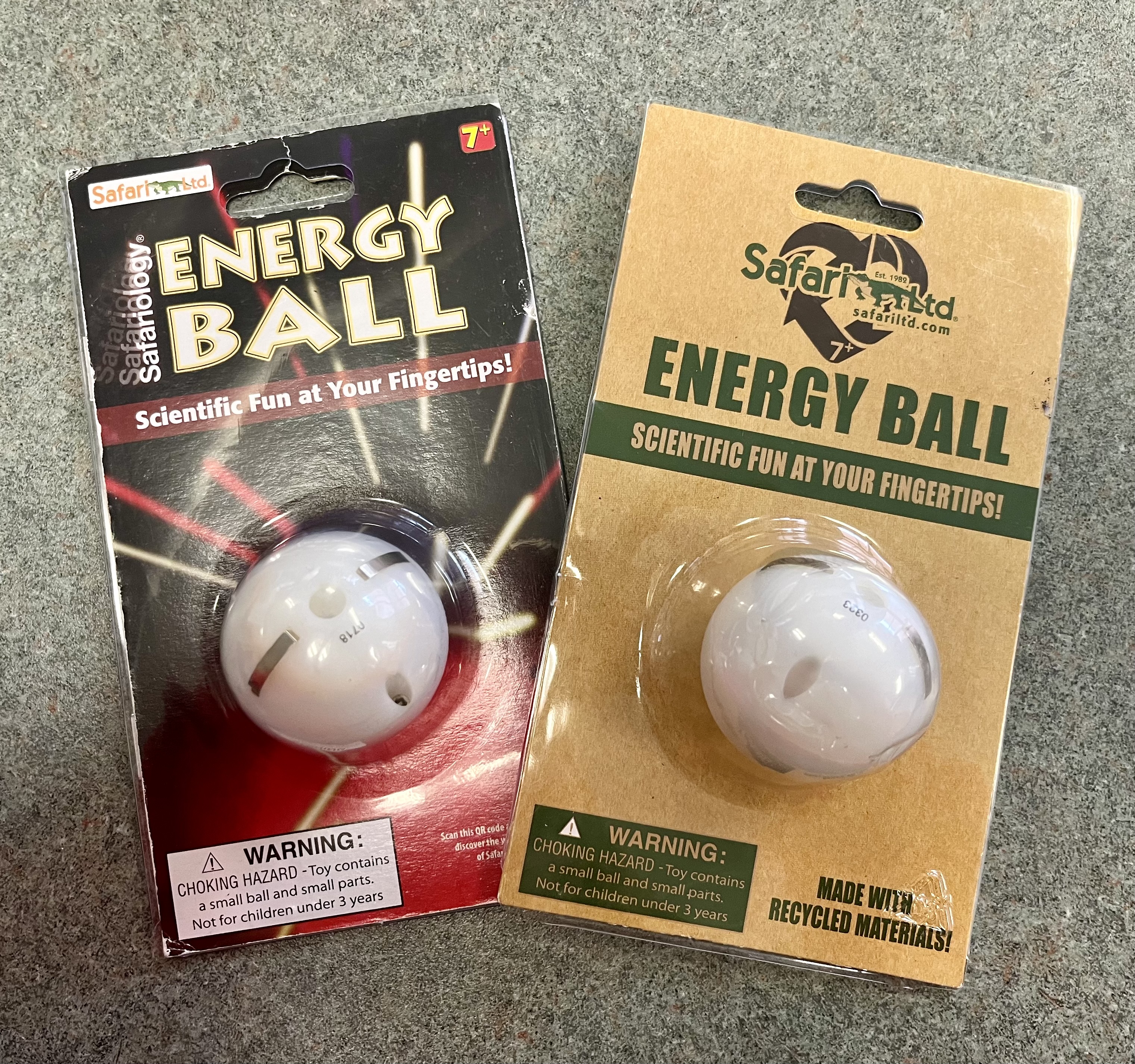
Energy Ball
Circuits are everywhere! They are responsible for the lights over our heads, how our cell phones work, and how we watch TV. These devices only work, however, when those circuits are closed. This activity allows students to witness what it means when a circuit is closed, and to test what materials (including themselves) electricity can flow through.
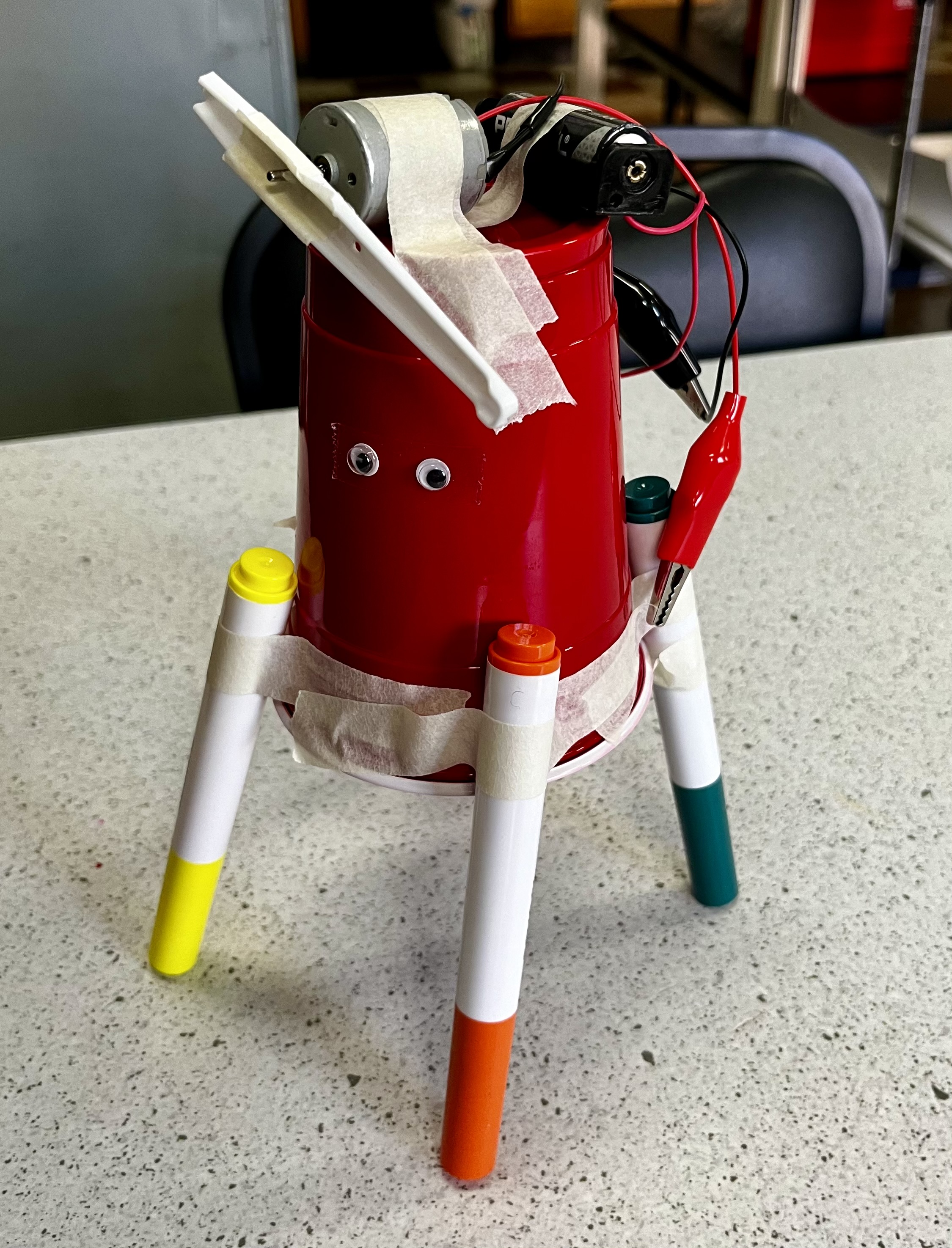
Marker Robot
Electricity is used to power mostly everything that we use in everyday life. This experiment will allow students to create a functional doodle robot using everyday materials. They can experiment with the materials by altering different variables such as the battery, fan size, and possibly the number of markers and observe how those factors may change the functionality of the robot.
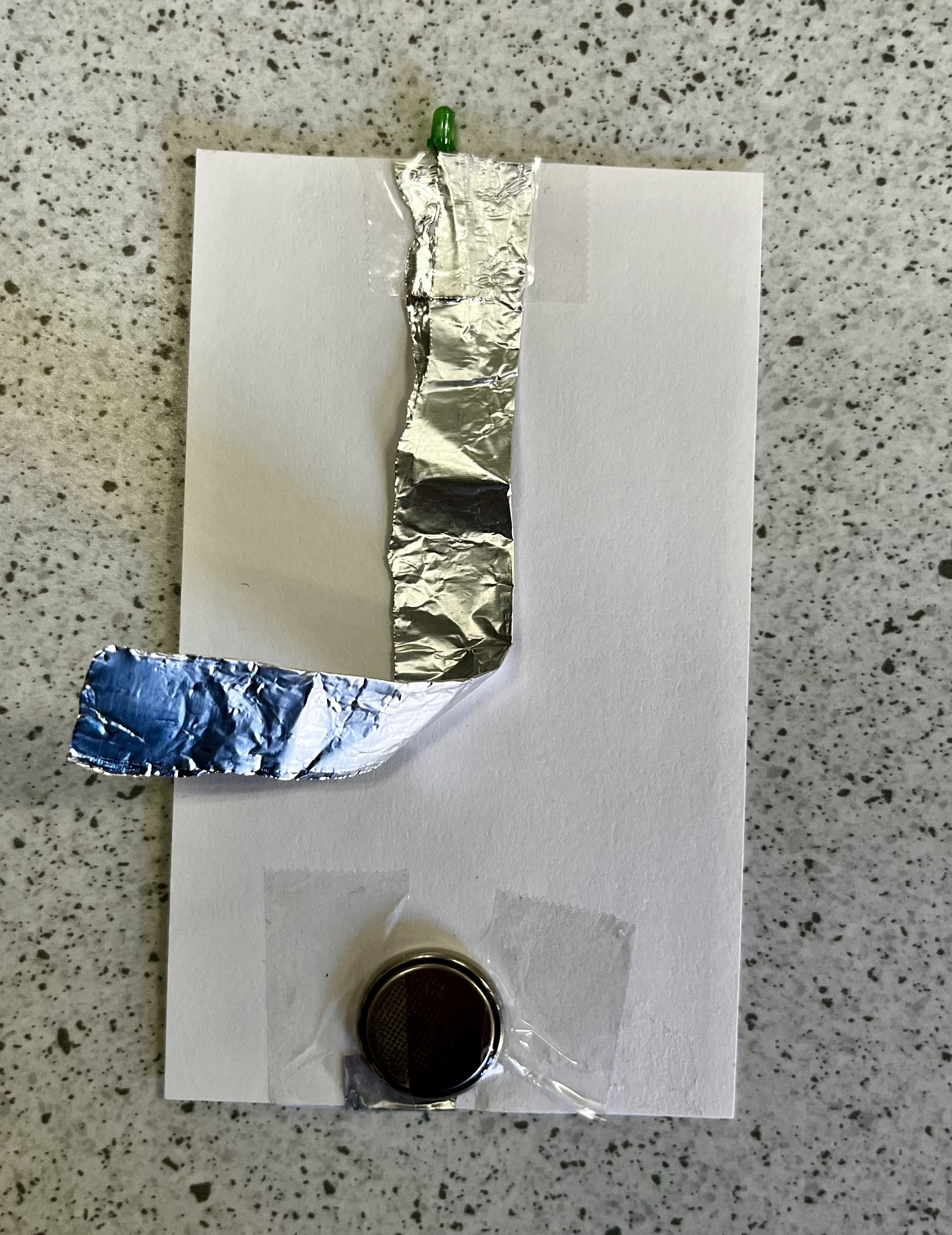
Notecard Flashlight
Electricity is everywhere! The lights above your heads, your computer, even small things such as chargers and flashlights use electricity. For electricity to power things like lights, fans, and computers there needs to be a flow of electricity, which is called a circuit. A circuit is used to do just that, help electricity flow from a power source to something that you want to power. This experiment will allow student to experiment with circuits by creating their own flashlight.
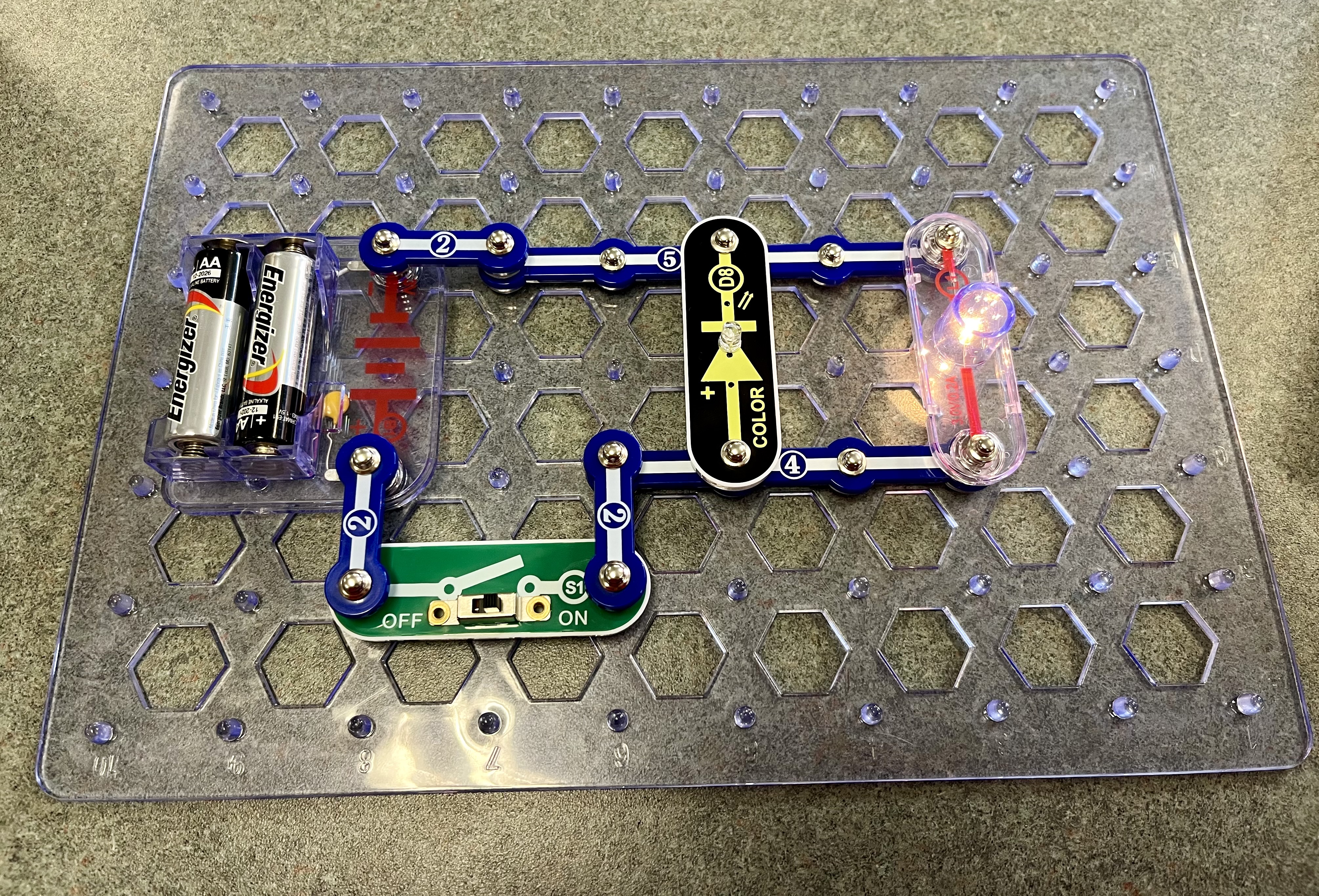
Parallel and Series Circuits
There are different ways to make an electric circuit. In a series circuit, the amount of current through any part of the circuit is the same, while a parallel circuit divides the electric current into two or more “parallel” paths. By comparing the brightness of light bulbs, we can trace the current and voltage in a parallel and series circuit, to see how they differ.
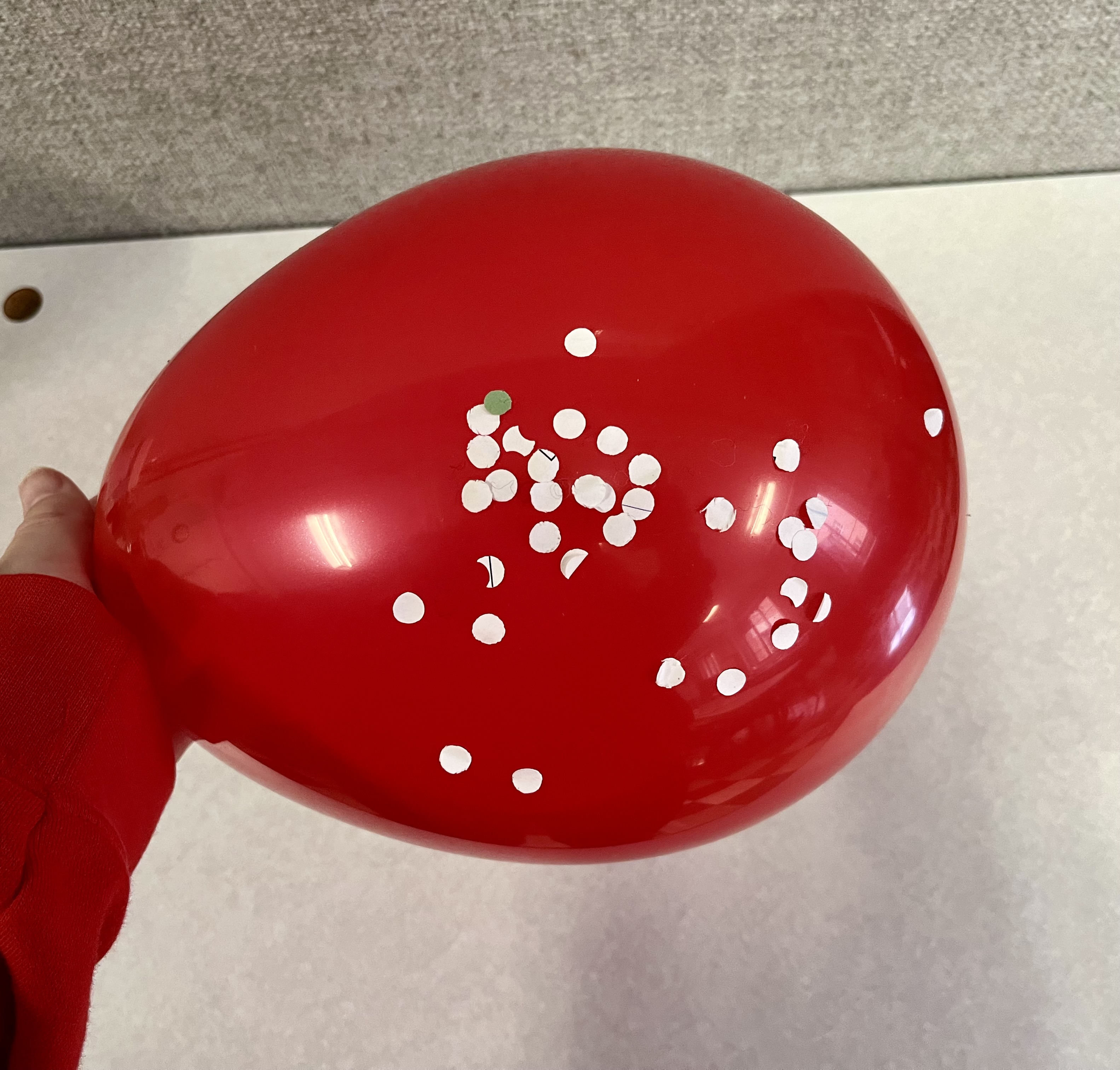
Static Electricity
We often think of electricity as only electric currents, such as power lines, or generators that “make” electricity. All matter is made of protons and electrons, so really all matter is “electric”—but we normally do not observe this electric charge, since the positive and negative charges cancel. A surplus or deficit of electrons will give an object a negative or positive electric charge—static electricity.
The Geology Unit will be implemented into the WOW Program visits once throughout the school's three-year duration with the program. Teachers will select experiments that total a 45 minute to 1 hour class visit. For this unit, we work in collaboration with The Ohio State University's Byrd Polar and Climate Research Center https://byrd.osu.edu/ and the Polar Rock Repository (Link does not work). They have rock boxes that can be loaned out to schools. Details to request a rock box can be found here at: https://byrd.osu.edu/community-outreach
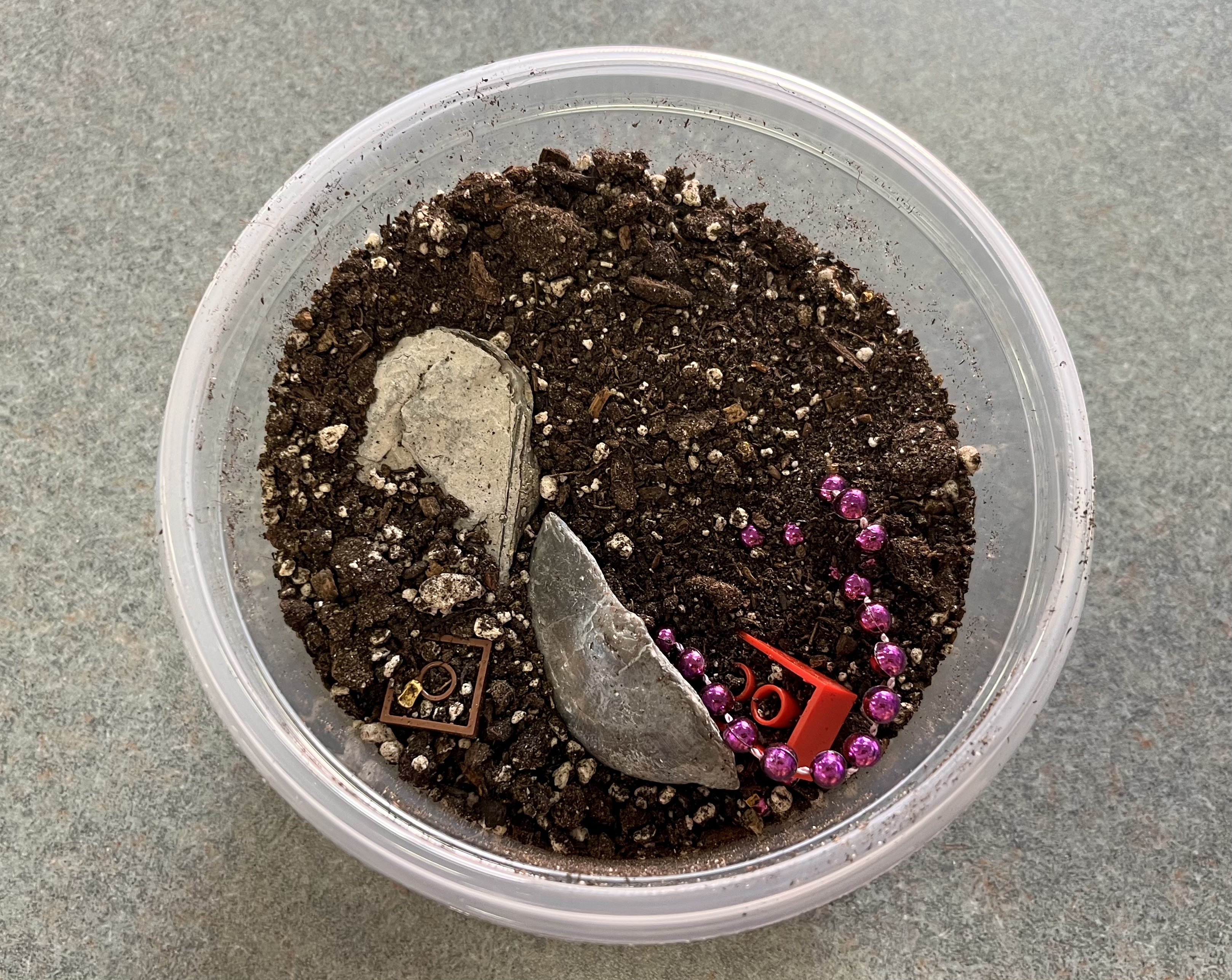
What’s Under My Feet? Soil Exploration (Grades K-5; 10-15 minutes)
In this activity, students will explore what is in the soil beneath their feet. Once the activity concludes, students will be able to draw and describe what they might find in soil. Soil is the loose surface layer of the Earth where plants grow. It consists of organic material (plants, animals), rocks, and minerals. Soil is formed over a long period and can take up to 1000 years for just an inch of soil to form.
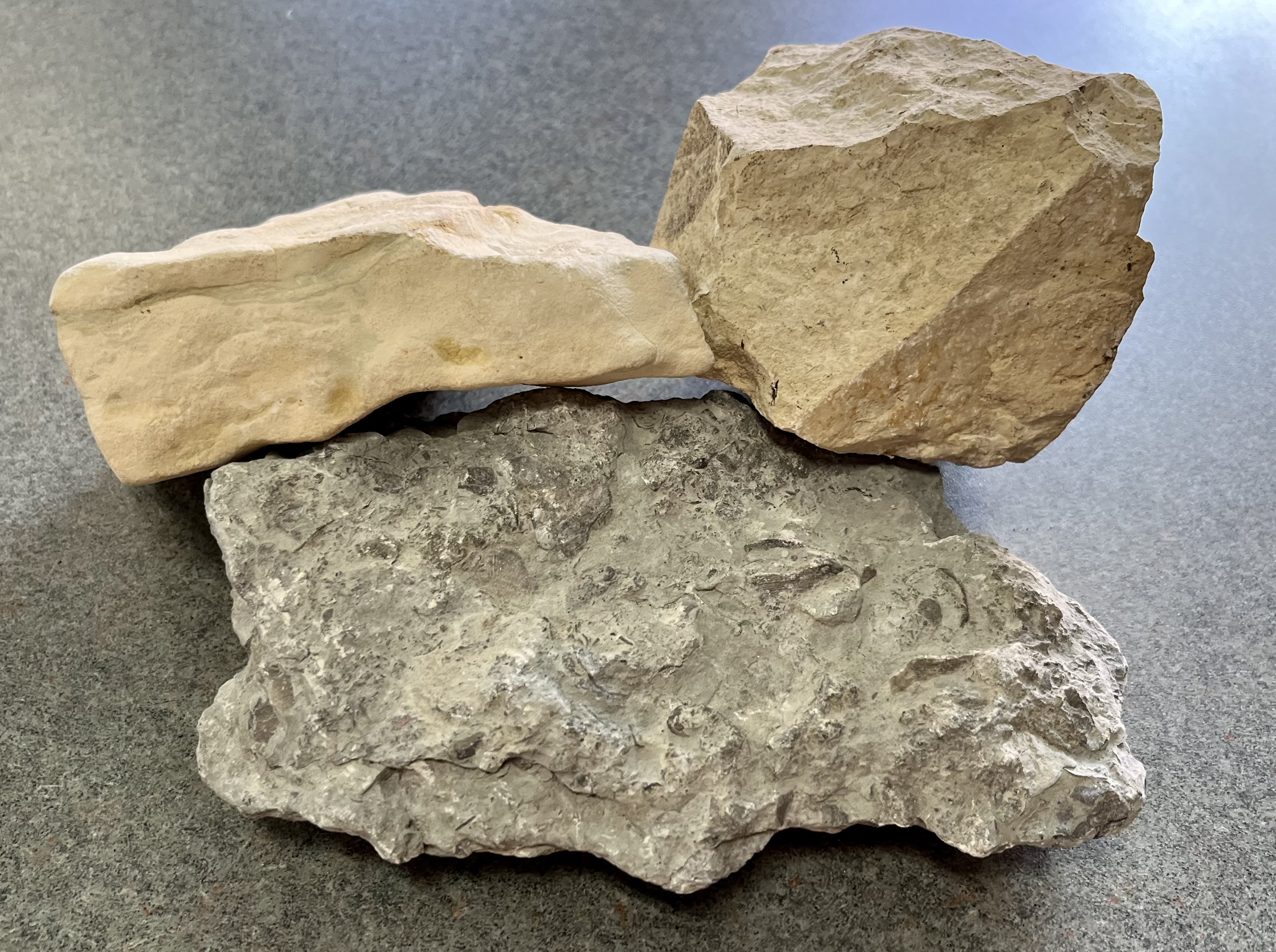
All about Rocks Exploration (Grades K-5; 15-20 minutes)
In this experiment, students will get to observe, touch, and talk about different types of rocks. They will learn that there are three different types of rock: igneous, sedimentary, and metamorphic. These three types of rocks are interconvertible and comprise a cycle.
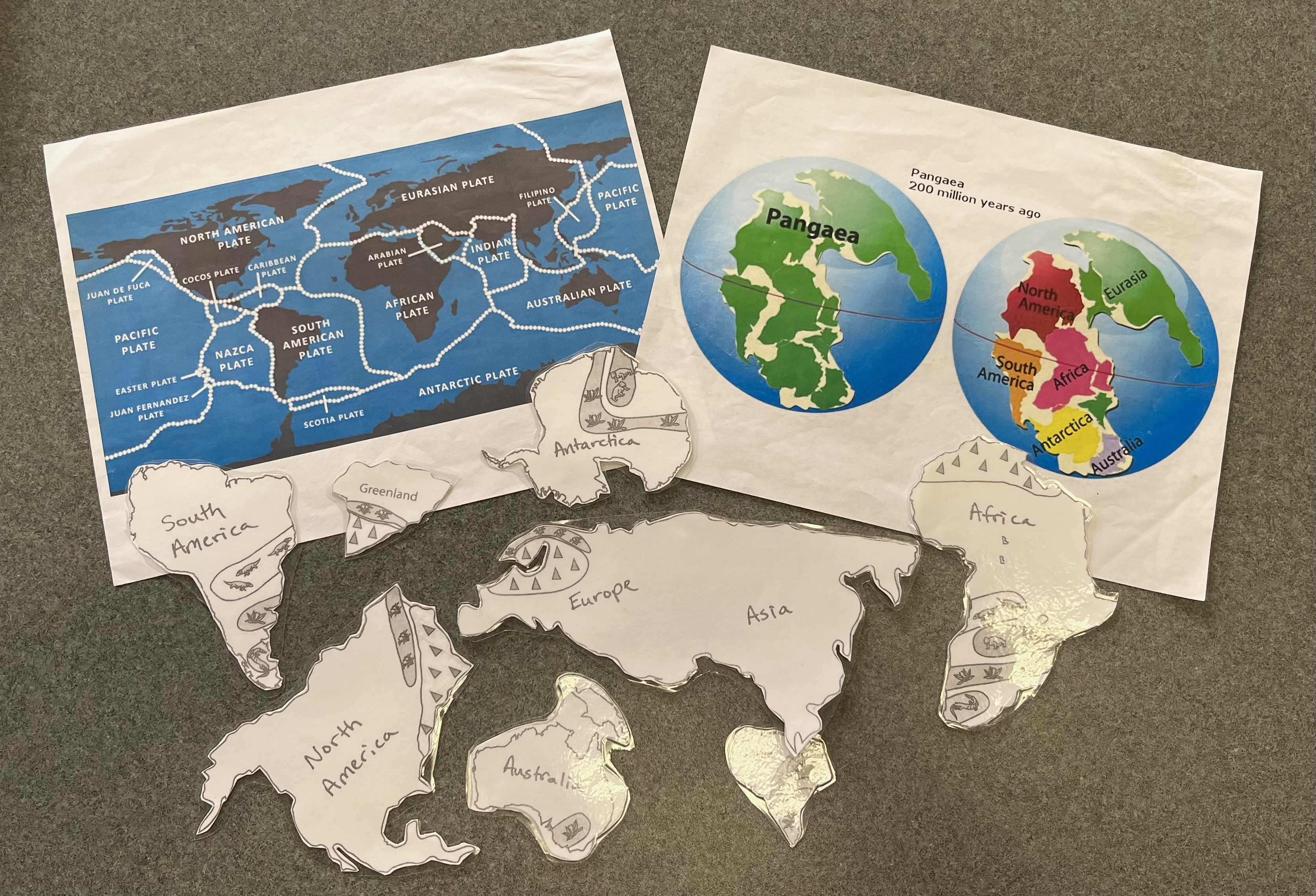
Pangaea: Plate Tectonics Puzzle (Grades K-5; 10-15 minutes)
The Earth’s solid crust is broken up into numerous tectonic plates, which slowly move, carried by the motions of the slowly-convecting semi-liquid mantle. These tectonic plates collide or separate, forming mountain ranges, ocean trenches, mid-ocean ridges, and regions of volcanic activity. This activity explores the long-term result of: the locations of the continents have changed over time.
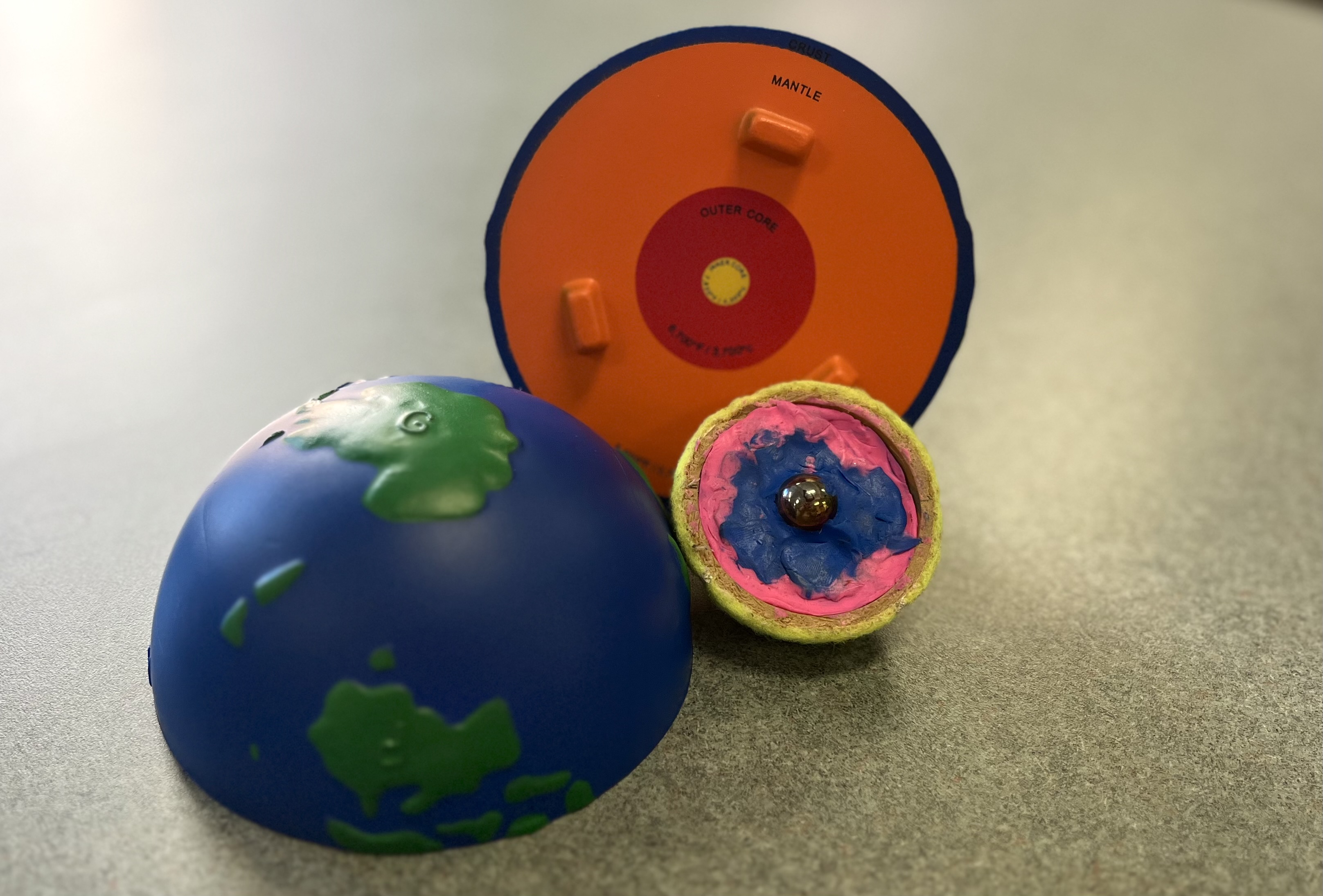
Journey to Center of Earth (Grades K-5; 5-10 minutes)
This activity teaches students about the Earth's interior using various kinds of fruit and models. Students will learn about the Earth’s crust, mantle, and core.
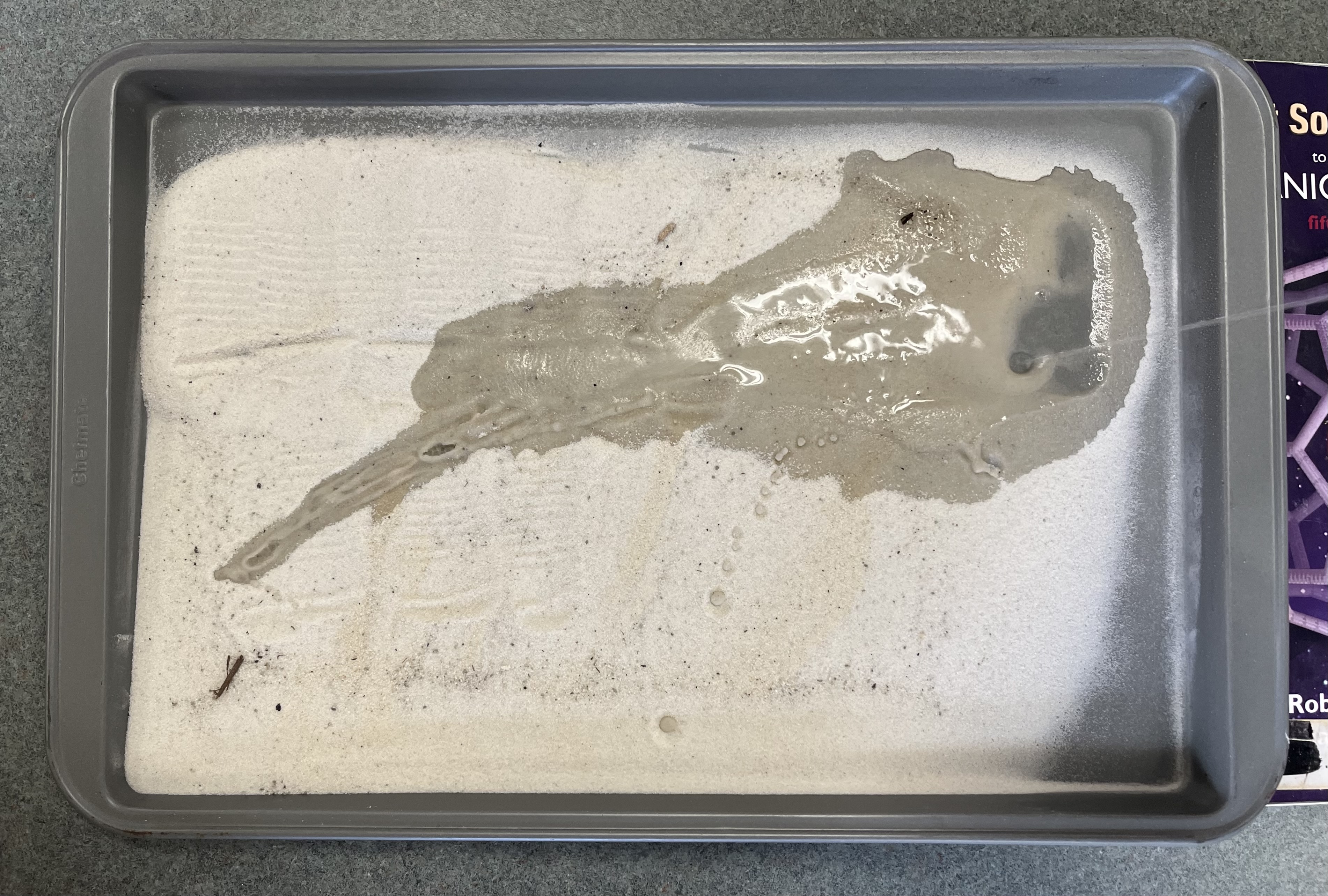
How a River Runs (Grades K-5; 5-10 minutes)
Erosion is a geologic process that shapes the entire surface of the Earth. Water has, over millions of years, carved deep canyons, such as the Grand Canyon of the Colorado River; likewise, glaciers scoured out the basins that filled to become the Great Lakes. All the rock eroded away by rivers and glaciers does not disappear; it ends up as sand on beaches, silt in river deltas, glacial moraines, and ultimately, returns to rock as sandstone, shale, or conglomerate. This experiment explores how river erosion takes place. By varying the angle of the cookie sheet, different river gradients can be simulated, and the conditions that allow a river to meander can be explored.
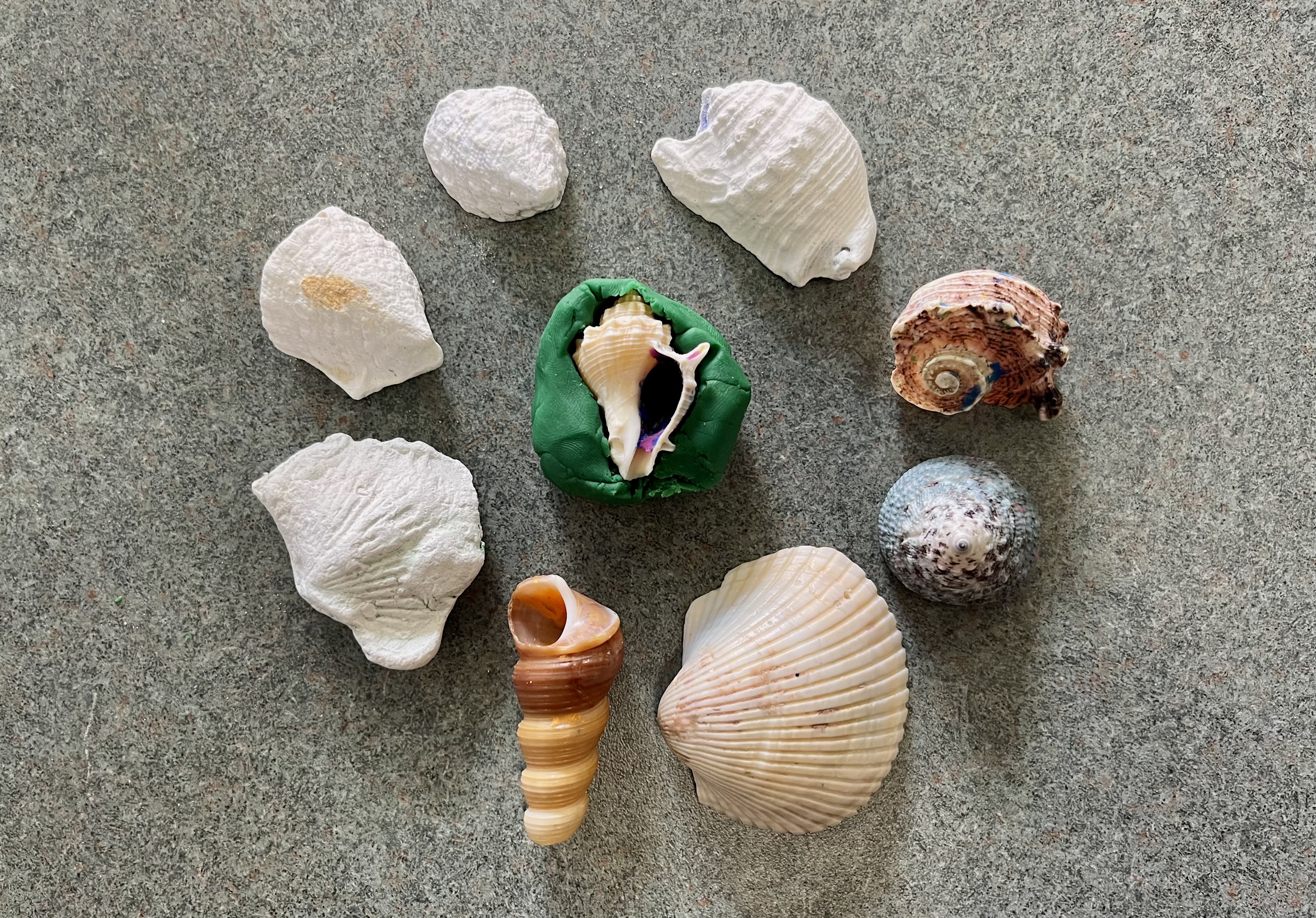
Making and Dating Fossils (Grades K-5; 5-10 minutes for each part (20 minutes total plus 50 minutes to dry)
Fossils are something every student has heard about or seen, but few have actually touched or examined them. In this experiment, students will make their own fossils.
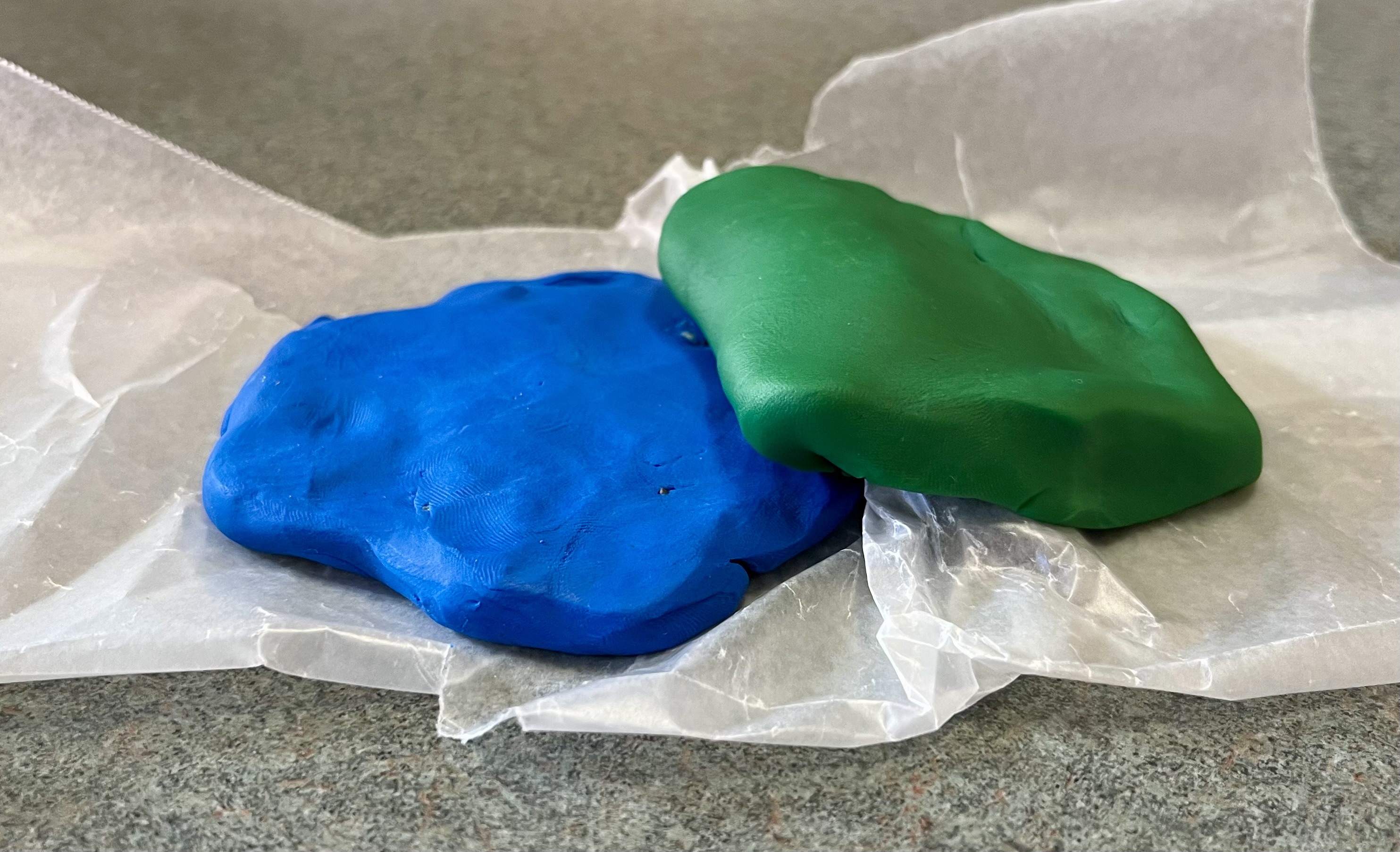
Making Mountains (Grades 3-5; 15-20 minutes)
The earth’s crust consists of two types – oceanic crust made up of material on the ocean floor and continental crust, made up of continental landmasses. The oceanic crust, continental crust, and the upper mantle make up the lithosphere. According to the theory of plate tectonics, the lithosphere is broken up into separate plates that move beneath the earth’s surface. Mountains are formed when these lithospheric plates collide. If oceanic crust and continental crusts collide, the oceanic crust is subducted beneath the continental crust, which pushes up mountain ranges—a process called orogenesis. This activity explores how mountains are made and shows the connection between mountain ranges and plate tectonics.
The Insect Unit will be implemented into the WOW Program visits once throughout the school's three year duration with the program. Teachers will select whole categories or pick and choose from each category to total 45 minutes to an hour. For this unit, we work in collaboration with Center of Life Science Education and the Insectary for the live insects. We also purchase Painted Lady larvae from Carolina Biological.
All about Insects Category (Grades K-2; 40-45 minutes)
Includes *Gummy Worm Dissection (K-2, 5-10 minutes), *Insect Life Cycles (K-2, 10-15 minutes), Build a Bug (K-2, 5-10 minutes), and *Insect Symmetry (K-2, 5-10 minutes).
Insect Communication Category (Grades K-5; 45-50 minutes)
Includes Insect Communication (K+, all: 30 mins or pick a part, 15 mins each) and Honey Bee Waggle Dance (K-2, but can also apply for older grades too), 15-20 minutes).
Insect Diversity Category (Grades 3-6; 30-45 minutes)
Includes Camouflage (K+, 10-15 minutes) and *Insect Anatomy & Behavior (3-6, 20-30 minutes with a food web connection for 4-5).
Insect Investigation Category
Includes *Crickets and Colors: (3-6, all: 30 mins or pick a part, 10-15 mins each), *Insect Habitat Preference (2-6, 15-20 mins and optional data/graph for 3-5, 20-30 mins), or *Insect Maze (3-6, 45-1 hr) with the first two experiments abbreviated.
A * (star) indicates that live insects are involved.
The Light Unit will be implemented into the WOW Program visits once throughout the school's three year duration with the program. All experiments below will take place during our WOW visit. All experiments are 5-10 minutes in length and for grades K-5.
Seeing in 3D
For this activity students will learn how 2D images can be seen in 3D. They will learn how human eyes distinguish between red and blue and combine in our brain to create a 3D image. They will also be learning about retinal fatigue, and why it occurs. The objective is to learn how our eyes and brain work together to create the world we see.
Seeing Rainbows
Students will learn about white light and color mixing. Students will gain an understanding of how white light is created from all colors in the rainbow. To help further their understanding we will show them color mixing with color wheels and lights. This shows them that when you see white light you are seeing rainbows!
UV Black Light Exploration
During this activity, students will learn about the effects of UV light. We will discuss where UV light rays come from and what they do. They will be shown black lights that show a colored glow that different things give off when under UV rays.
UV Light Beads
This activity has similar information as in UV Black light exploration. In conjunction, this activity talks about how UV rays affect us and our bodies. We will also teach students how to protect themselves from UV rays with black light demos and UV light beads. After completing this activity students should have a good understanding of UV rays and its affect.
Why the Sky is Blue/What Makes a Sunset
No matter where we live in the world, we can all experience sunsets. What if you could create one with a few simple steps? In this experiment students will understand why and how sunsets occur. We will use common kitchen items to demonstrate how sunsets are created. It is easy to try and explain but when paired with the experiment it allows for them to retain and fully understand the information.
The Magnetism Unit will be implemented into the WOW Program visits once throughout the school's three year duration with the program. All experiments below will take place during our WOW visit. All experiments are 5-10 minutes in length and for grades K-5.
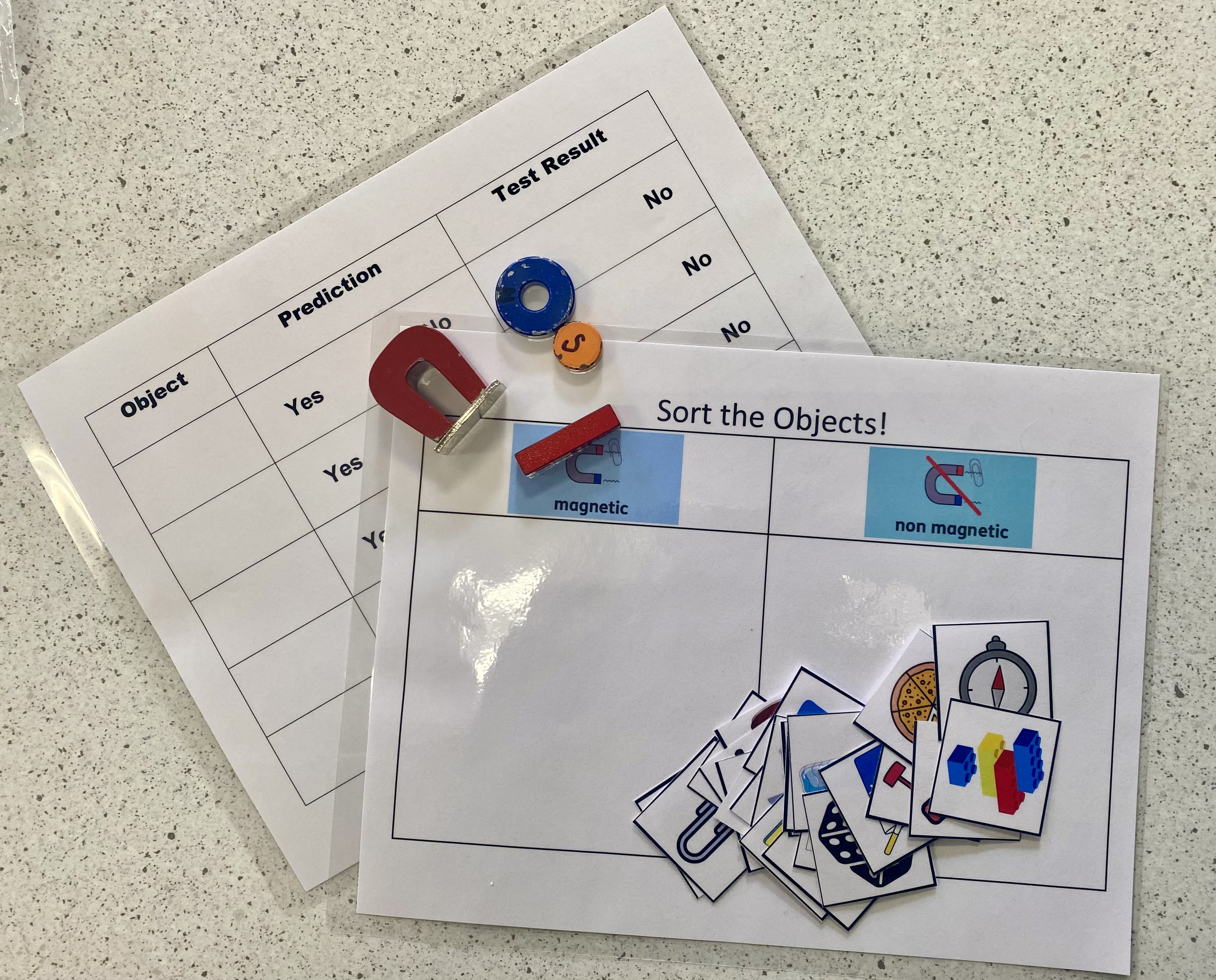
Is It Magnetic? (Grades K-2; 5-10 minutes)
This simple experiment will have students make predictions if an object is magnetic and then test if it is using the magnets provided. Students will explore the basic magnetic properties of different substances. It is a common misconception that magnets attract all metals. Students will also get to test the strength of magnets by pulling the magnet from a magnetic object.
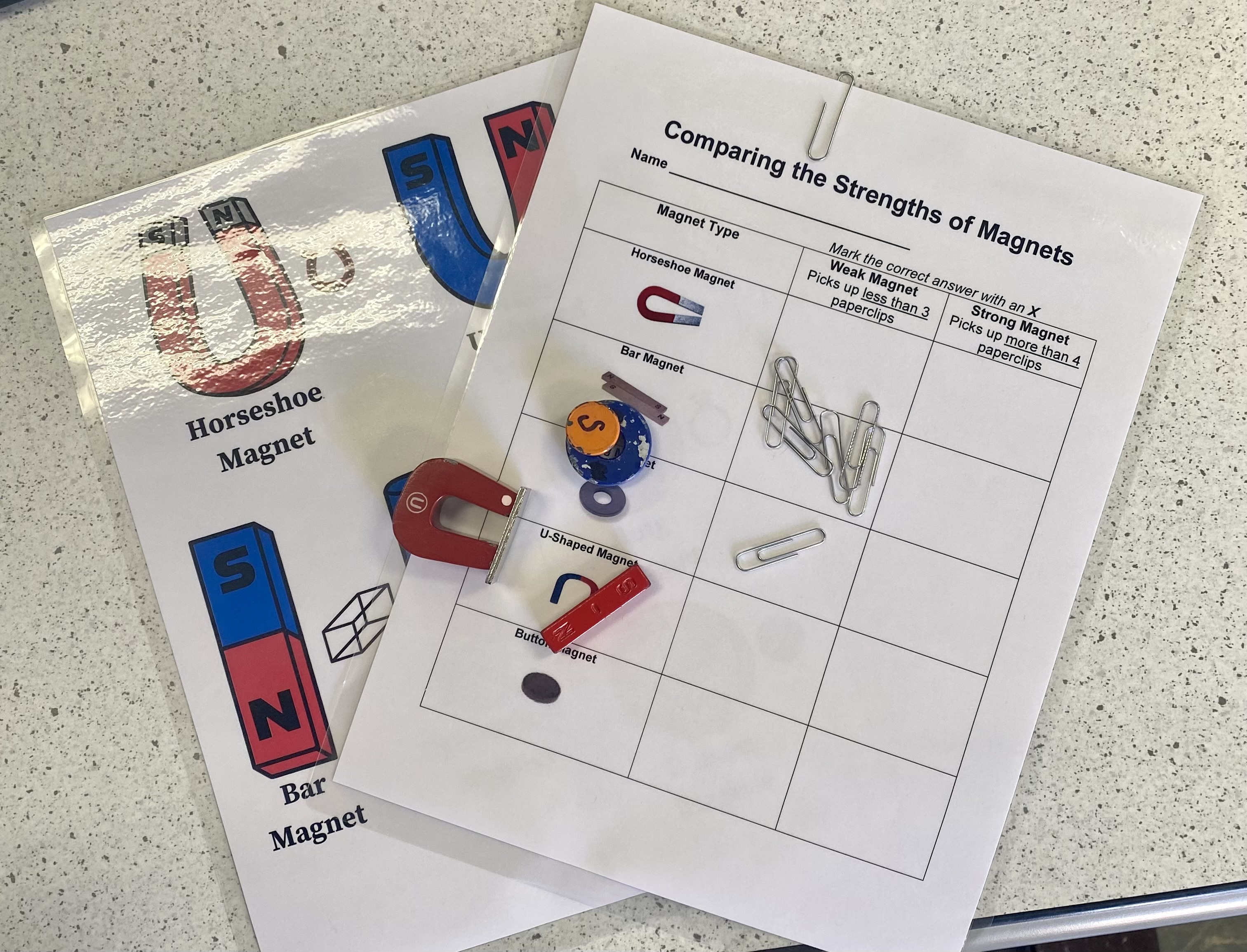
Comparing the Strengths of Magnets (Grades K-5; 5-10 minutes)
Magnets vary in strength. This experiment tests the number of paper clips each magnet can pick up to compare the strength of a variety of magnets.
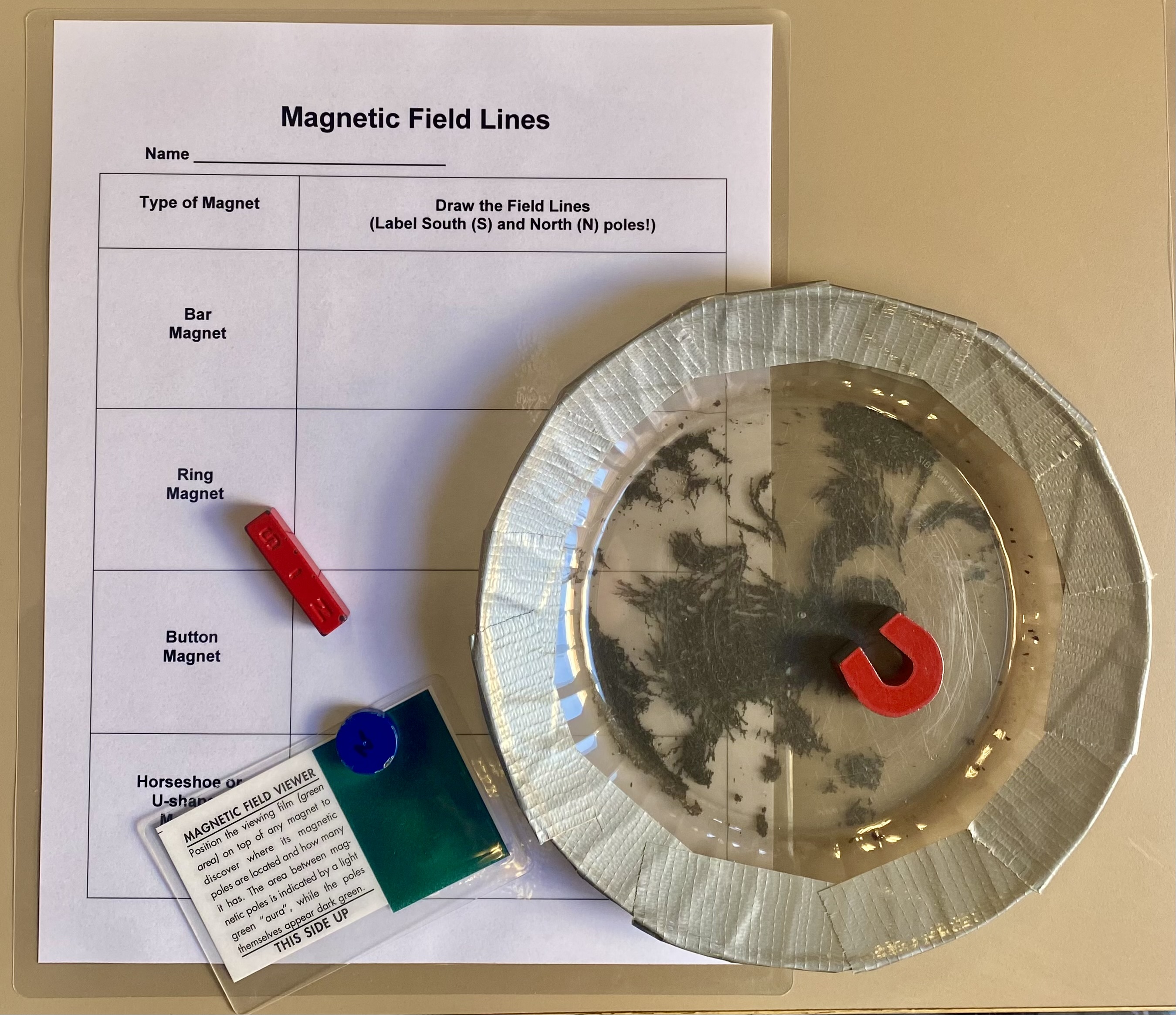
Magnetic Field Lines (Grades K-5; 5-10 minutes)
This experiment will help students visualize and understand the invisible field surrounding magnets of various shapes by using iron filings and a variety of magnets.
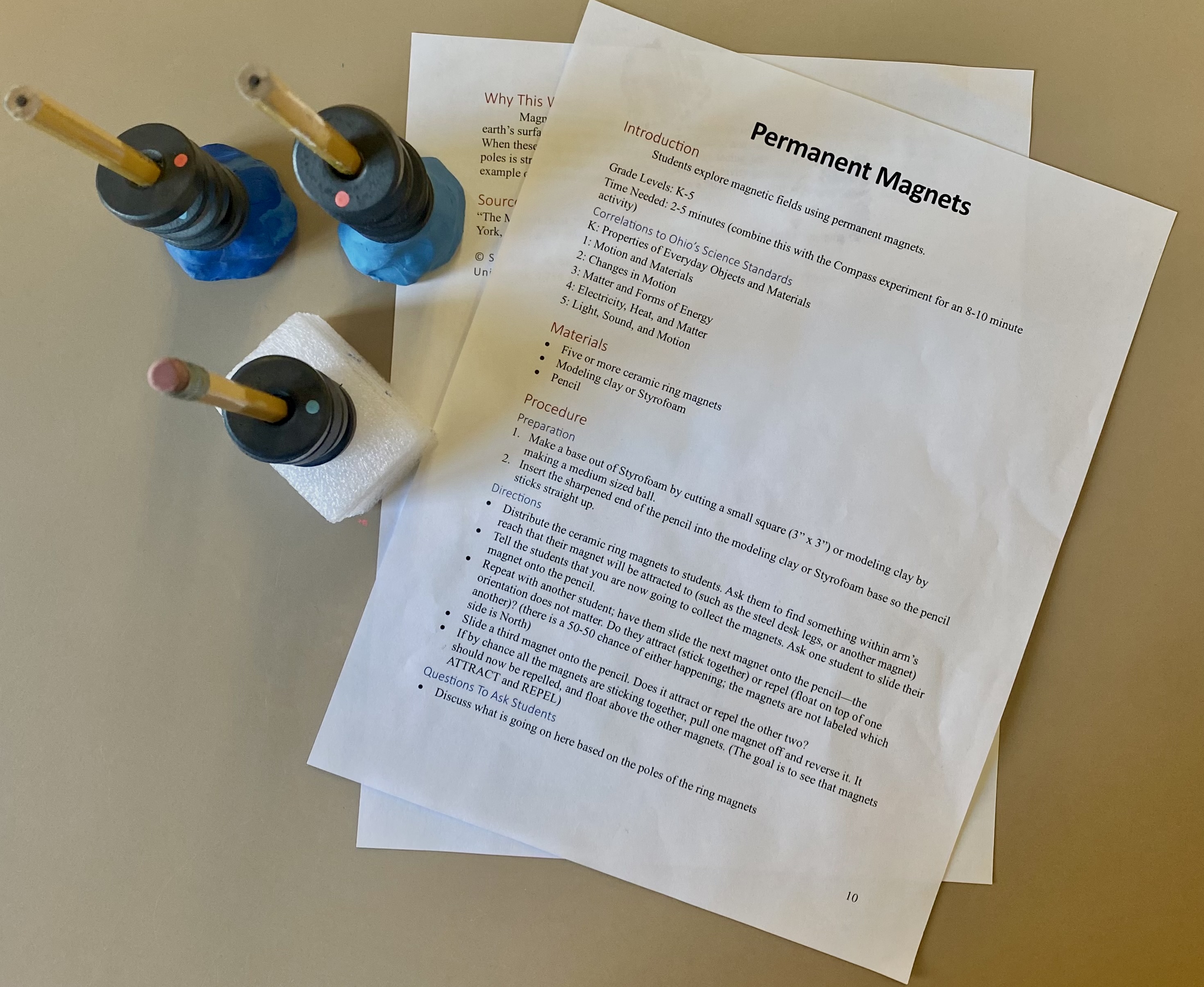
Permanent Magnets (Grades K-5; 2-5 minutes)
We know that magnets can be attracted or repelled from one another depending on which way they are pointed. This experiment will test explore magnetic fields and these concepts using permanent magnets.
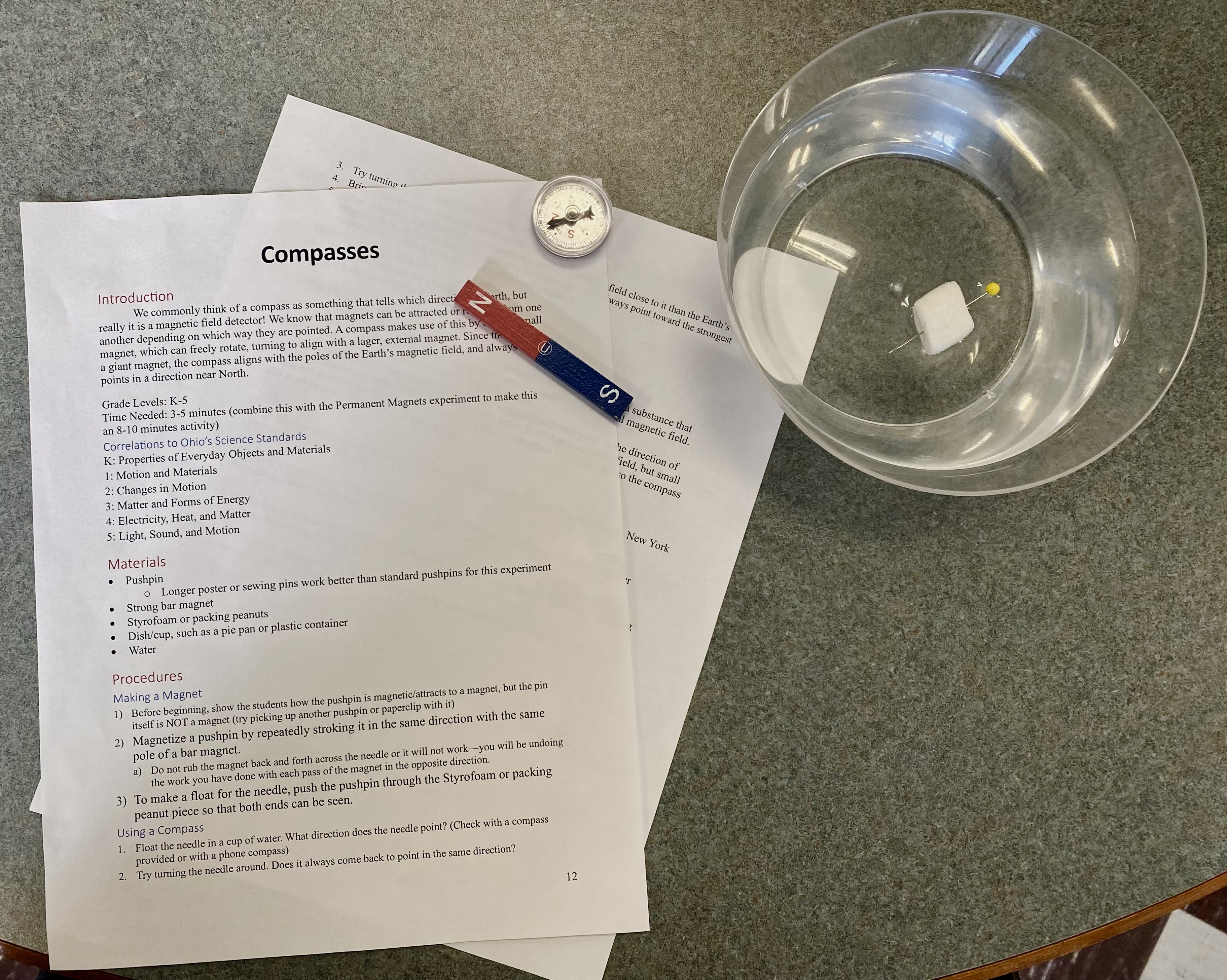
Compasses (Grades K-5; 3-5 minutes)
We commonly think of a compass as something that tells which direction is North, but really it is a magnetic field detector! Since the Earth is a giant magnet, the compass aligns with the poles of the Earth’s magnetic field and always points in a direction near the North. This experiment introduces the way a compass works through the use of a small magnet, which allows the needle of the compass to freely rotate.
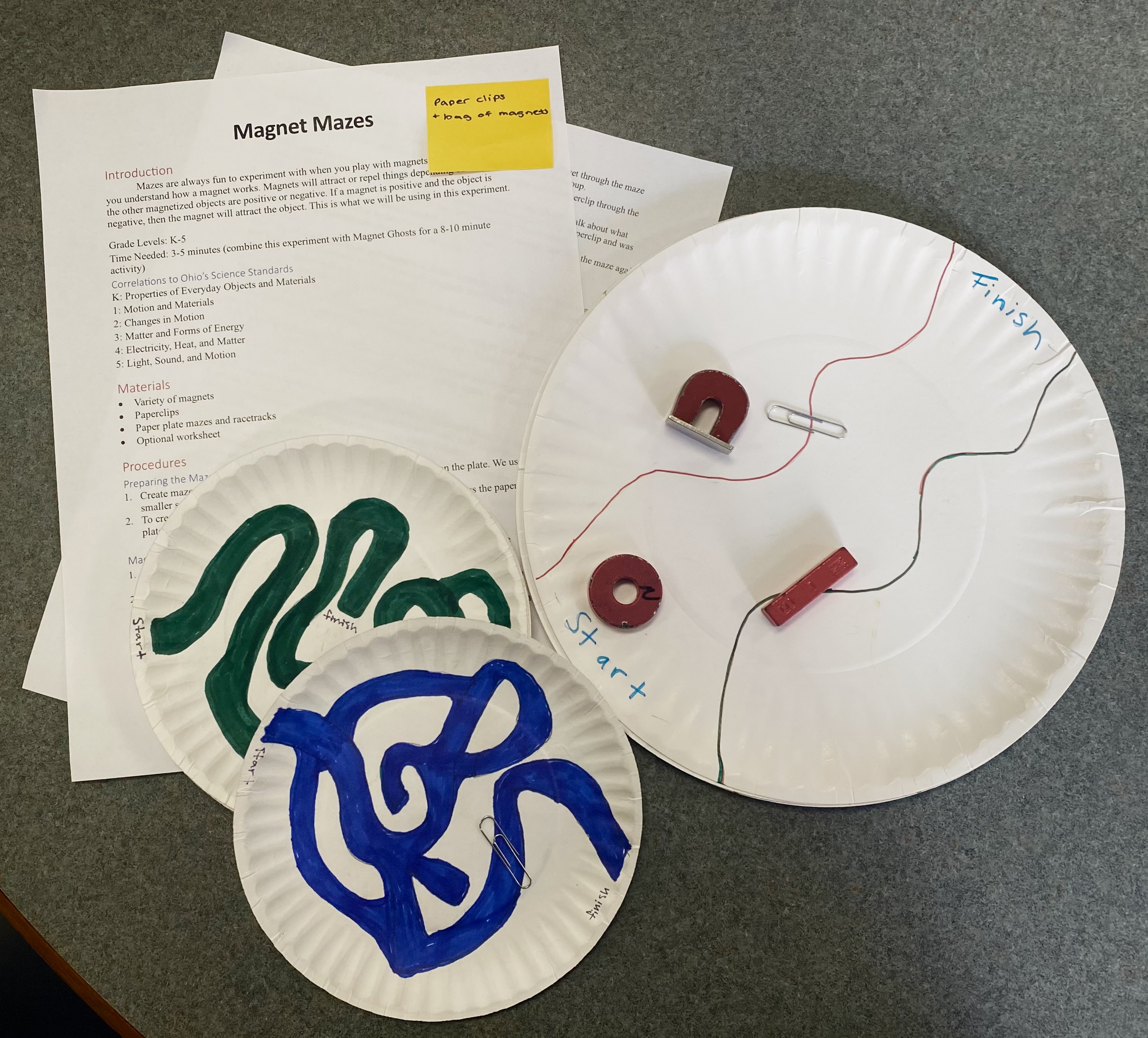
Magnet Mazes (Grades K-5; 3-5 minutes)
Mazes are always fun to experiment with when you play with magnets, as they can help students understand how a magnet works. This experiment tests the way magnets attract or repel things depending on whether the other magnetized objects are positive or negative.
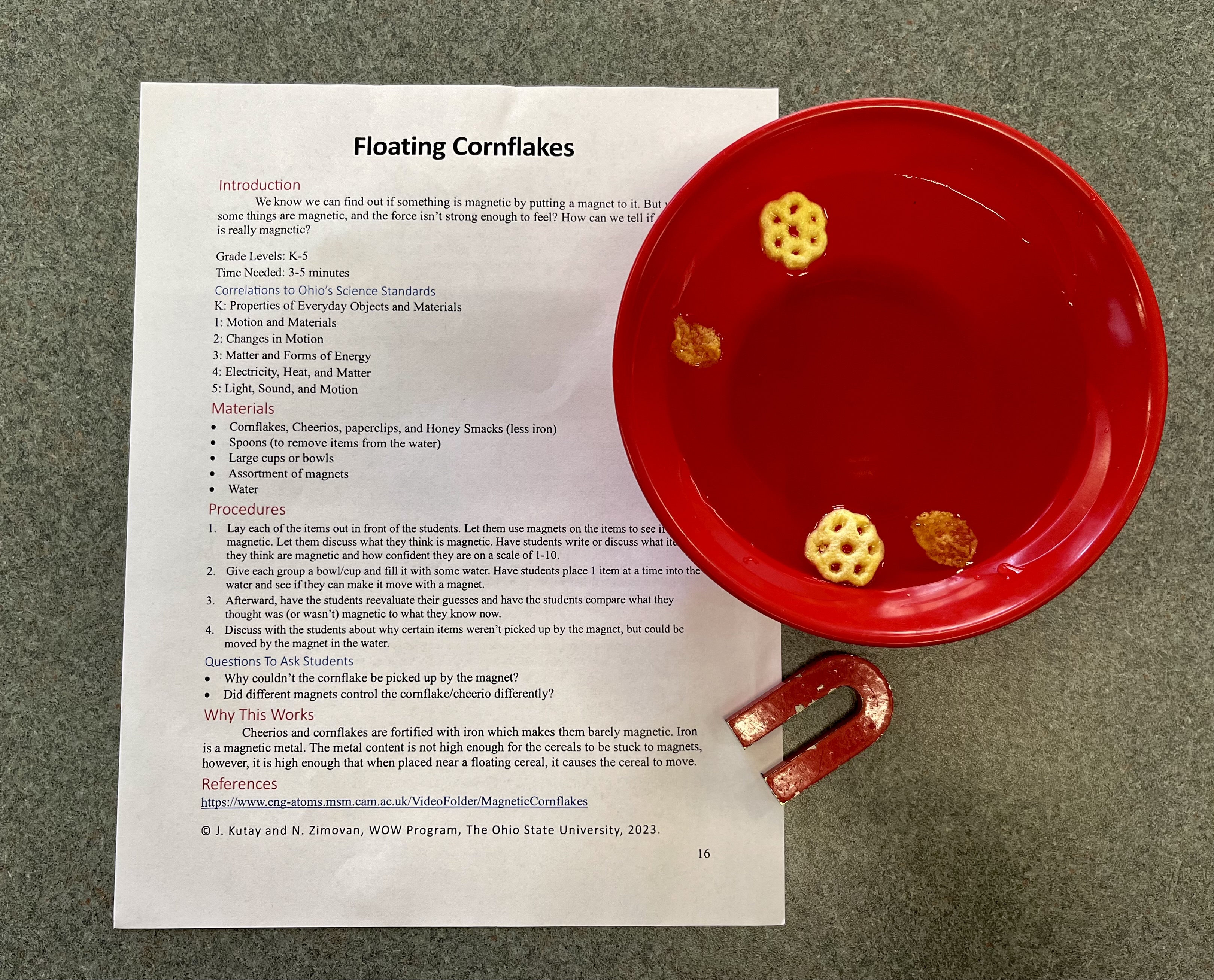
Floating Cornflakes (Grades K-5; 3-5 minutes)
We know we can find out if something is magnetic by putting a magnet to it. This experiment looks at the question of what if things are magnetic, and the force isn’t strong enough to feel, and how we can tell if an object is really magnetic.
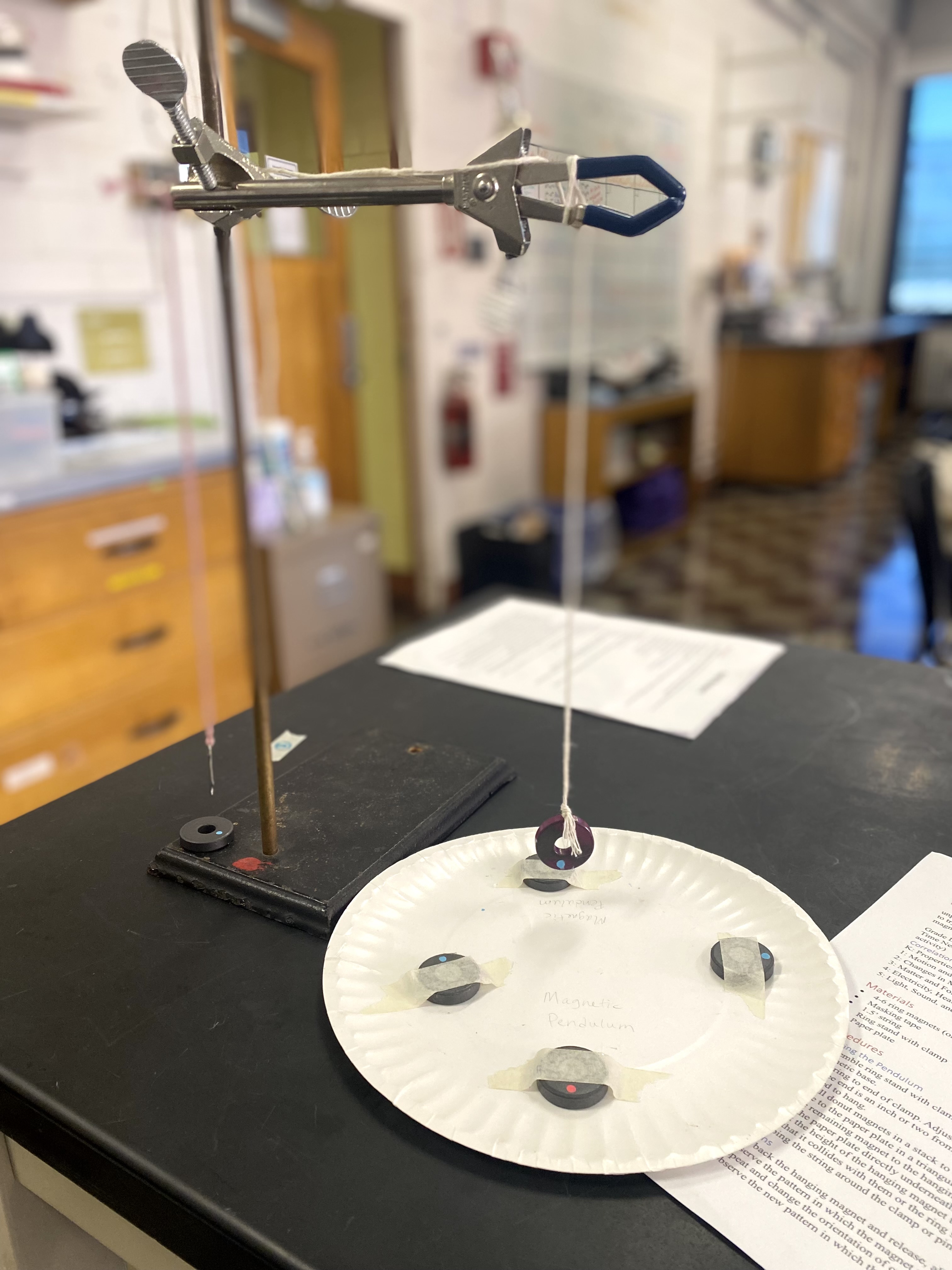
Magnetic Pendulum (Grades K-5; 2-3 minutes)
Unpredictable motion is produced with the attraction and repulsion of magnets. Scientists use models called strange attractors to try to describe this order. In this experiment, students will work with a magnet pendulum, a magnet swinging over a few fixed magnets.
Field Blockers (Grades K-5; 2-3 minutes)
We know only some materials can let an electric current flow through themselves—we call them conductors. This experiment tests if there are any materials able to channel magnetic field.
For the second or third year a school is in WOW, the WOW Programs will actual begin with the Measurement Unit instead of the Scientific Method Unit. This unit is more math focused, but the tools learned here are helpful in data collection and analysis for science experiments.
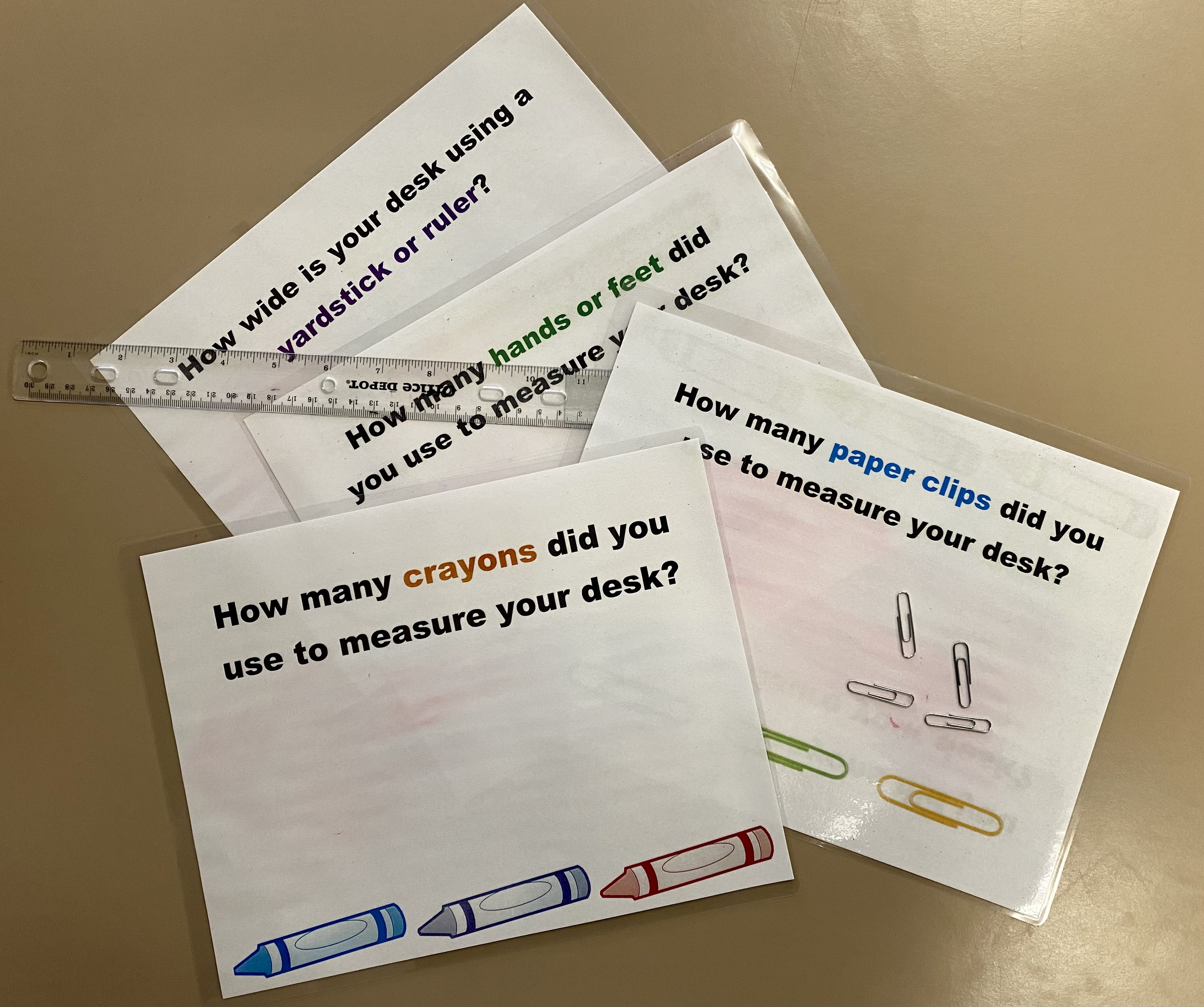
Measuring with Rulers/Crayons/Paper Clips (Grades K-3; 15 minutes)
Measurement began in ancient times when people needed a way to keep the trading of goods fair. Early measurement was definitely an improvement from no measurement, but it still had some problems. Often, body parts such as feet were used to make measurements. Not all feet are the same size, so measurements made with peoples’ feet were not consistent. Eventually a system of standard measurement developed, using constant values. This activity helps students understand why standard units of measurement are needed.
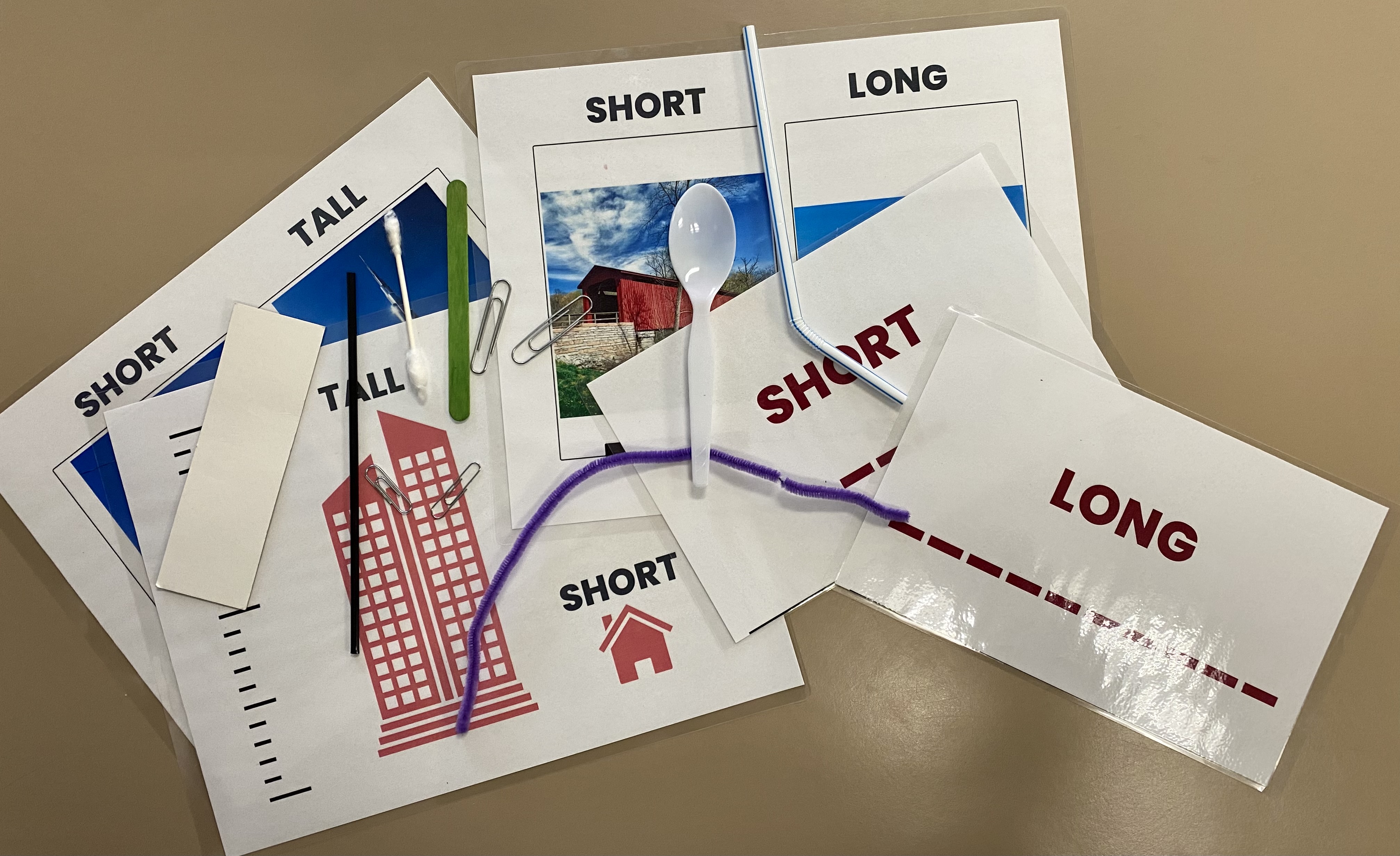
Sizing Things Up (Grades K-2; 15-20 minutes)
Measurement is an important part of life for people of all ages, as it provides necessary information for the other stages of scientific investigation. This exercise promotes basic measuring skills with simple ordering and categorization activities.
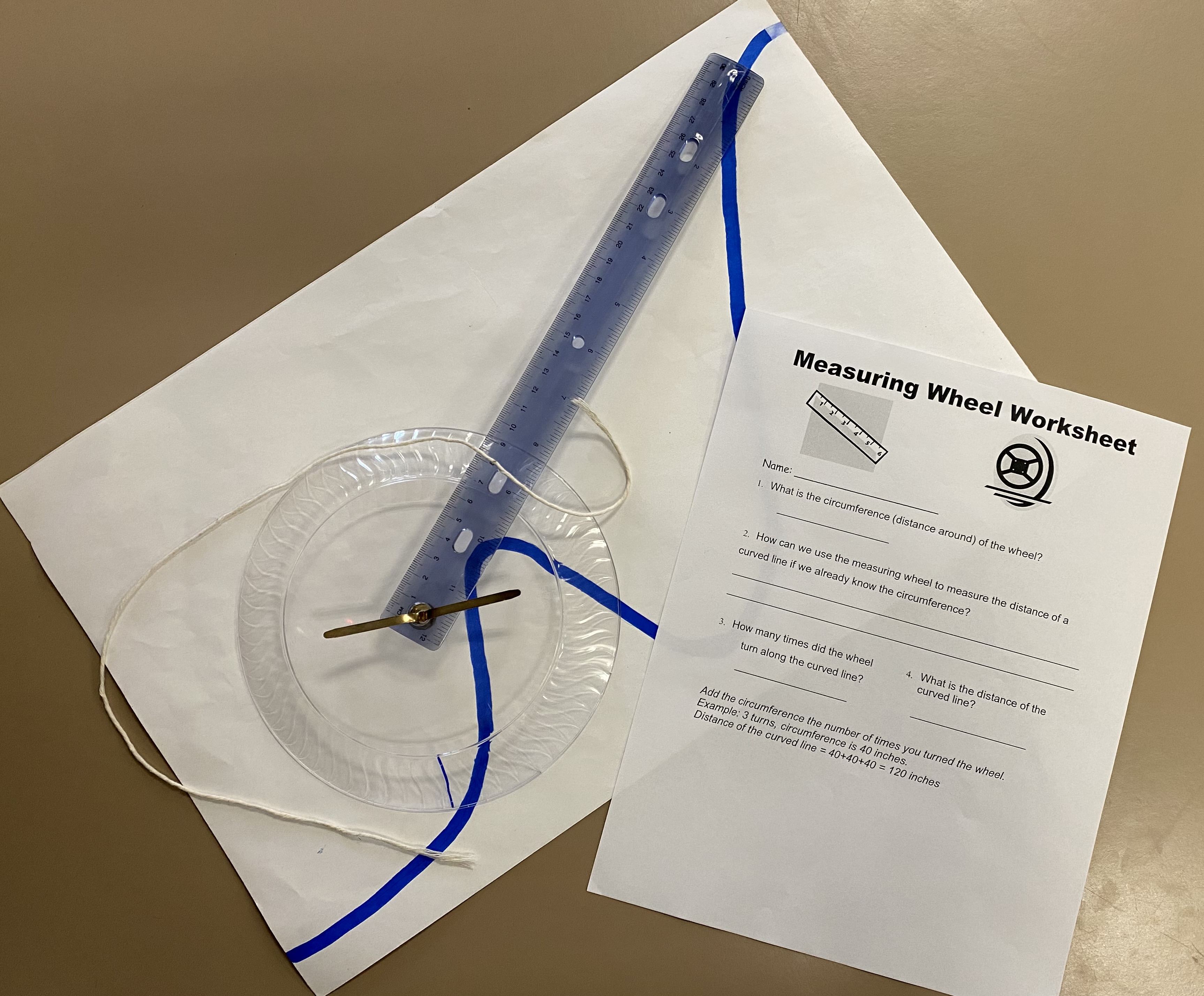
Measuring Wheel (Grades 1-4; 15-20 minutes)
Measuring the length of a straight line is easy; the only equipment necessary is a ruler. Determining the length of curvy lines seems more difficult but can be just as simple with the proper tools. A measuring wheel can trace winding paths to measure their lengths, so construction and the use of a measuring wheel will be described in this activity.
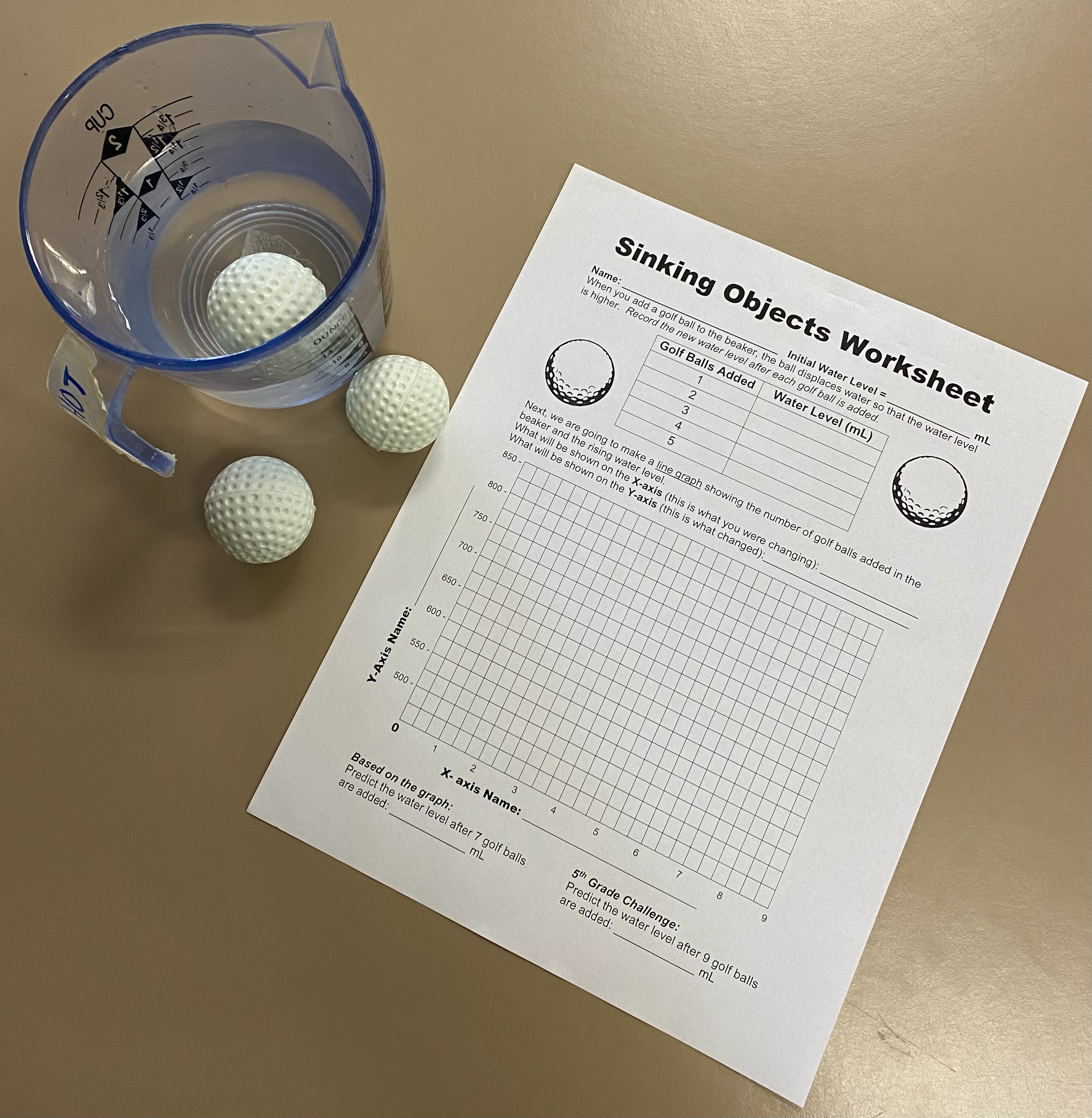
Sinking Objects (Grades 2-5; 15-20 minutes)
This experiment illustrates making measurements and seeking patterns. Students will collect data, prepare a graph, and interpret the data and graph in order to determine a relationship between the measured water level and number of sunken objects.
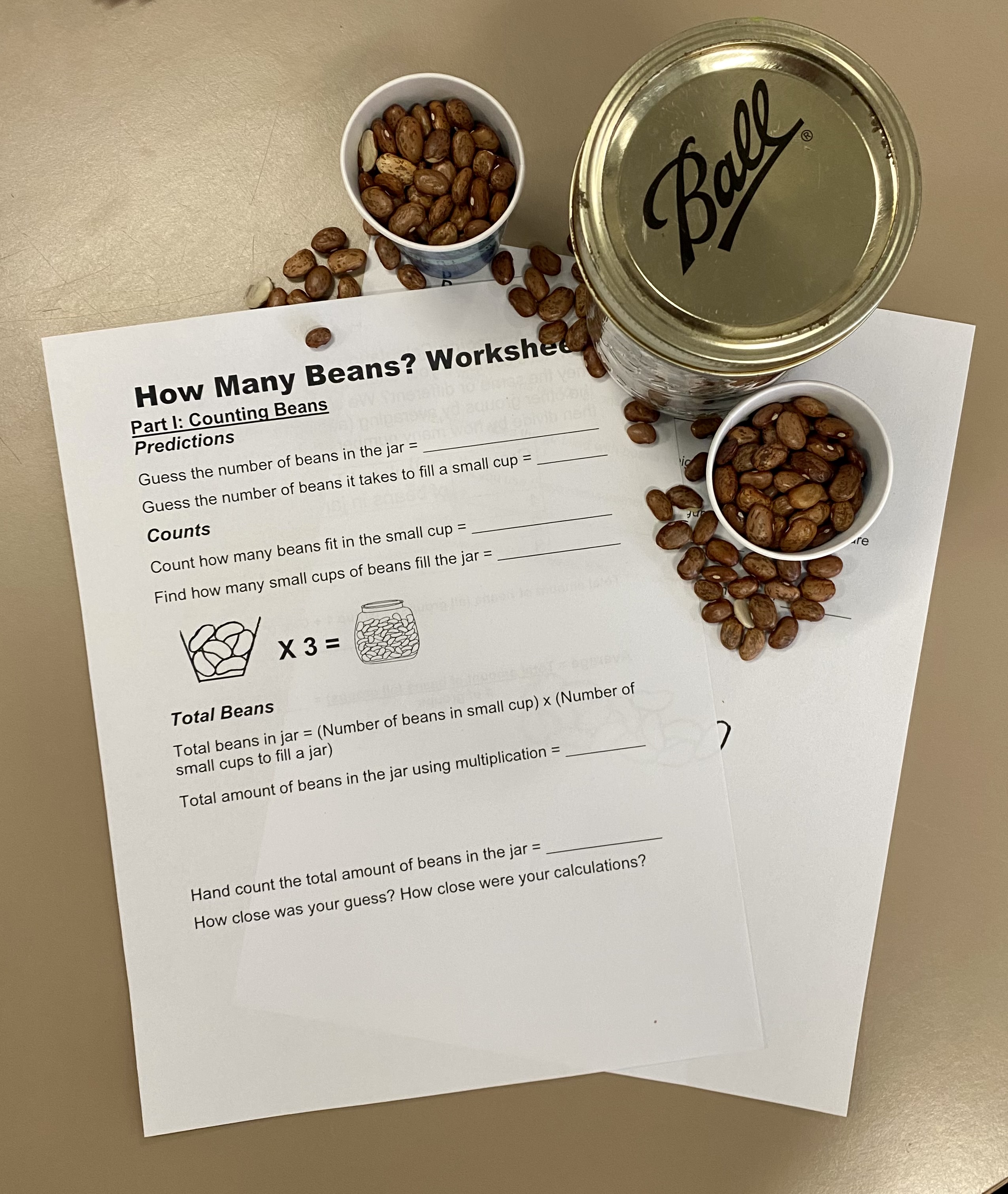
How Many Beans? (Grades 3-5; 25 minutes)
Is counting all the beans in a large container the best way to determine the amount? In this experiment students will make observations and measurements on a large container filled with beans. Students will measure the number of beans by using a scale, and they will estimate the average number in the jar.
The Physics Unit will be implemented into the WOW Program visits once throughout the school's three year duration with the program. Teachers will select experiments to total 45 minutes to an hour in length.
The Physics Unit will explore the ways in which the world around us works through concepts of motion, energy, and matter. Students will learn about gravity, the basic ideas of Newtons Laws of Motion, and other conceptual topics such as friction and tension.
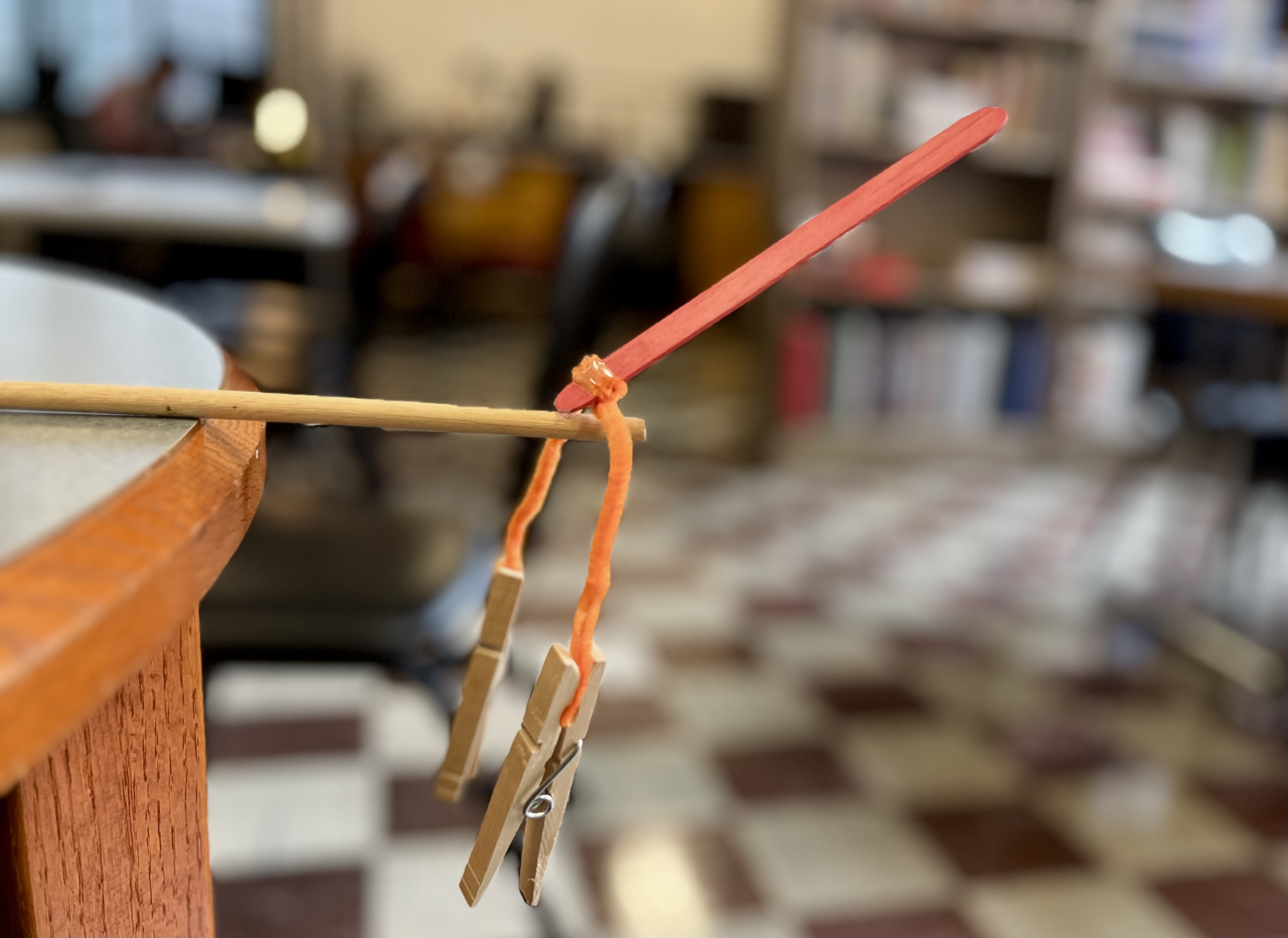
All About Gravity (Grades K-5; 5-10 minutes)
Gravity is a force that attracts things – it is why objects fall to the ground and why we can walk on the ground (simply put, we are attracted to the Earth!). The attraction strength depends on the mass of the two objects and the distance between them. The greater the mass, the greater the attraction. In this lesson, students will get a hands-on look about how the force of gravity works by experimenting with objects and finding their center of gravity.
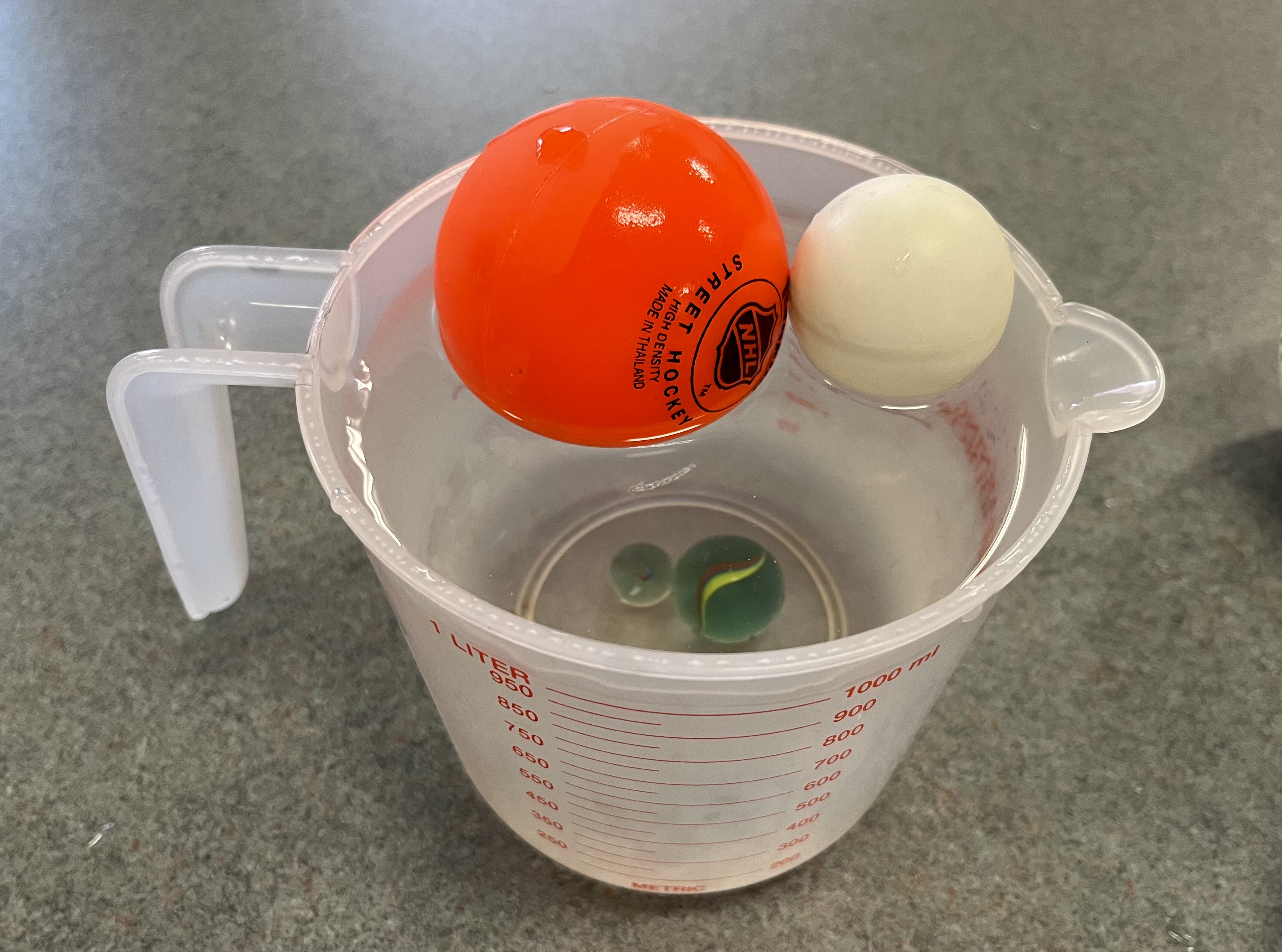
Sink or Float (Grades K-5; 5-10 minutes)
To understand whether something will sink or float, you must understand density. Density is how much of something (weight) is packed into a space (volume). When an object has a higher density than water, it will sink; and if the object has a lower density, it will float. In this experiment, students will learn why some objects sink and some objects float by observing the behavior of different household items in water. Students will consider if the weight and size of the objects will affect their behavior.
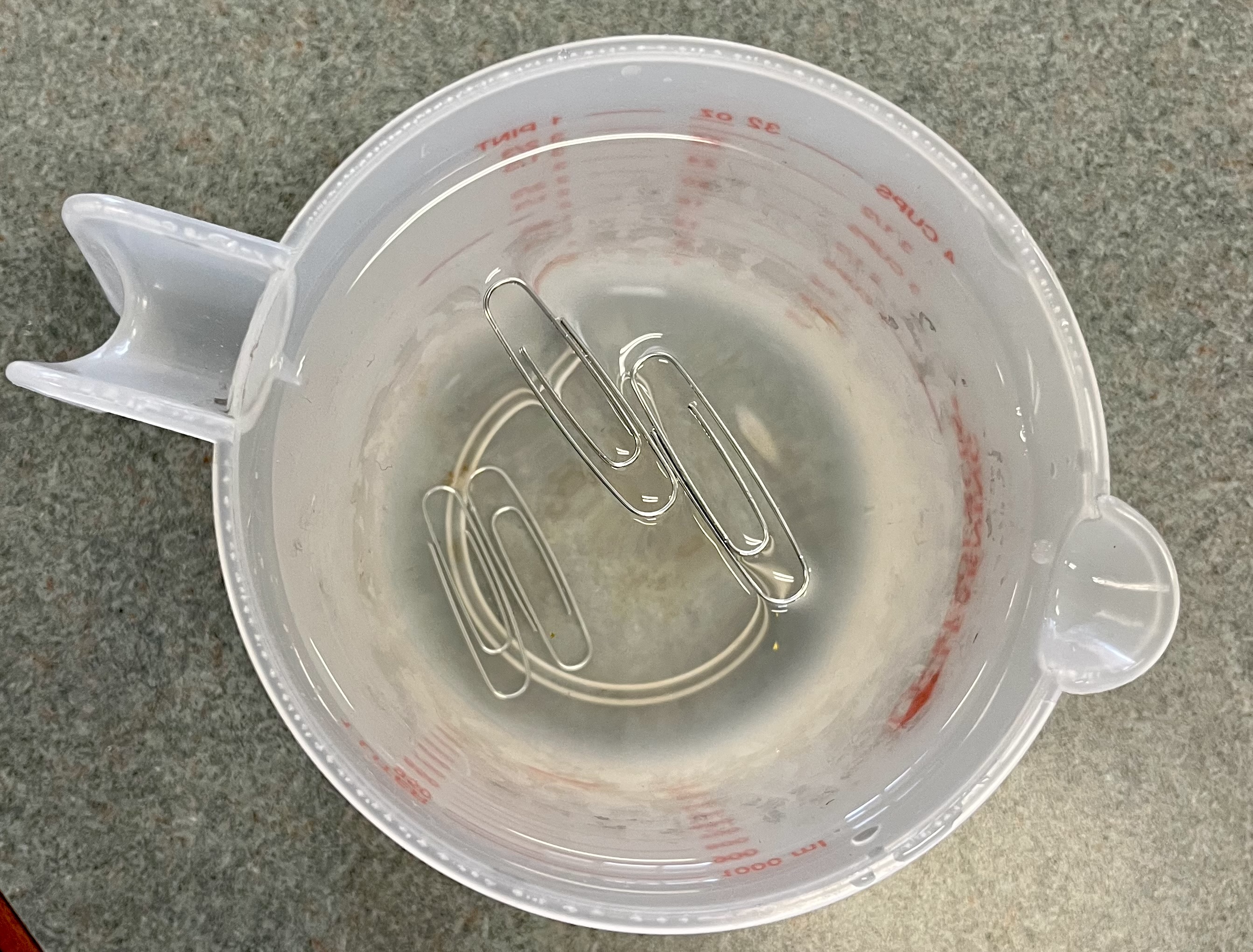
Paper Clip Sailing (Grades K-5; 5-10 minutes)
This experiment is to help students understand water surface tension, which is the tension created by the connections between molecules on the surface of the water. Students will explore this topic through experimenting with paperclips, water, and dish soap, and evaluating what conditions make the clip float and what conditions make it sink.
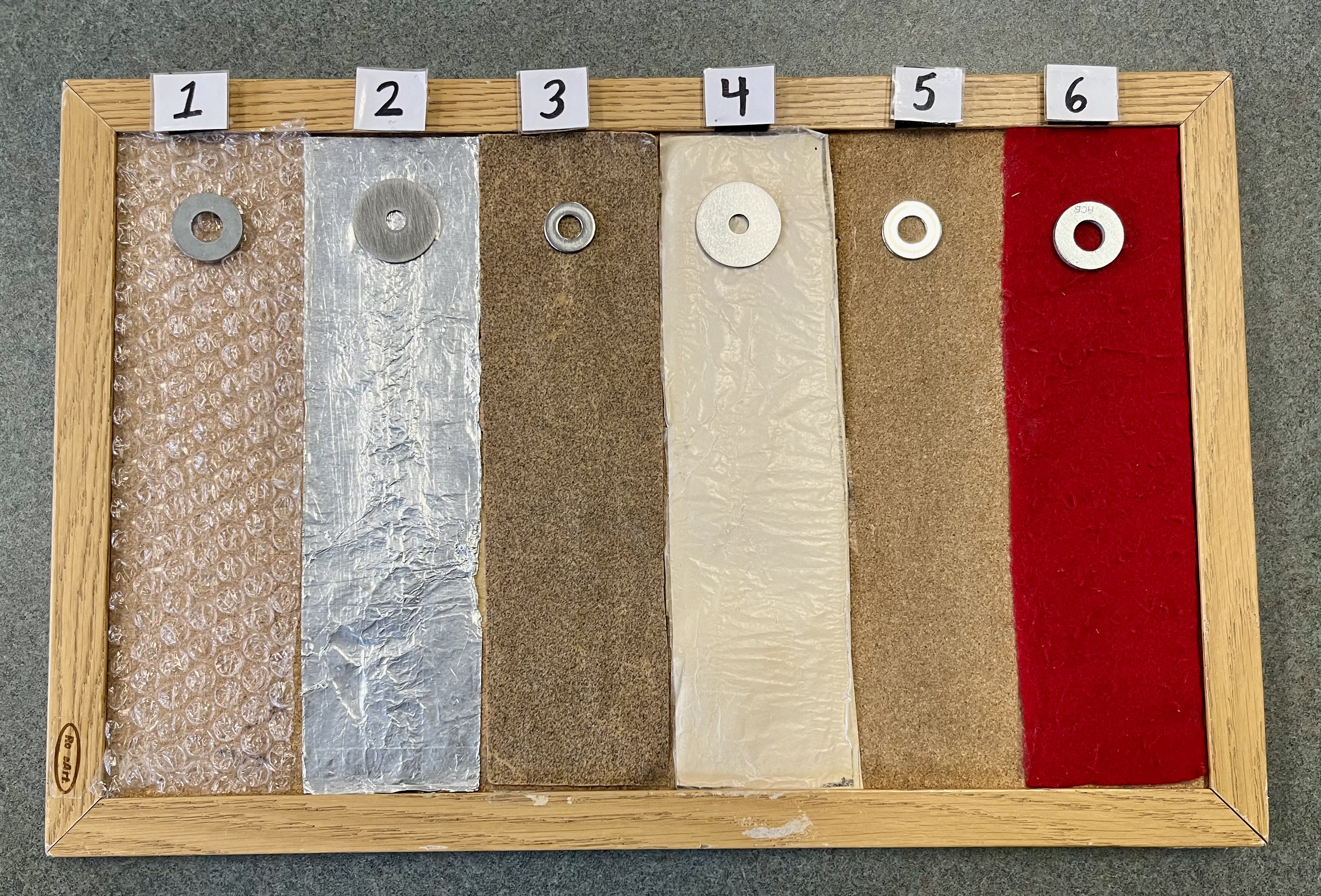
Friction Board (Grades K-5; 5-10 minutes)
Friction is a force that both resists motion and makes movement possible. Friction is the resisting force when two materials slide across each other. The types of materials affect the amount of frictional force. This hands-on experiment is designed so the students can test the effect various materials have on frictional force.
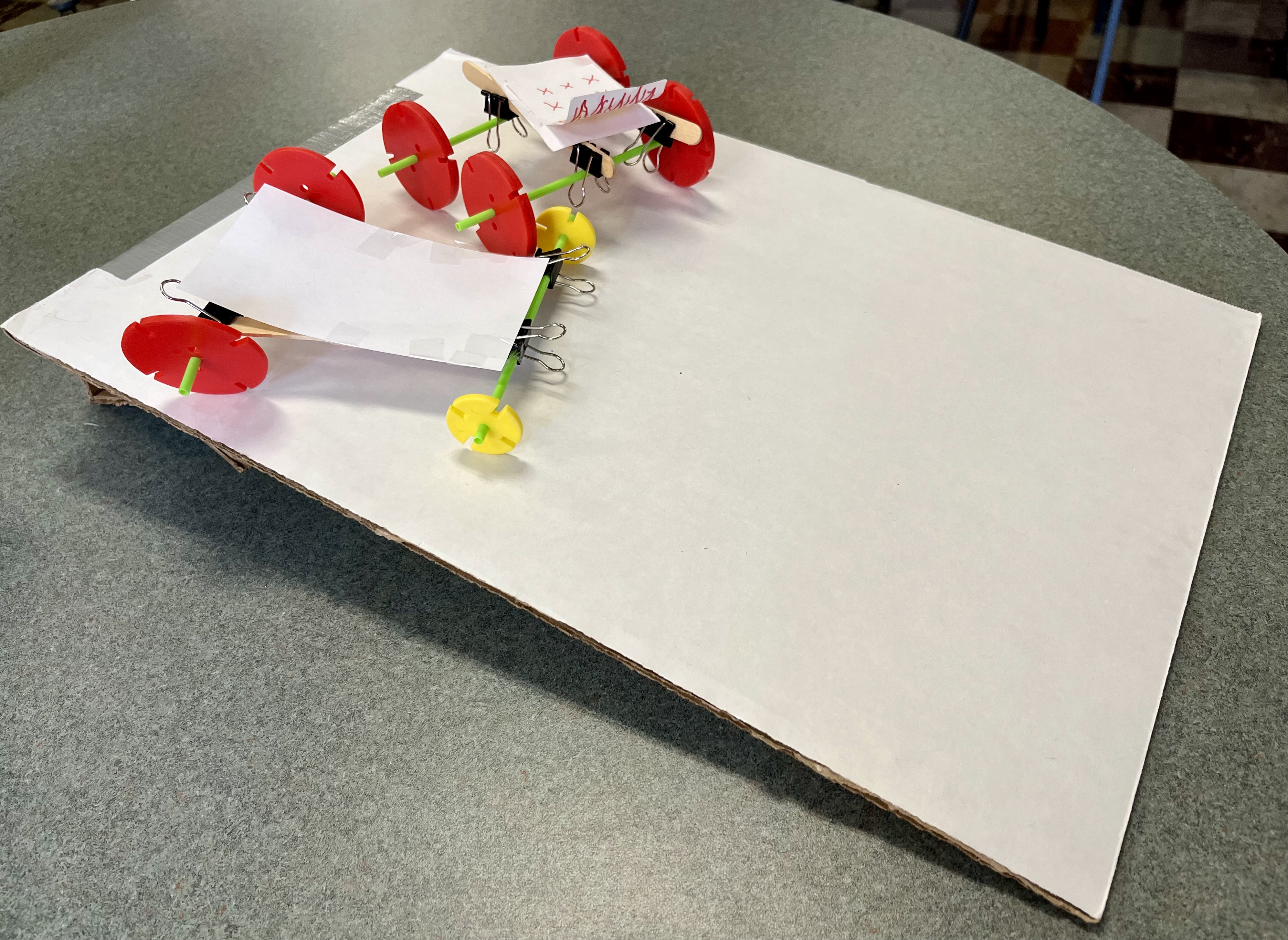
FOSS Test Motion (Grades K-5; 5-10 minutes)
This experiment teaches students about patterns of motion by creating and testing different wheels that are put on test cars. It has been modified/adapted from the FOSS (Full Option Science System) Next Generation Motion and Matter Module looking at patterns of motion. All credit for the idea, materials, etc belongs to them. Information presented here is from the teacher resources and investigation booklet.
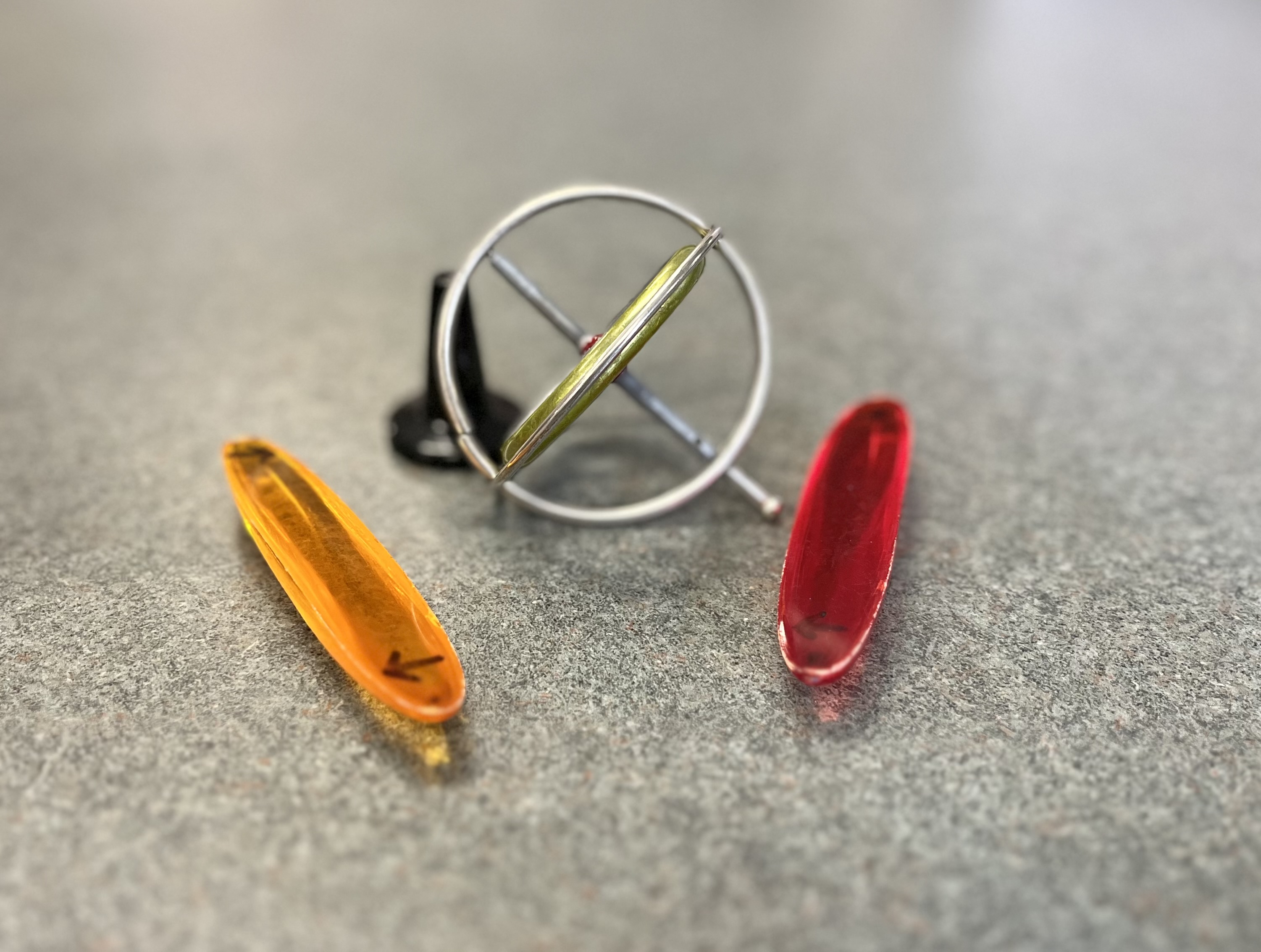
Rotating Objects (Grades 2-5; 5-10 minutes)
In these activities, students will explore what happens when an object is spun and see some surprising results. This hands-on experiment looks at gyroscopes and rattle backs, which allows students to learn about momentum and rotation. The rattlebacks are additionally created by the student's using spoons and clay, which also showcases how weight impacts the rotation and movement of objects.
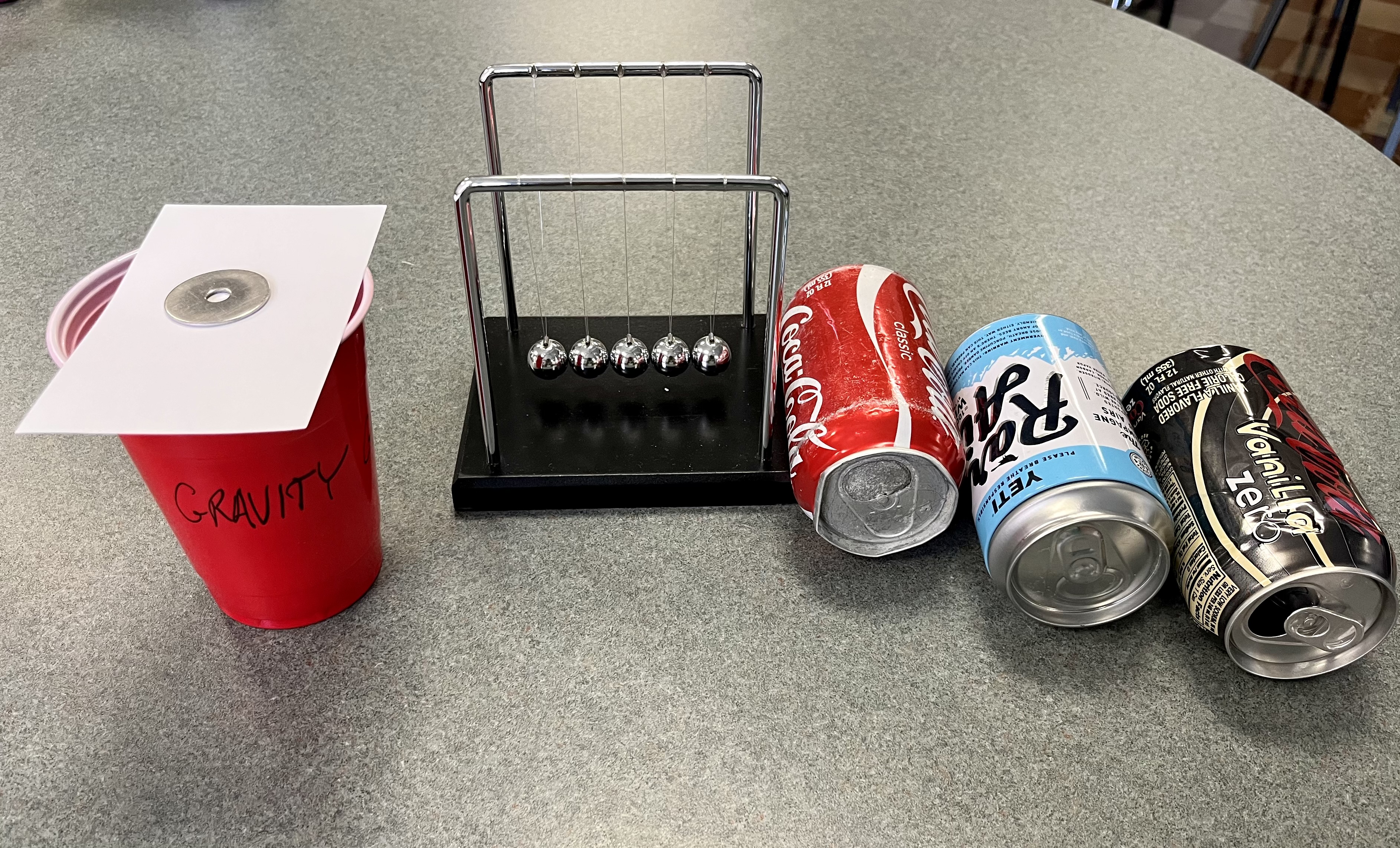
Newton’s Three Laws (Grades 2-5; 5-10 minutes)
This three-part experiment teaches students all about forces through hands-on activities and various demonstrations. Students learn about all three of Newton's Laws which include topics such as inertia, applied forces, and reactions from actions.
The Plants and Seeds Unit will be implemented into the WOW Program visits once throughout the school's three year duration with the program.
For grades K-3, there will be 3 stations of 3 experiments with a 15 minute duration for each experiment - the class can be broken up into 6 groups, 2 stations will have the same experiment with the students only rotating to 3 stations total. For grades 3-5, teachers can select the Diversity of Plants experiment to have 5 stations of a variety of diverse plants from all over the world. Students will rotate to every station. Grades 3-5 teachers can also select the 3 stations instead of the Diversity of Plants experiment stations.
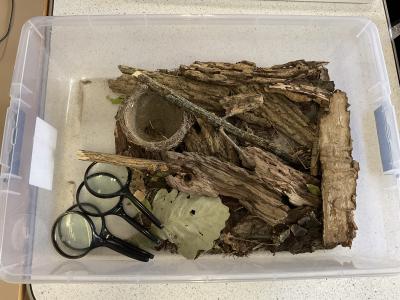
Trees As Habitats (Grades K-5; 10-15 minutes)
From leafy branches to tangled roots, trees provide a habitat for many plants and animals. In this activity, students will discover how plants and animals depend on trees in many ways.
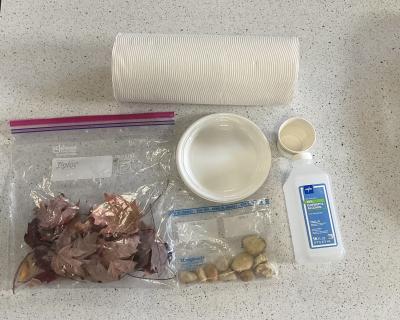
Leaf Chromatography (Grades K-5; 10-15 minutes)
Have you ever wondered why leaves change color during autumn? This experiment helps discover the pigments found in leaves to answer that question
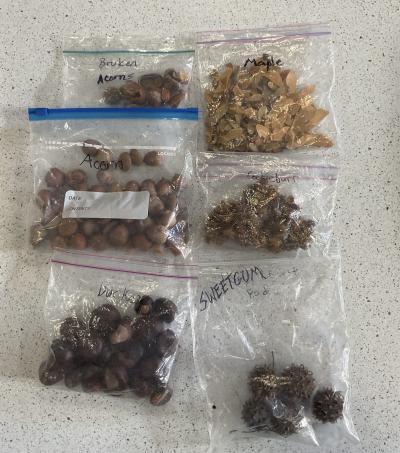
Traveling Seeds (Grades 2-5; 10-15 minutes)
How do plants grow in all different places? How does their seeds travel so far!? Seeds travel many different ways, some of those ways are by wind, water, hitchhiking, eaten and excreted by animals, carried but not eaten, or plant dispersed. This experiment will allow your children to learn the different ways different kinds of seeds travel and how they travel.
Diversity of Plants (Grades 3-5; 45 minutes)
For this set of experiments, we borrow a diverse variety of plants from the OSU Biological Sciences Greenhouse. These plants represent different habitats or have unique adaptations to survive. What better way to connect with nature then by doing it with plants! When most people think of nature, they think of outside, but what if we could bring the outside in? With this experiment you can! There are many different types of plants. Some plants are aquatic, while others are terrestrial. Some like hot weather while others prefer cold weather. Also, all of our bugs and creepy crawlies rely on plants!
Nothing gets bigger than the cosmos, and unlike many of our other units, the subject of space has few direct experiences for students to draw on, other than the presence of the sun and moon in our earthly sky. All the experiments and activities that make up the WOW Space Unit provide clear, hands-on activities that represent complicated subjects, like galaxy structure and moon landers, simply, so that students can easily learn about some fascinating space science.
The Space Unit will be implemented into the WOW Program visits once throughout the school's three year duration with the program. All experiments below will take place during our WOW visit. All experiments are 5-10 minutes in length and for grades K-5.
Cheerio Planets, Gravity and Spiral Galaxies
The existence of gravity, its role in the formation of the solar system, and the big picture of spiral galaxies can all be a little abstract for school kids, but with these simple experiments—which involve breakfast cereal, marbles and good old baking soda—some pretty abstract forms of the universe are made tangible for students.
Oreo Moon Phases
Kids usually have some conception lunar phases, sometimes more so in the older classes than the young, but by working together to replicate the moon’s changes with the cream and cookie of an Oreo, the idea sticks kids minds as well as their hands.
Craters of the Moon and Touchdown NASA
Hard to see with the naked eye, the numerous craters on the surface of the moon are the result of meteor impacts, which we help children grasp with a hands on activity involving a homemade moon surface. This is followed by an investigation of what makes a moon lander spacecraft land safely with homemade prototypes for the testing.
Size and Distance of the Planets
The cosmic size of our solar system’s planets, and the stretches of space between them, is a difficult idea to grasp. These experiments proportionally convert the space giants to a household scale. The difference in planet size is made clear with Play-Doh, and the stretch between the planets is exemplified with a measured length of toilet paper.
Constellation Exploration
Bad weather and light pollution can make stargazing a little more difficult to practice, but by working through our constellation activity, students can learn about the constellations visible in the night sky, and how to identify specific clusters with constellation detective worksheets.
The Sound Unit will be implemented into the WOW Program visits once throughout the school's three-year duration with the program. Teachers will select experiments to total 45 minutes to an hour in length.
Does a tree make sound even if you are not around to hear it? Are you always hearing sound even if you are in complete silence? The sound unit will explore the different ways that sound travels and how far it can travel. Students will learn about sound waves, how animals communicate using sound, and how we can see sound waves even if we do not hear them.
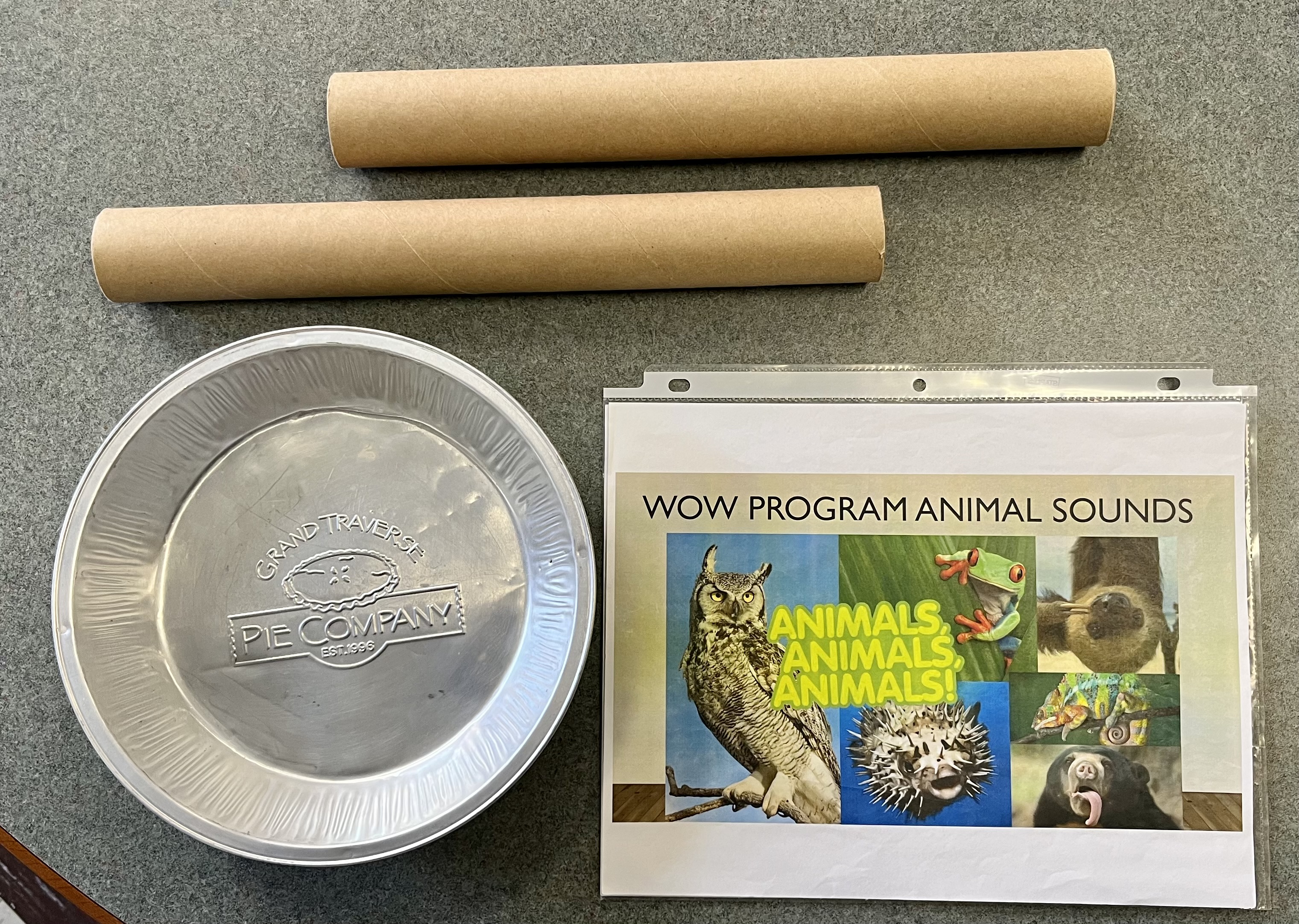
Animal Sounds/ Communication (Grades K-5; 5-10 minutes for each section)
Animals communicate in many ways: one form of communication that at times can be obvious is sound. They use sound every day to protect themselves from predators, locate prey, communicate about food & water, or even to find mates. For this experiment, students will play a guessing game with sounds on a PowerPoint to figure out what animal makes that sound. The second activity focuses on echolocation using paper towel tubes and an aluminum tin. Animals like dolphins, whales, and bats use echolocation to locate each other, predators, or their prey.
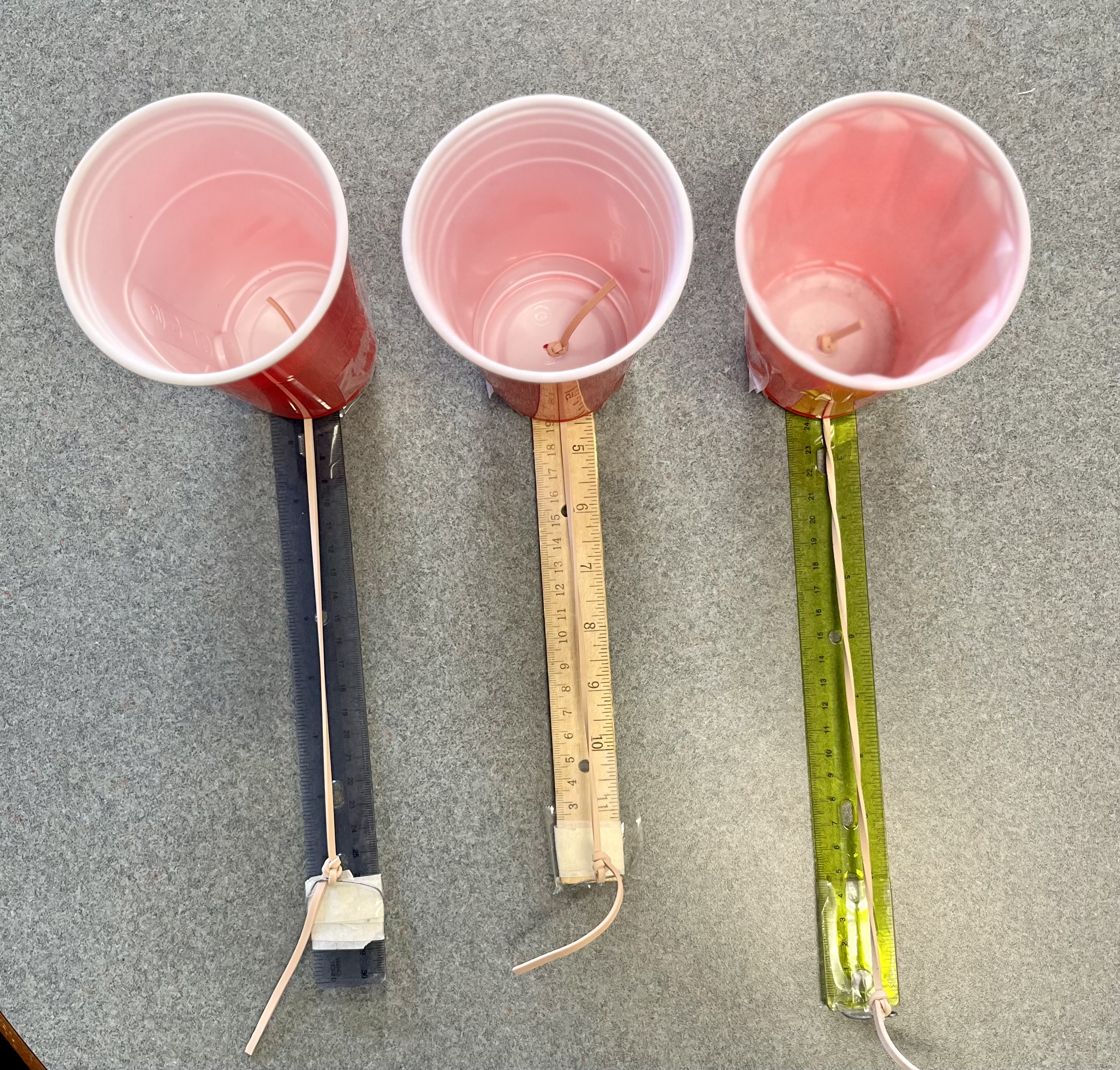
Pitch Switch (Grades K-5; 5-10 minutes)
Humans can hear a wide range of loudness, from the very quiet sounds of a whisper to the loud roar of a jet engine. We can also hear extremely slight differences in the highness and lowness. This characteristic of sound is called pitch. Some musical instruments, such as a piano or harp, have strings, each of which plays a different pitch. For this activity, students will use a plastic cup, string, and paperclip to listen to pitch.
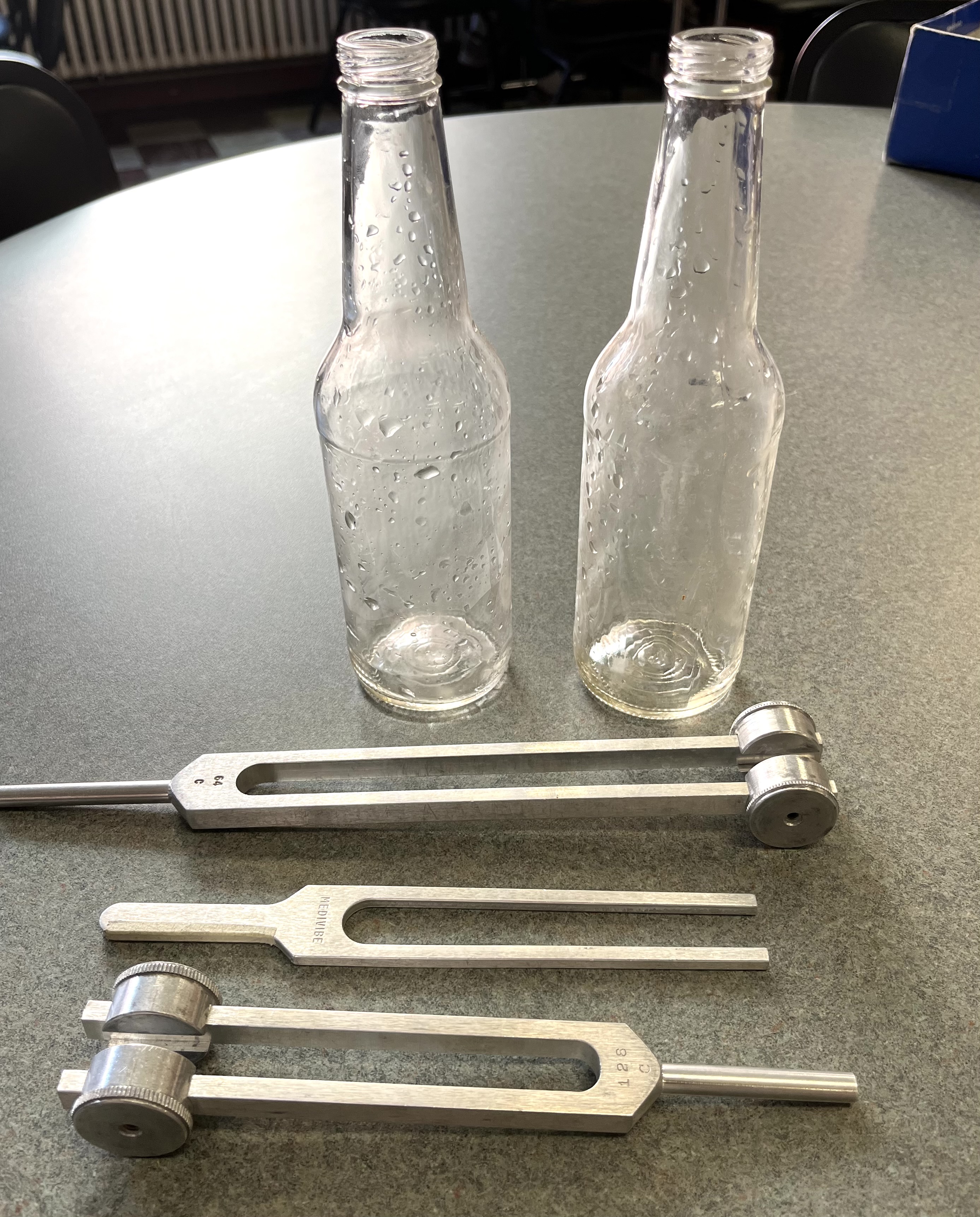
Frequency, Resonance, and Beats: Tuning Forks (Grades 3-5; 5 minutes for each part, 15-20 minutes total)
All objects have a natural frequency of vibration depending on their size and shape. When two objects have the same natural rate of vibration, the vibrations in air (sound) produced by one can make the other object vibrate. For example, if two guitars are tuned exactly the same, a string vibrating on one will cause the same string to vibrate on the other. The two instruments are said to be in resonance. These experiments use tuning forks and glass bottles to test frequencies and resonance.
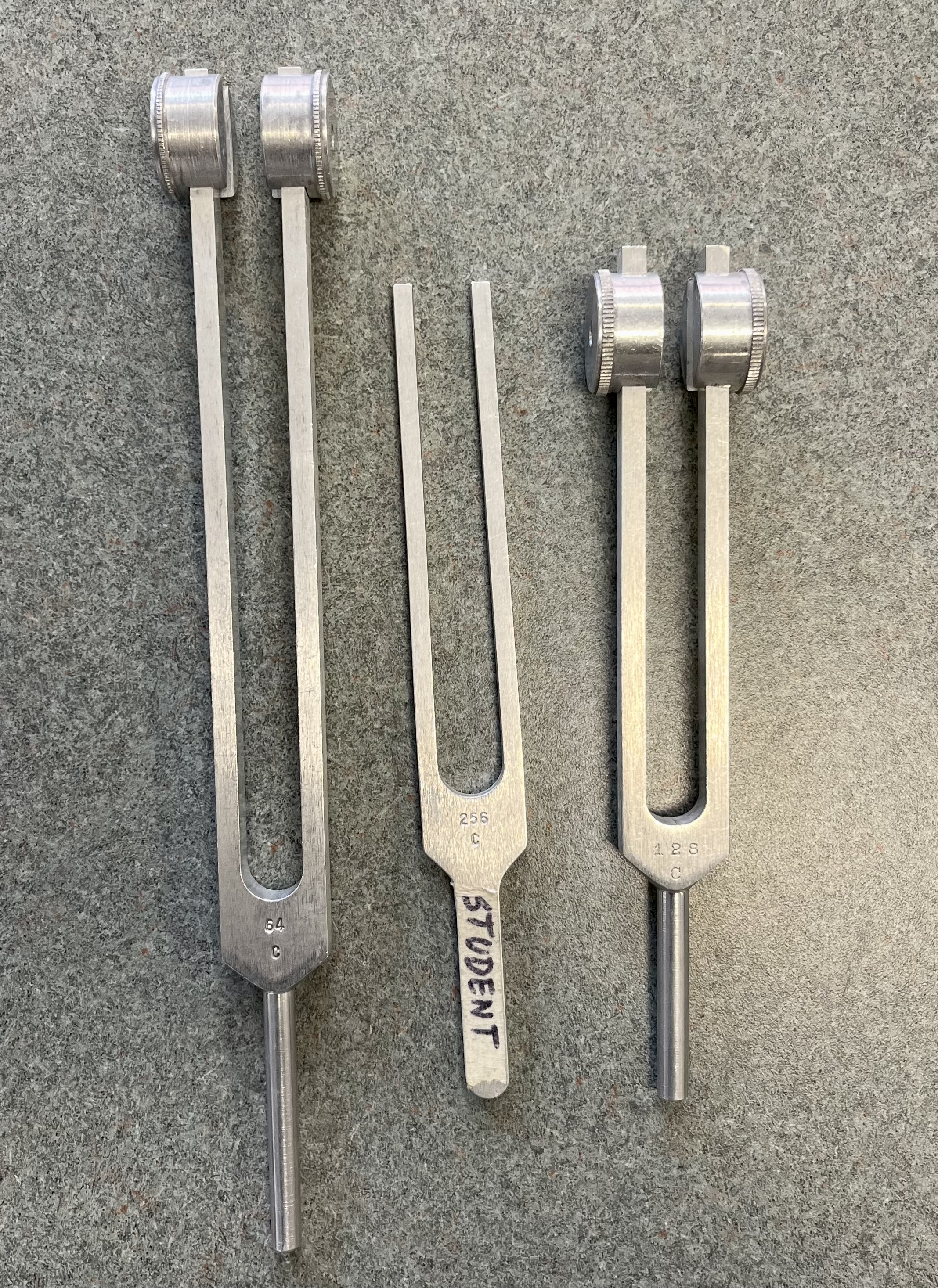
How We Hear (Grades K-3; 5-10 minutes)
This activity works in conjunction with Frequency, Resonance, and Beats to go a little more in-depth into the biology of how we hear. This will go into talking about how the ear works by demonstrating sound with tuning forks. The ear has two different components: one for tuning small vibrations and the other that detects the vibrations.
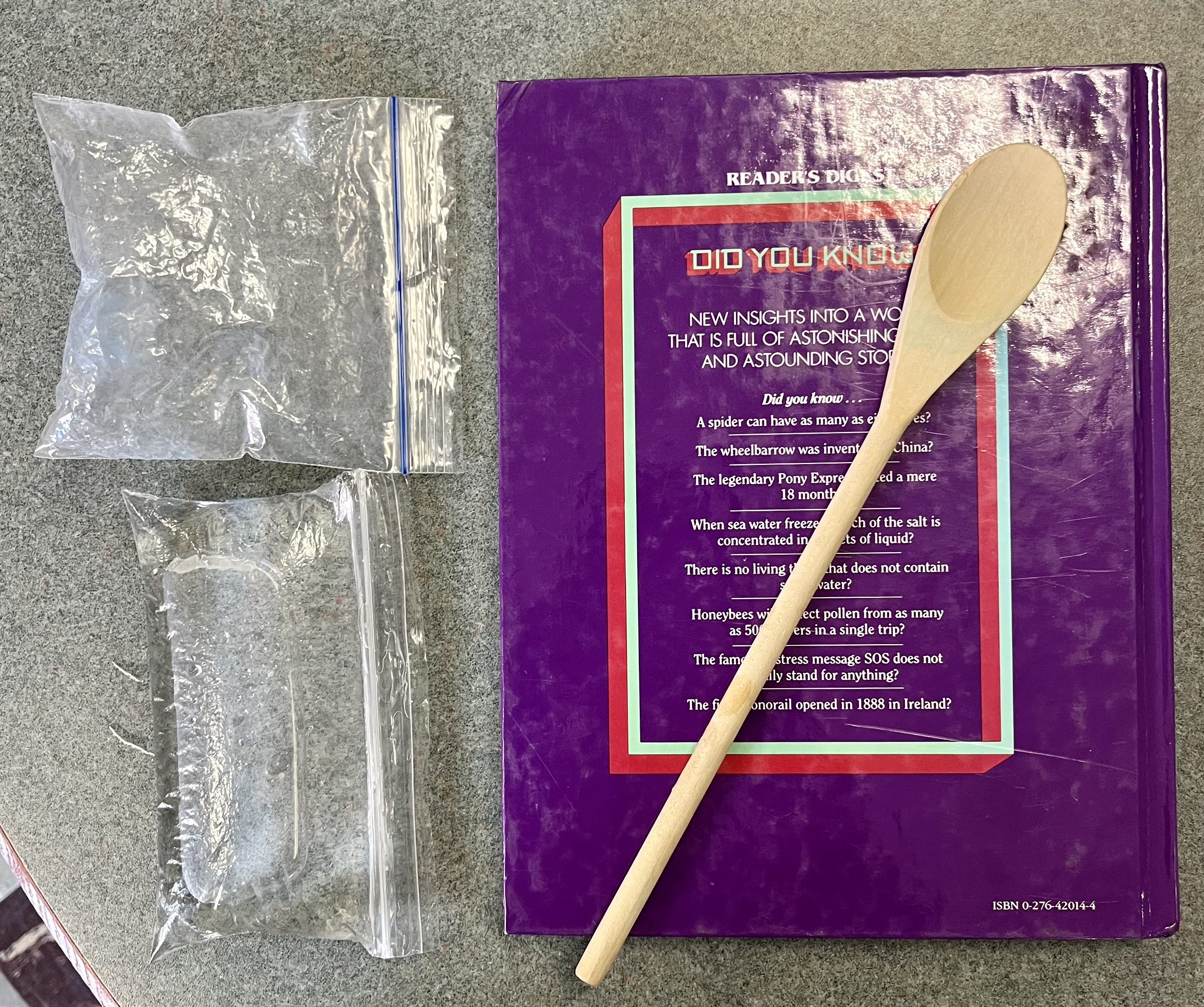
Travel of Sound Through Matter (Grades K-5; 5-10 minutes)
For sound to reach your ear, it usually travels through air. However, there are other ways sound can travel like through solids, liquids, and gases. Will there be a difference in sound based on the different states of matter it travels through? Students will find out this through this experiment.
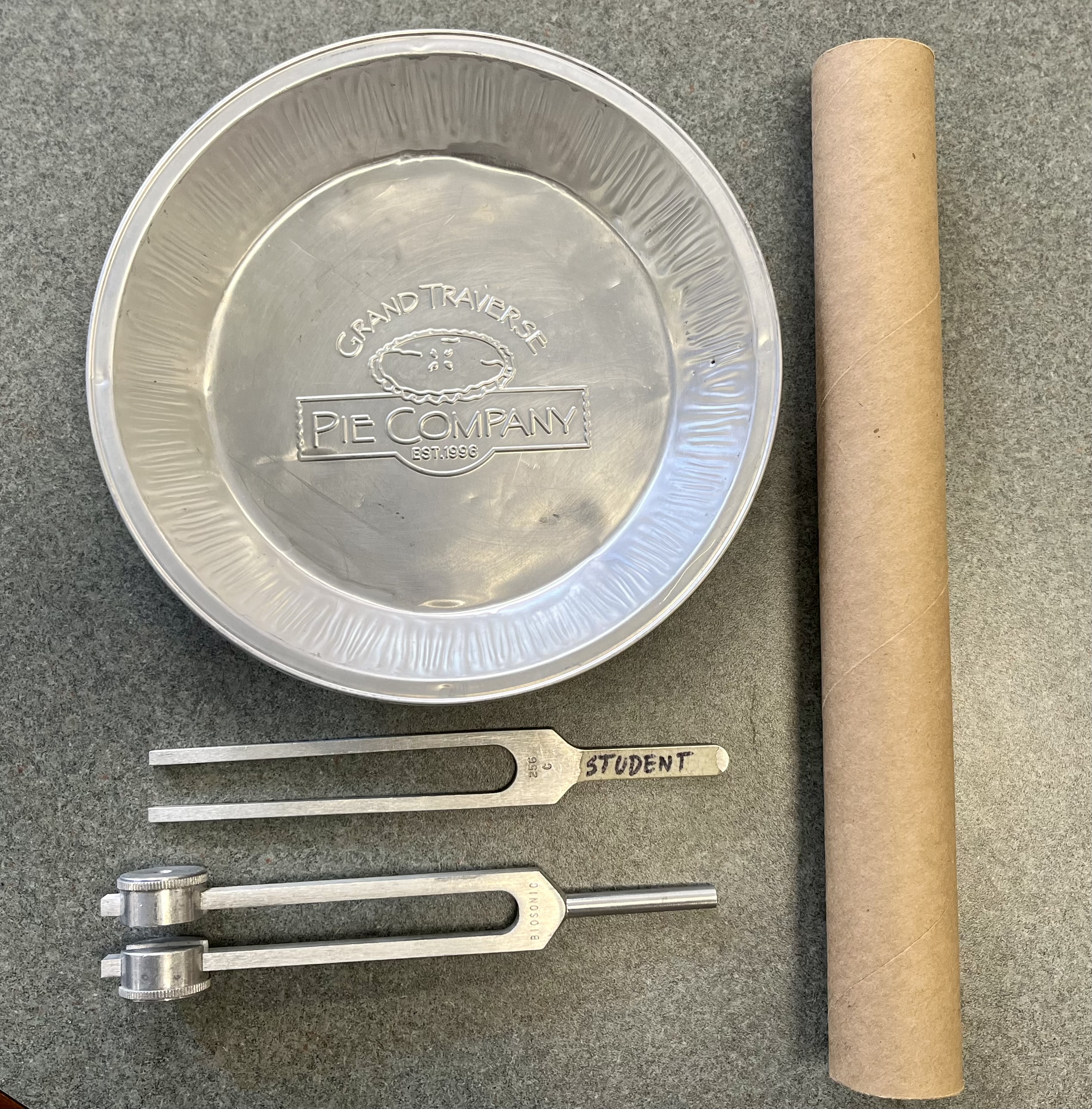
Bouncing Sound Waves (Grades 2-5; 5-10 minutes)
Some places, like school hallways or gyms, have loud echoes, while other places do not. Heavy brick walls seem to block almost all sound, while flimsy drywall walls are notorious for being easy to hear through. The goal of this experiment is to see what materials reflect sound well and transmit sound well, and what materials do not.
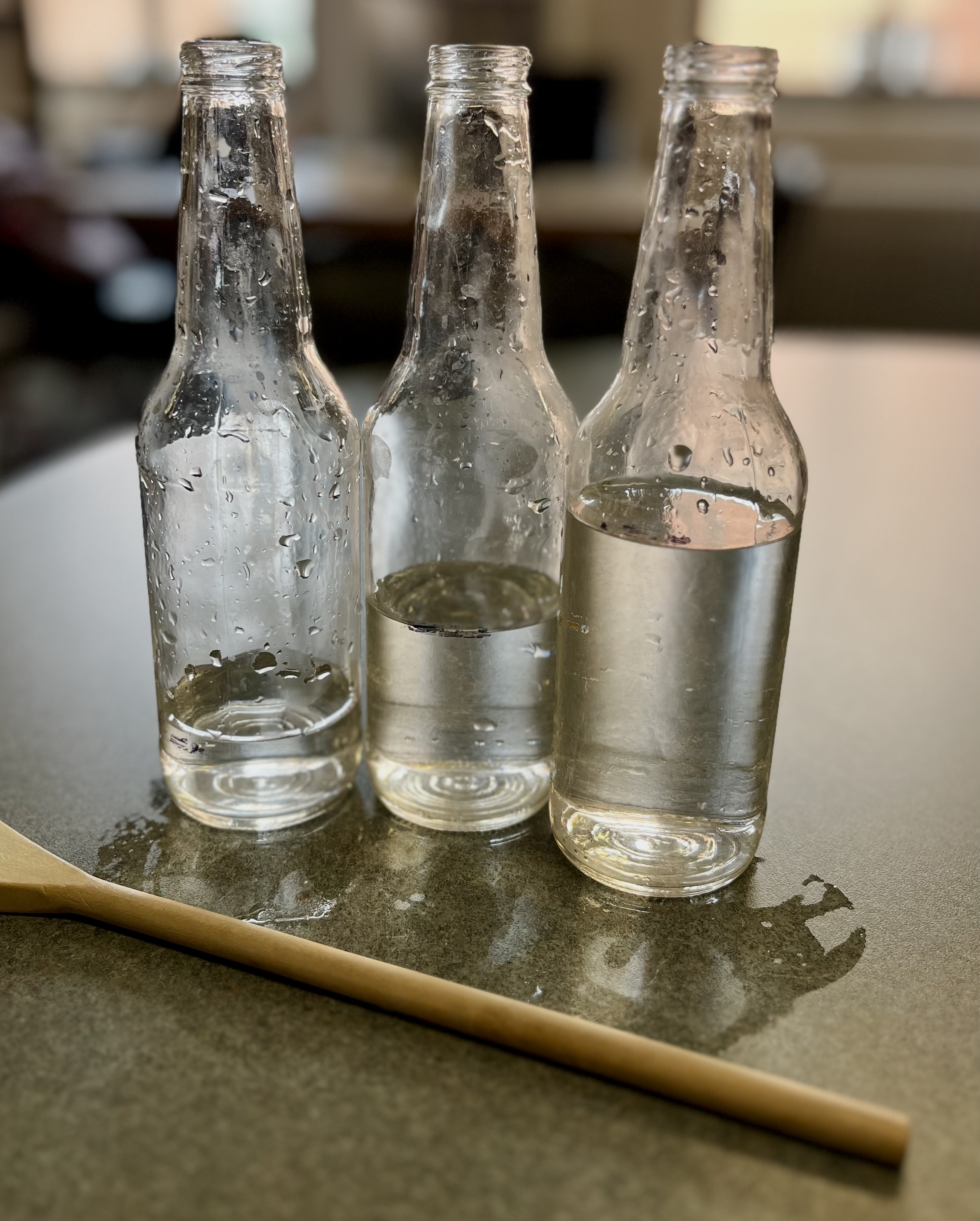
Bottle Sounds (Grades K-5; 5-10 minutes)
Sound is all about vibrations. The students will hear that the same bottle produces opposite sounds: the bottle that makes a low-pitched sound when you tap it makes a high-pitched sound when you blow across the top. If you vary the amounts of water in each bottle (and add more bottles), you could create a musical scale!
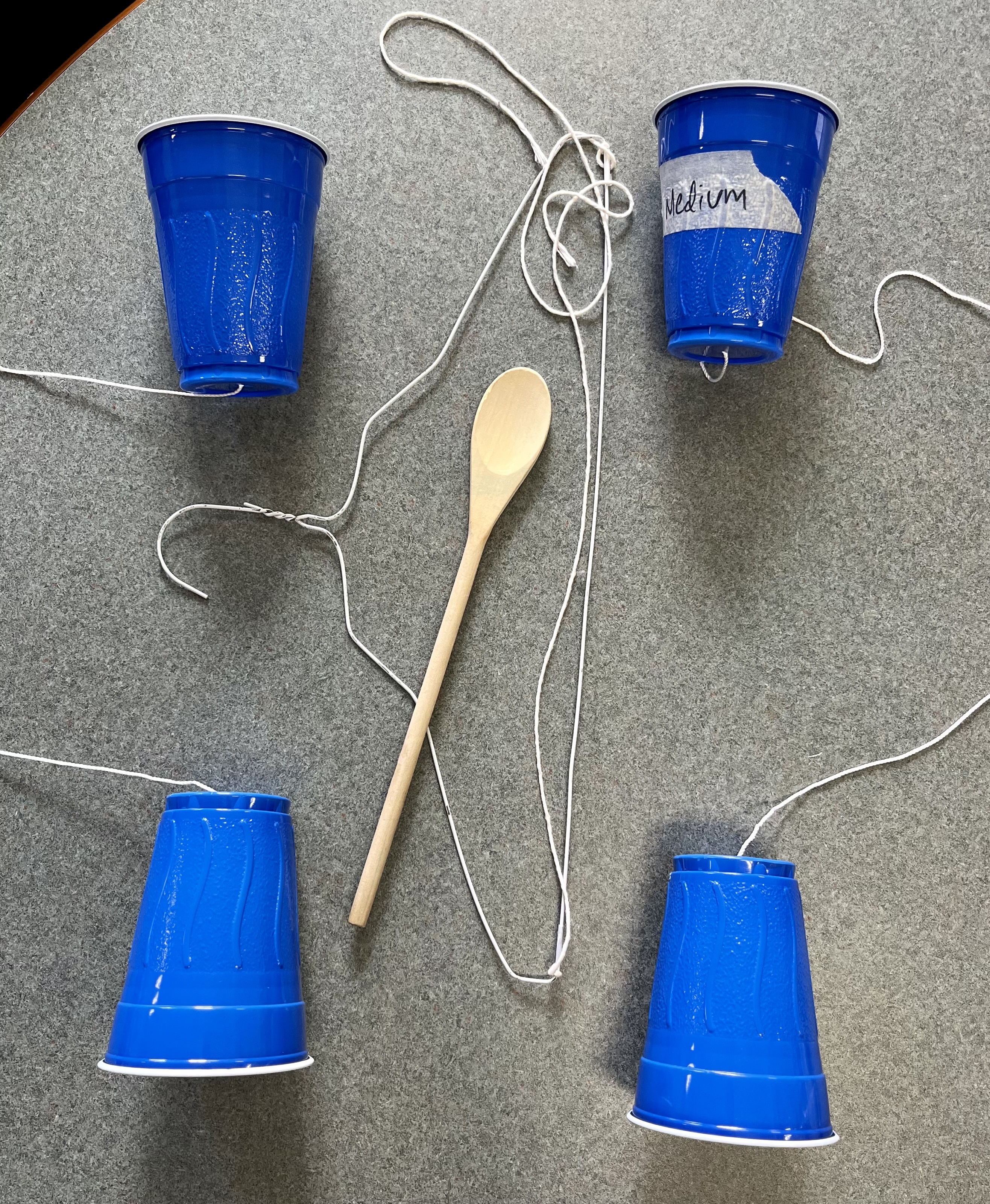
String Telephone and Coathanger Bell (Grades K-5; 15-20 minutes)
Though we are most familiar with sound in air, sound can also travel as vibrations through a string. Different phases of matter carry sounds at different speeds, as well as changing the intensity of the sound. These experiments allow students to investigate the changes in volume of sound depending upon the state of matter that sound travels.
In this unit, we will discover the phenomenon of weather and students will learn what causes different weather patterns. The Weather Unit will be implemented into the WOW Program visits once throughout the school's three year duration with the program. All experiments below will take place during our WOW visit.
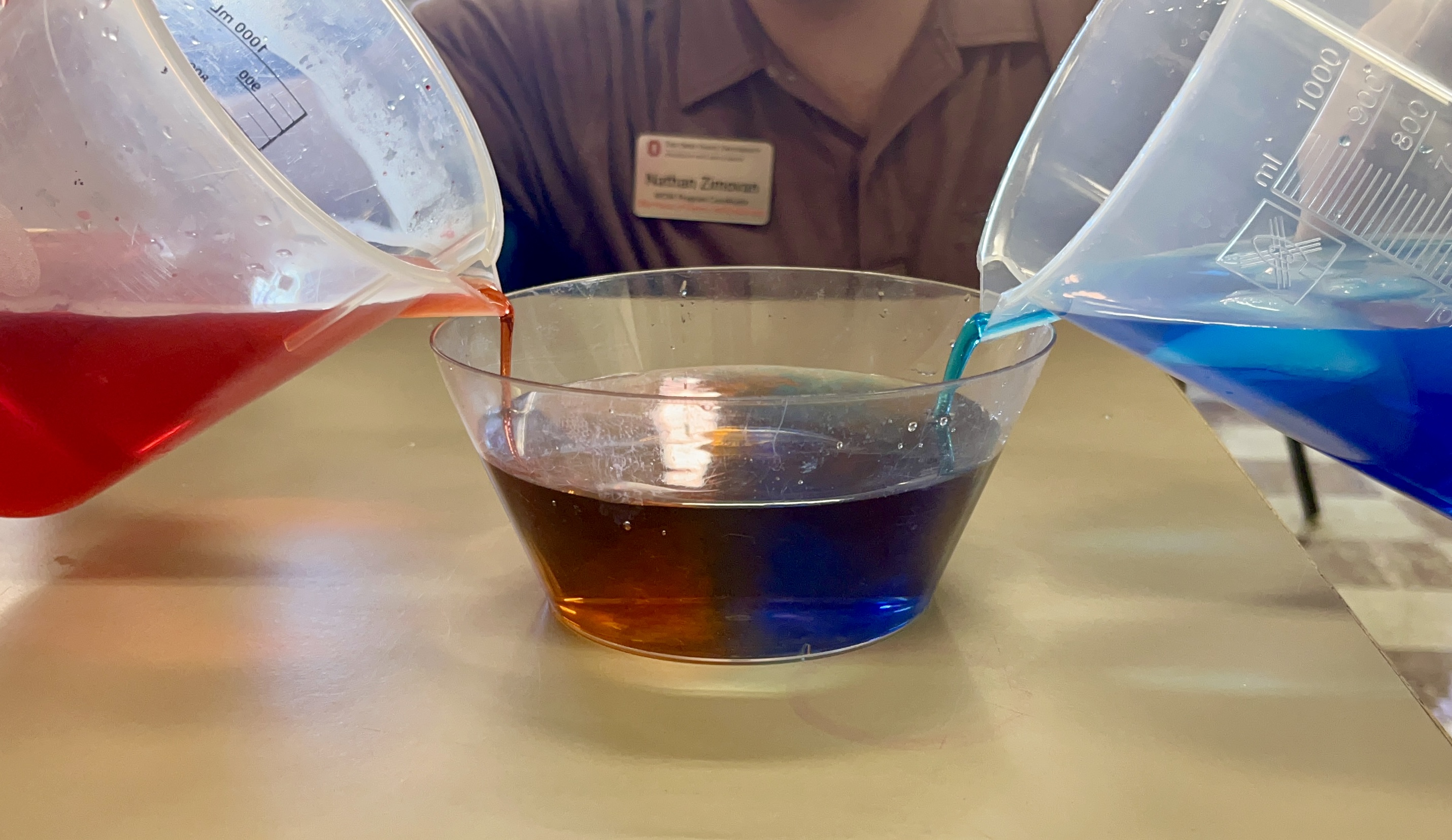
Weather Fronts (Grades K-5; demonstration to take place before/after the program)
Students will learn the different kinds of weather fronts and what causes those weather fronts. We will demonstrate the phenomenon of humidity by using a clear container split with water and add food coloring to mix hot (red) and cold (blue) fluids. This will allow us to see how the cold and hot weather mix and interact together.
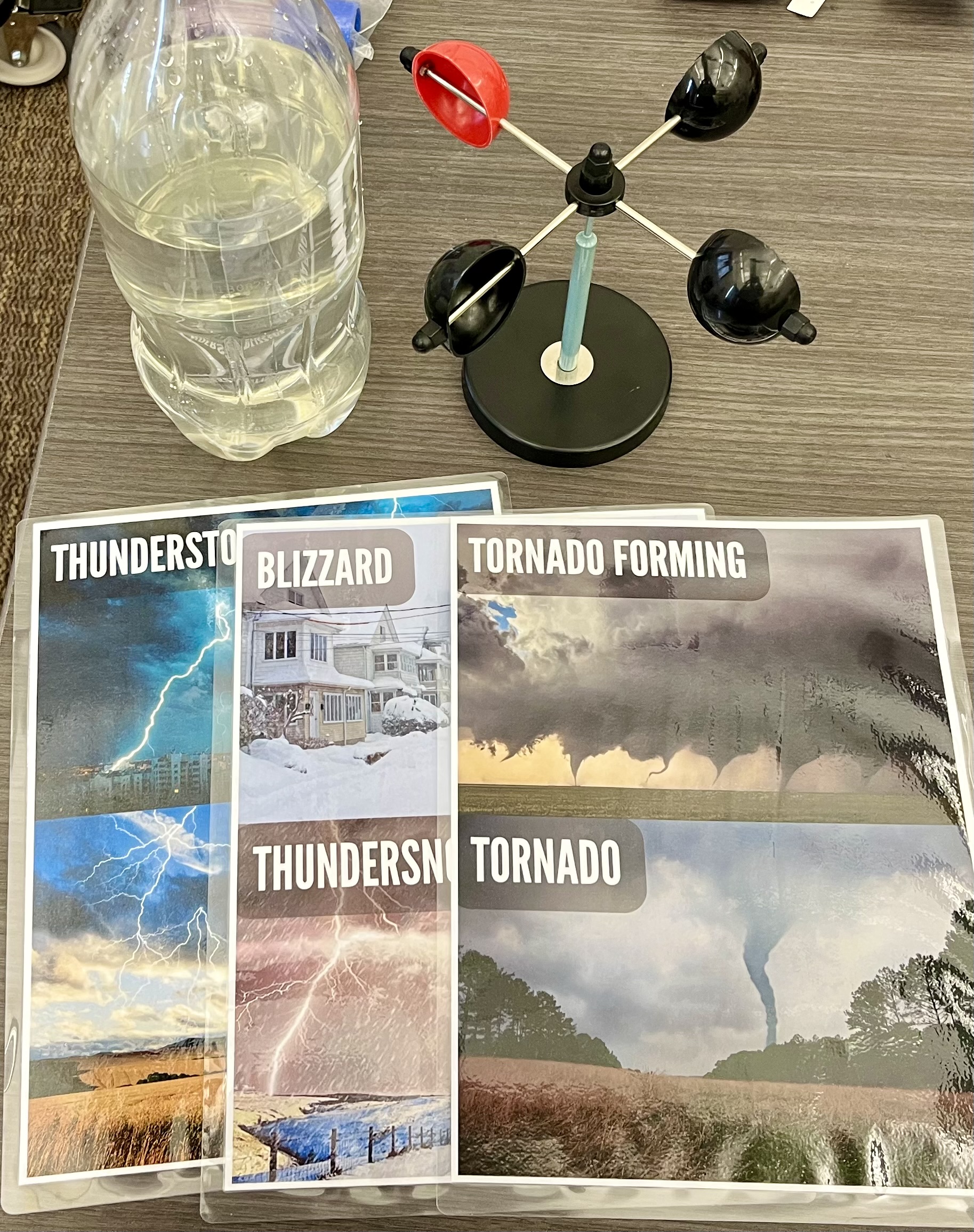
Wind and Severe Weather (Grades K-5; 5-8 minutes)
Students will discover how winds are created by understanding the differences in air pressure. Warm air weighs less than cold air and warm air rises. When these two different temperatures interact it can create a swirl like motion. i.e. tornados. In this experiment, students will use an anemometer with half circles attached to help see the wind motion. Then they will use two, 2-Liter bottles that will be attached to each other and mixed with water. Students will be able to swirl the water around inside the tube and see the swirling effect that will look like a tornado.
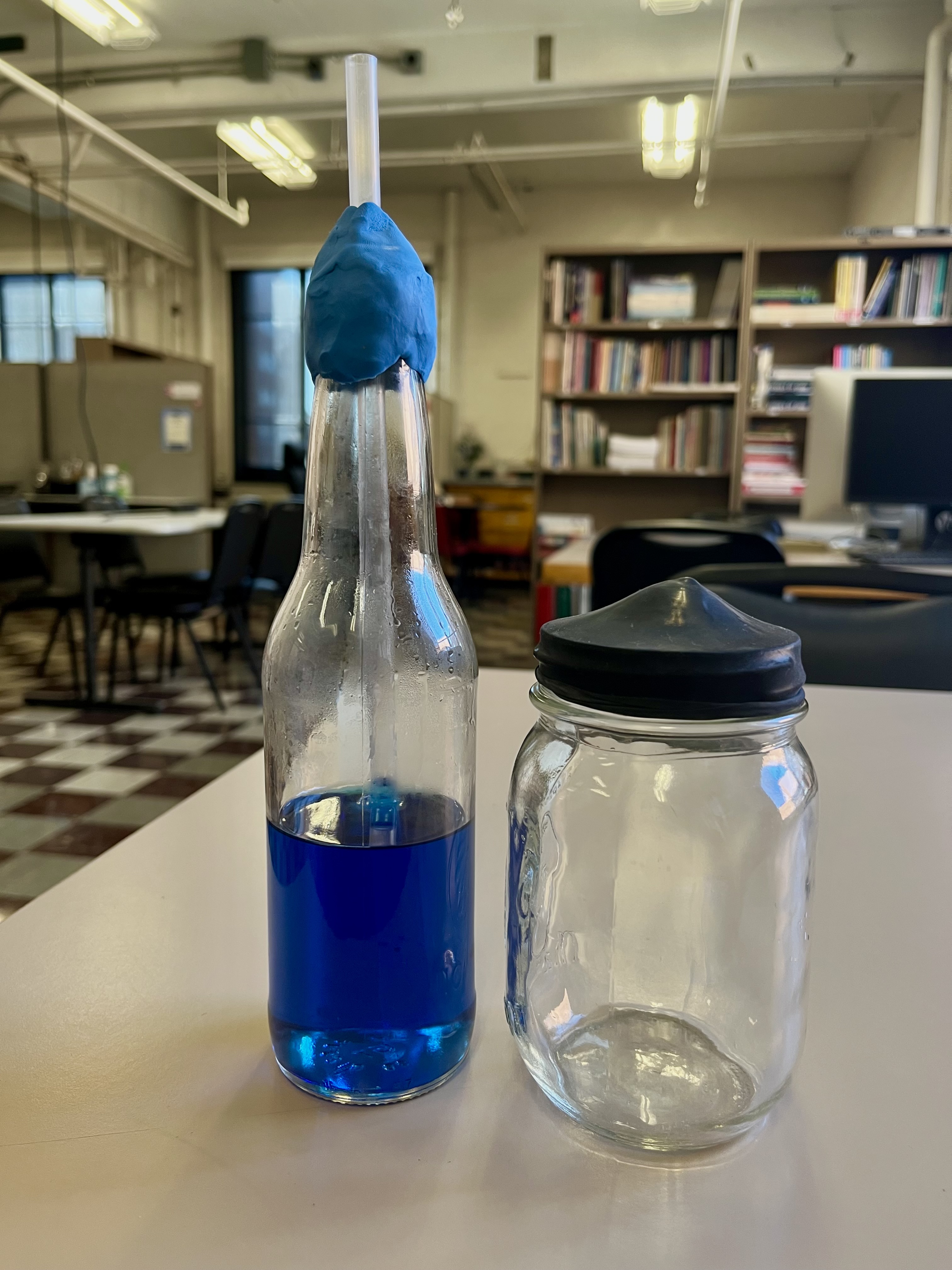
Tools to Measure Weather (Grades K-5; 5-8 minutes)
In this experiment, students will observe the changes a homemade thermometer undergoes when exposed to various temperatures. Students will be able to compare the thermometer’s behavior in these various temperatures and relate its behavior to how changes in temperature affect the expansion or contraction of liquids and gases. Students should conclude that increasing temperatures of the surroundings causes materials to expand, and decreasing temperatures causes materials to contract.
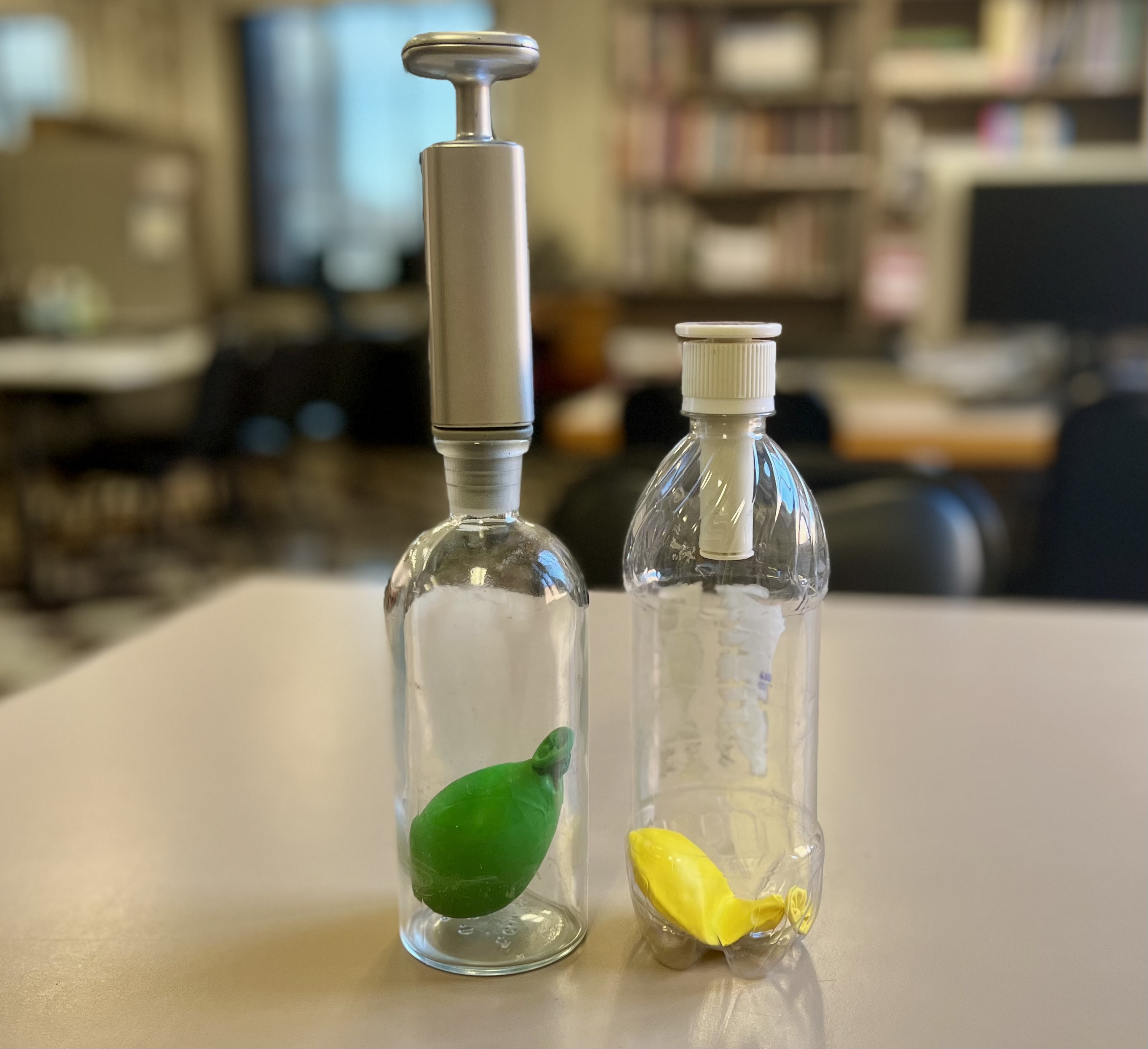
Air Pressure and Temperature (Grades K-5; 5-8 minutes)
In this activity, we will explore air pressure, density, and weight in a sealed container. This activity will show that the expansion or compression of a gas actually changes its temperature.
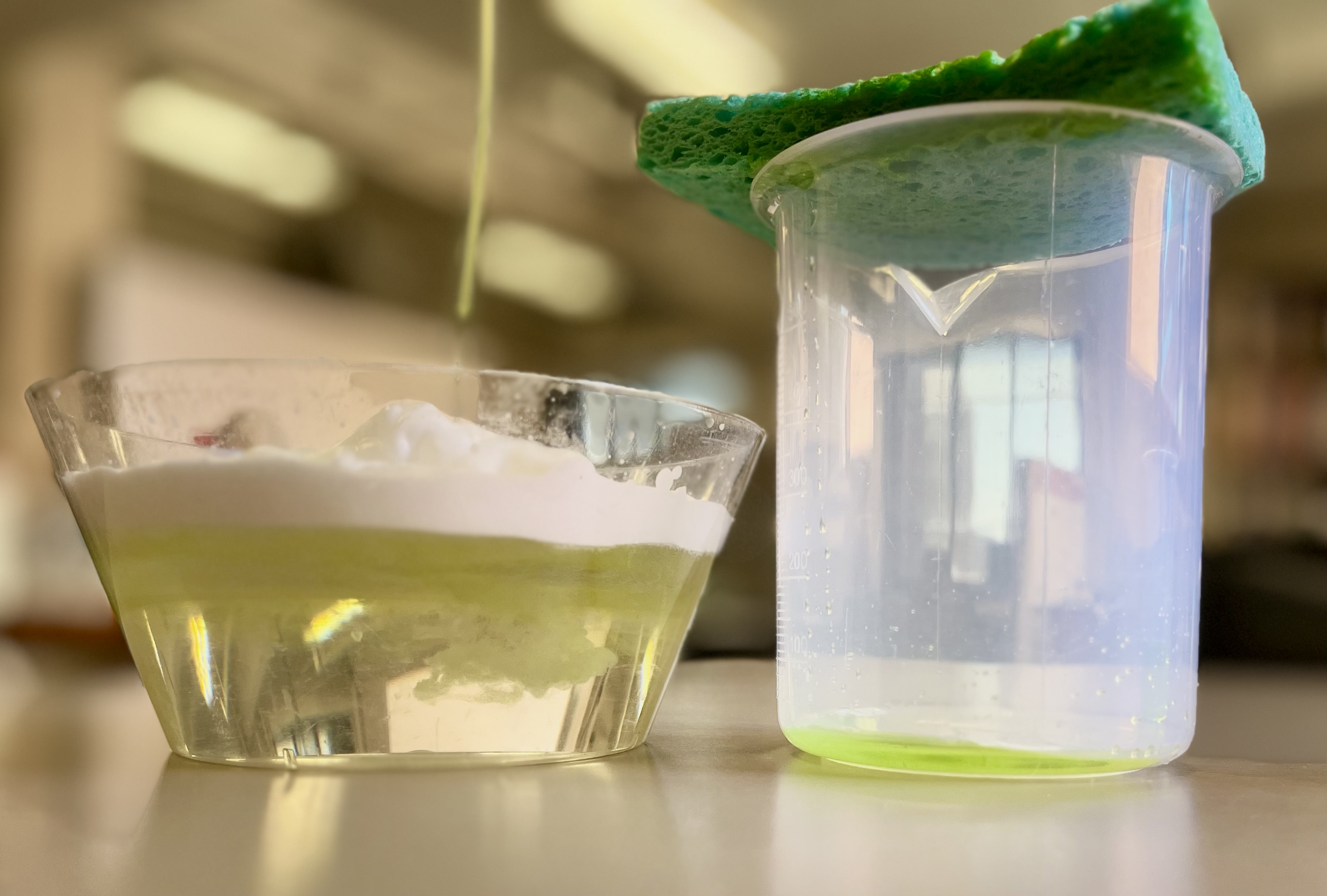
Rain Clouds (Grades K-5; 5-8 minutes)
The amount of water on the earth does not change with time – it cycles from the ocean to the atmosphere and then descends back to landmasses in the form of rain. This experiment focuses on the three most simple and often seen parts of the water cycle: evaporation, condensation, and precipitation.
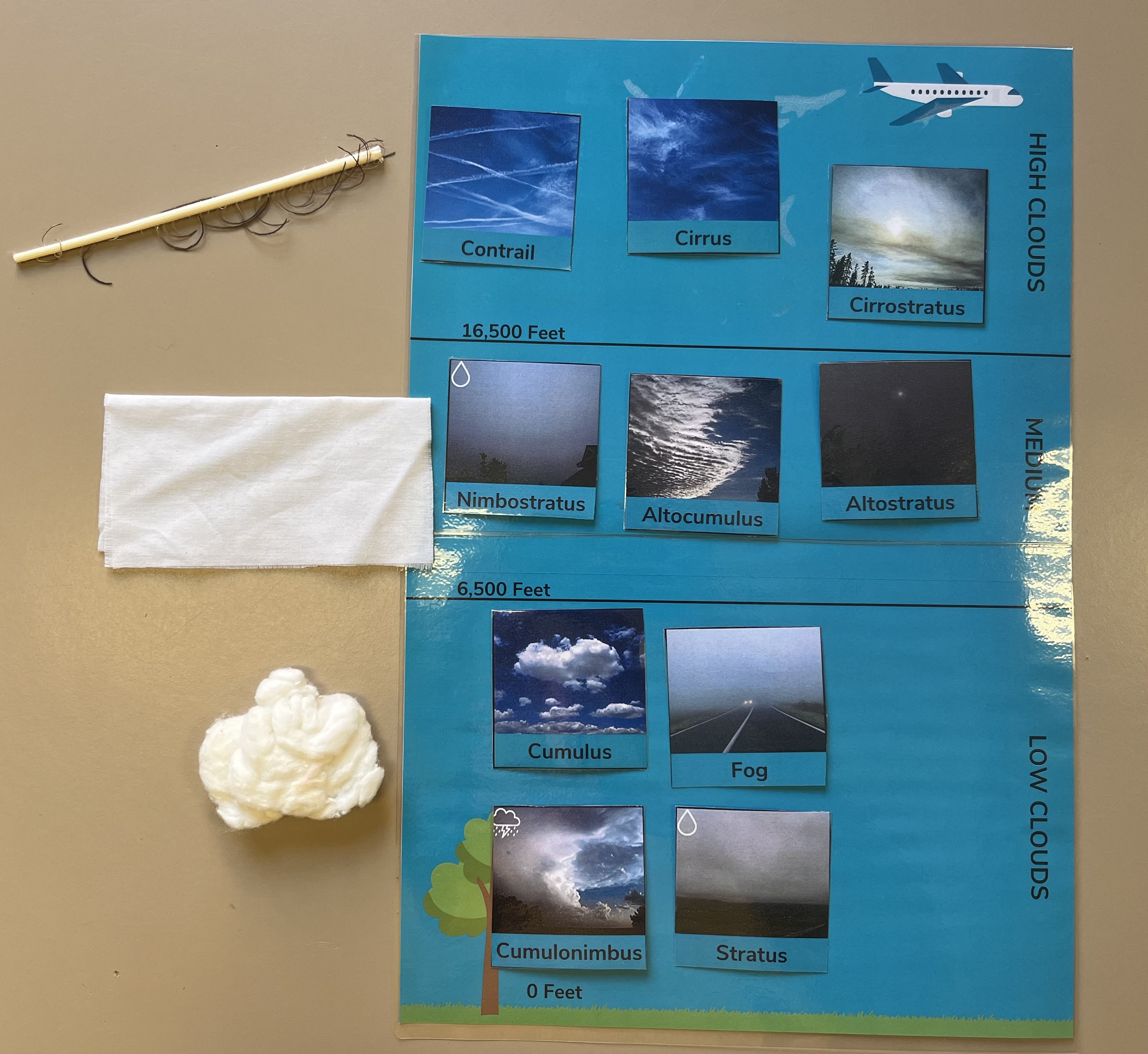
Cloud ID (Grades K-5; 5-8 minutes)
In this activity, students will be able to identify cloud types using standard cloud classification names. To help students understand these different types of clouds, we will use different materials like cotton balls, cloth, and a feather. There will also be images to go along with each description to help for better understanding.
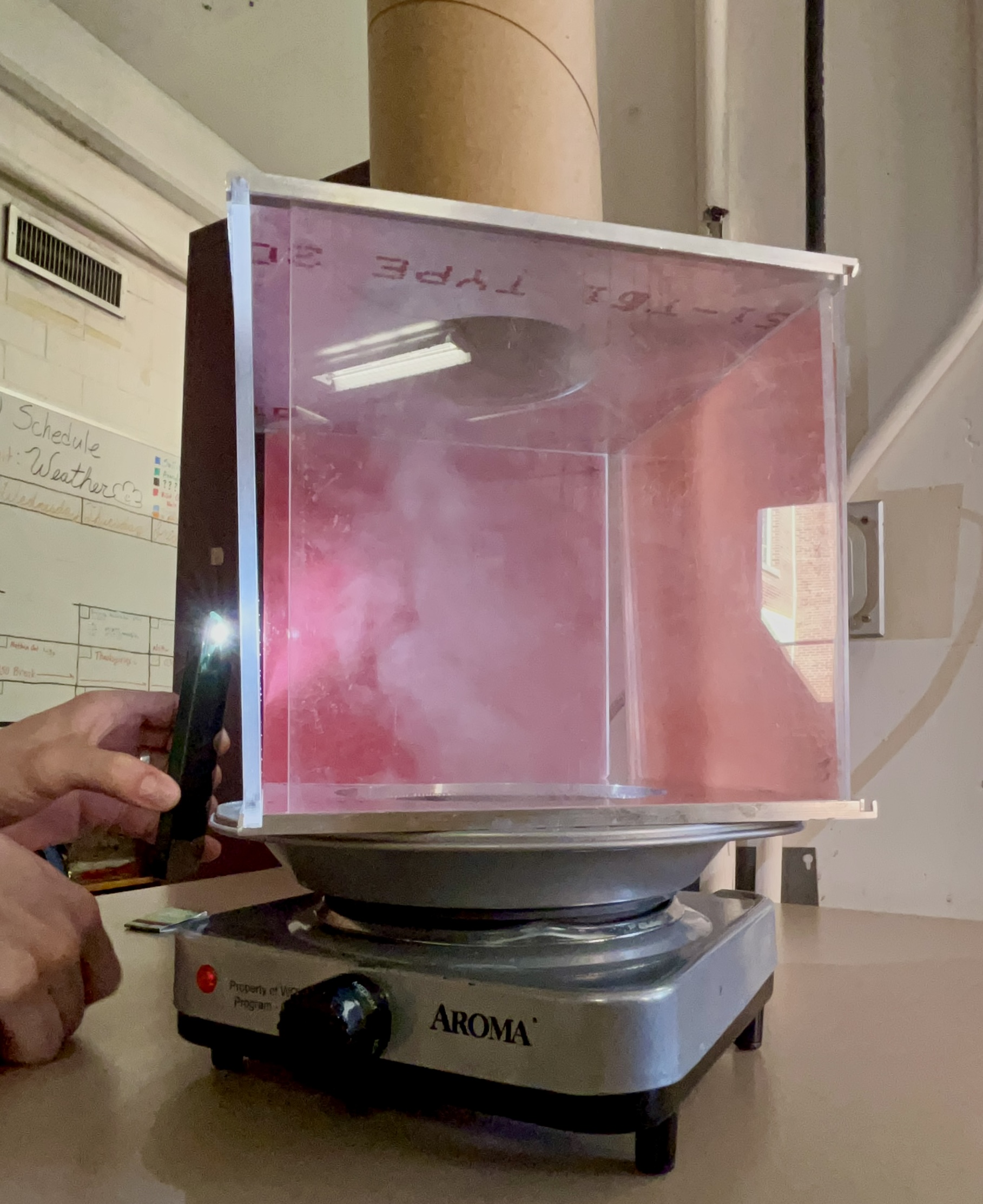
Tornado in a Box (K-5; 5-8 minutes)
This experiment/demo will be used as a more intensive display of tornadoes/hurricanes than what can be viewed in the Wind and Severe Weather experiment.

